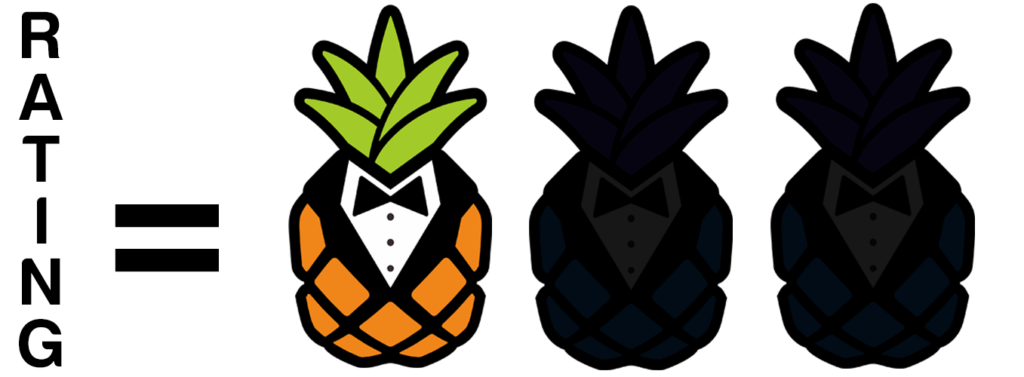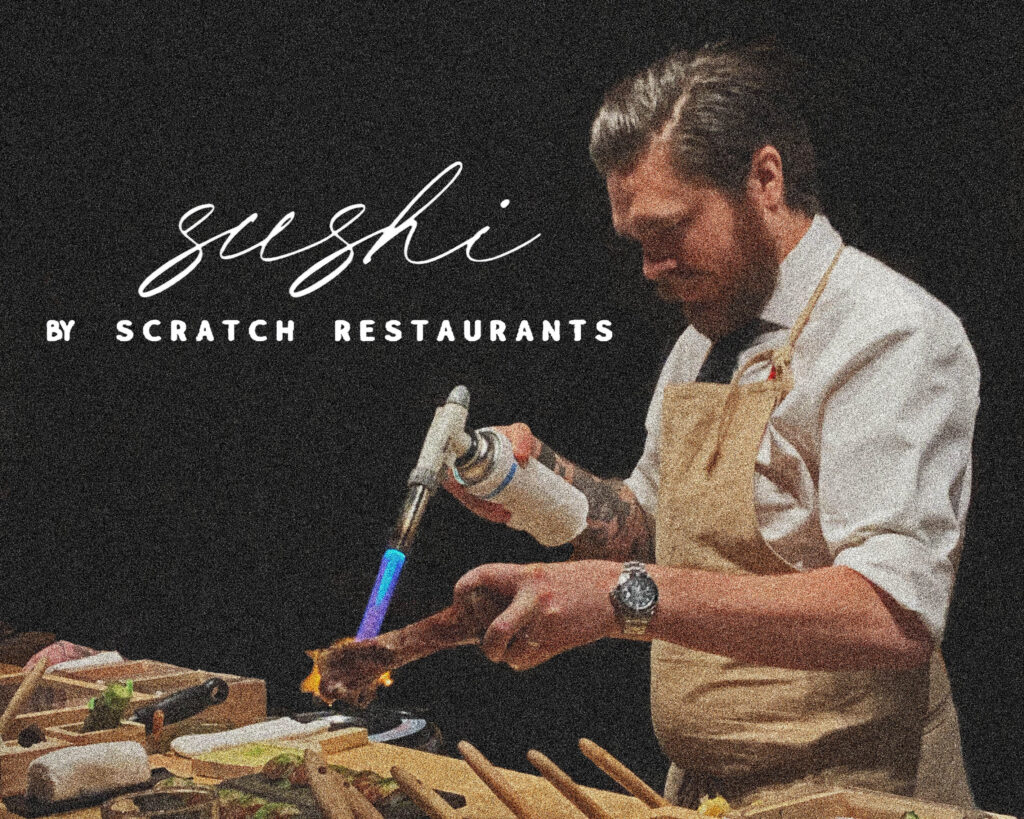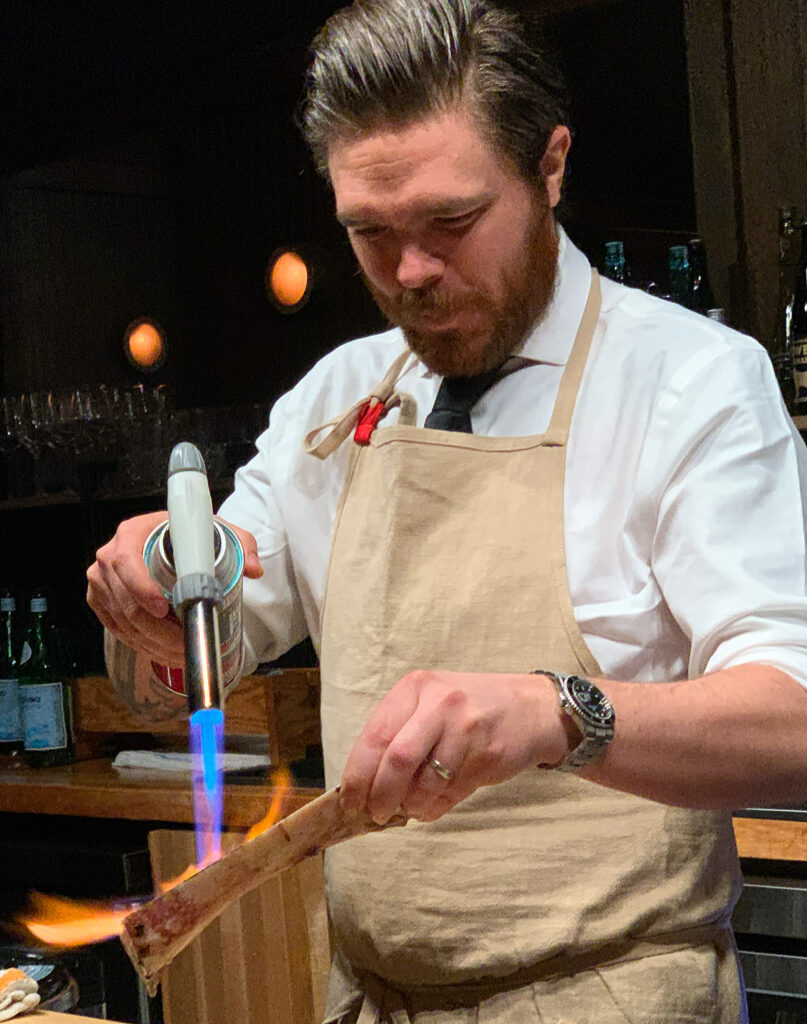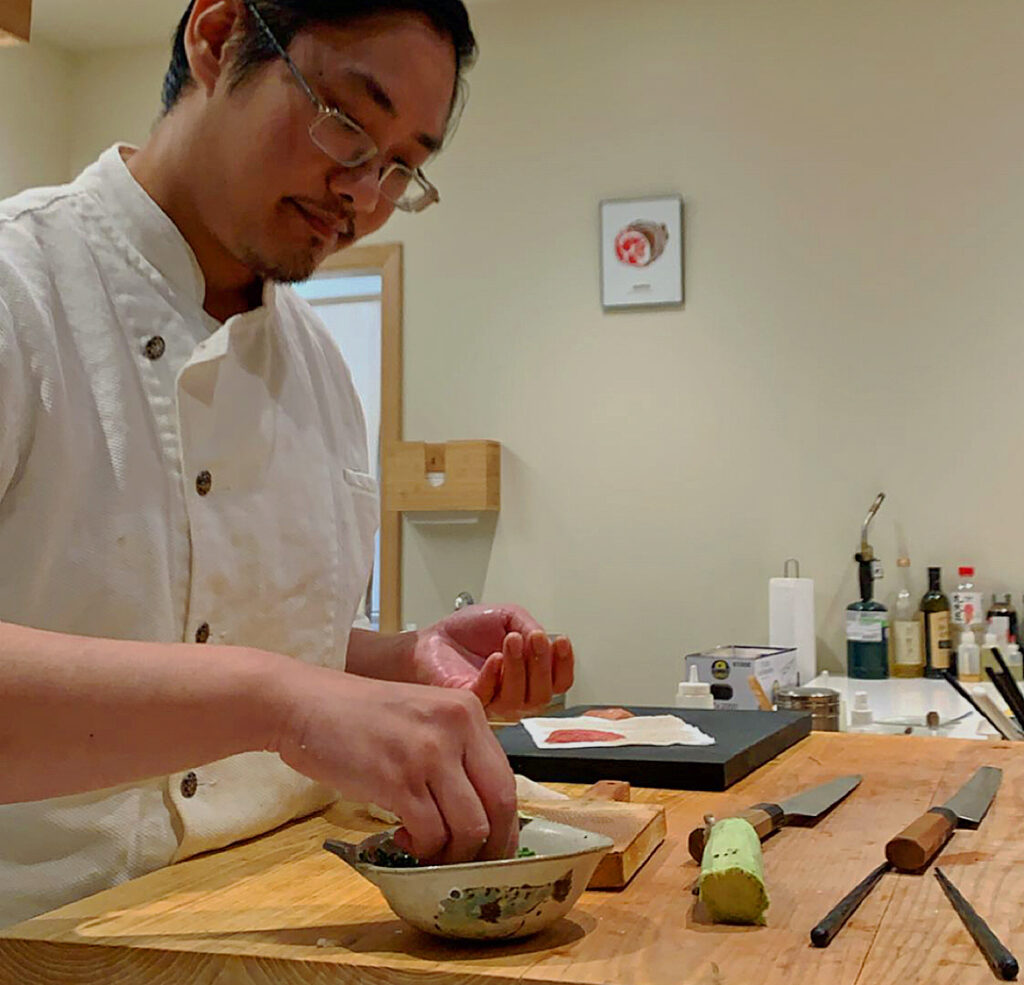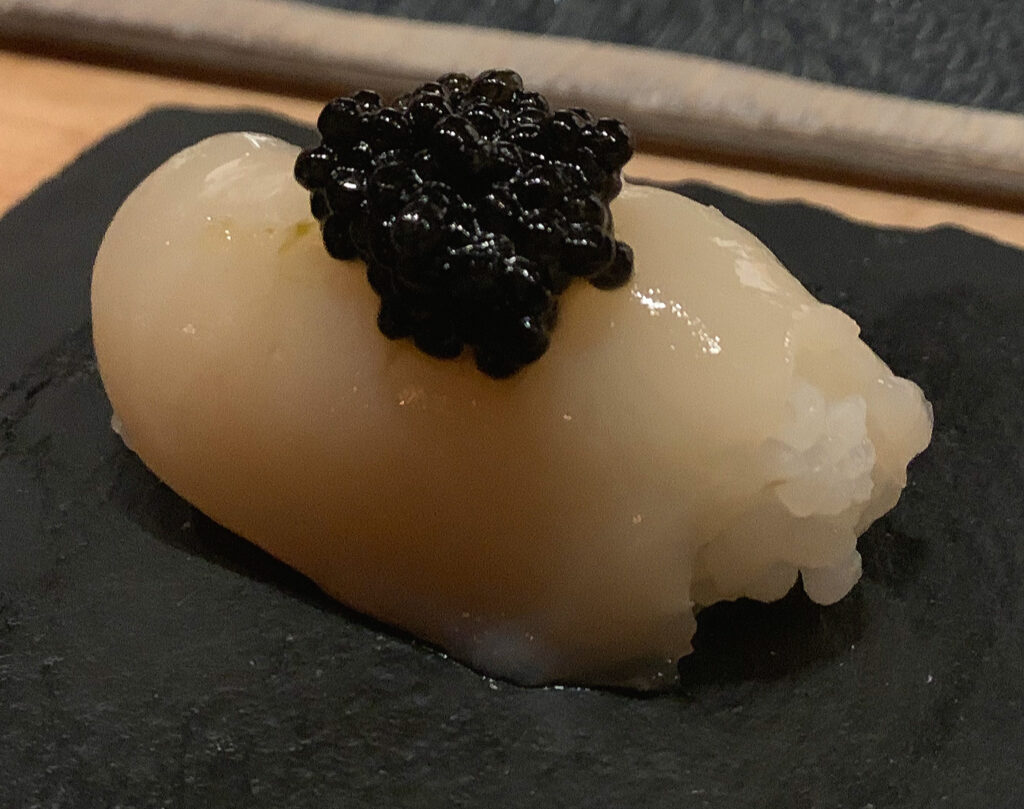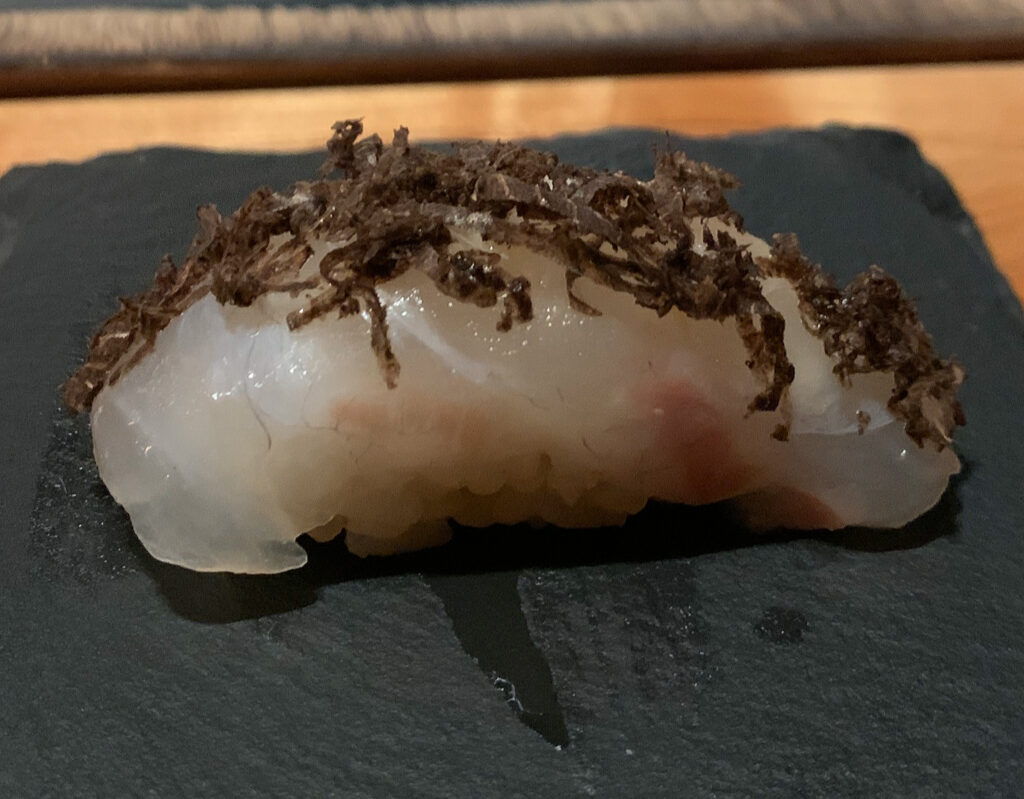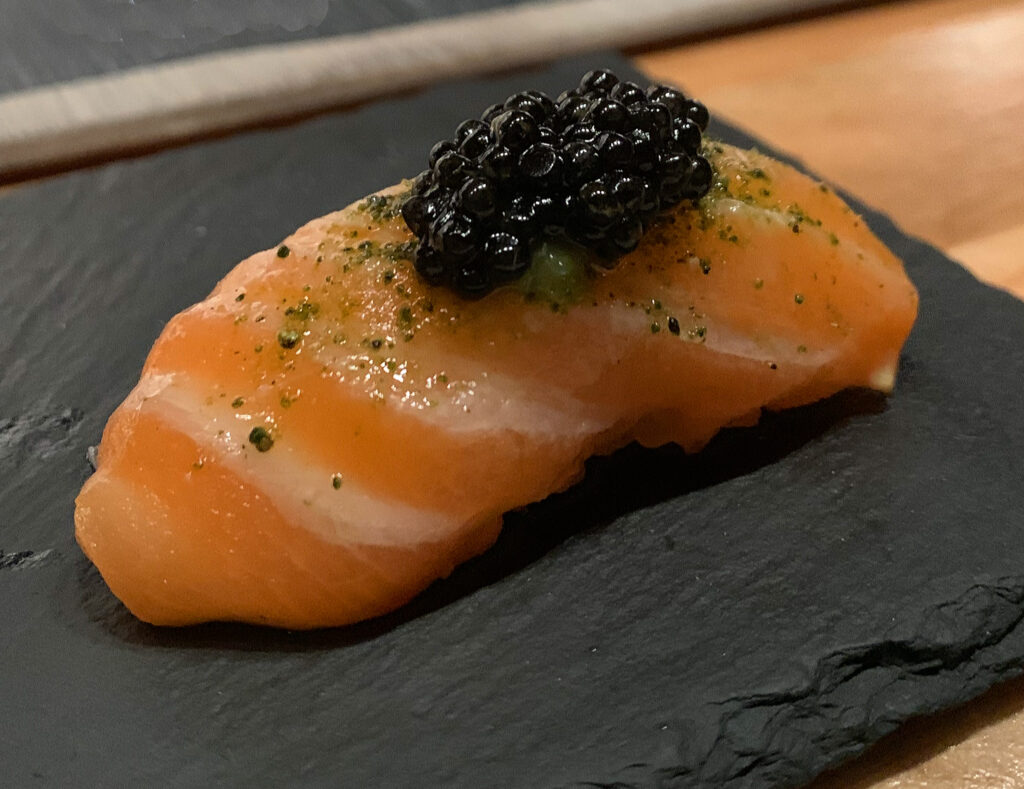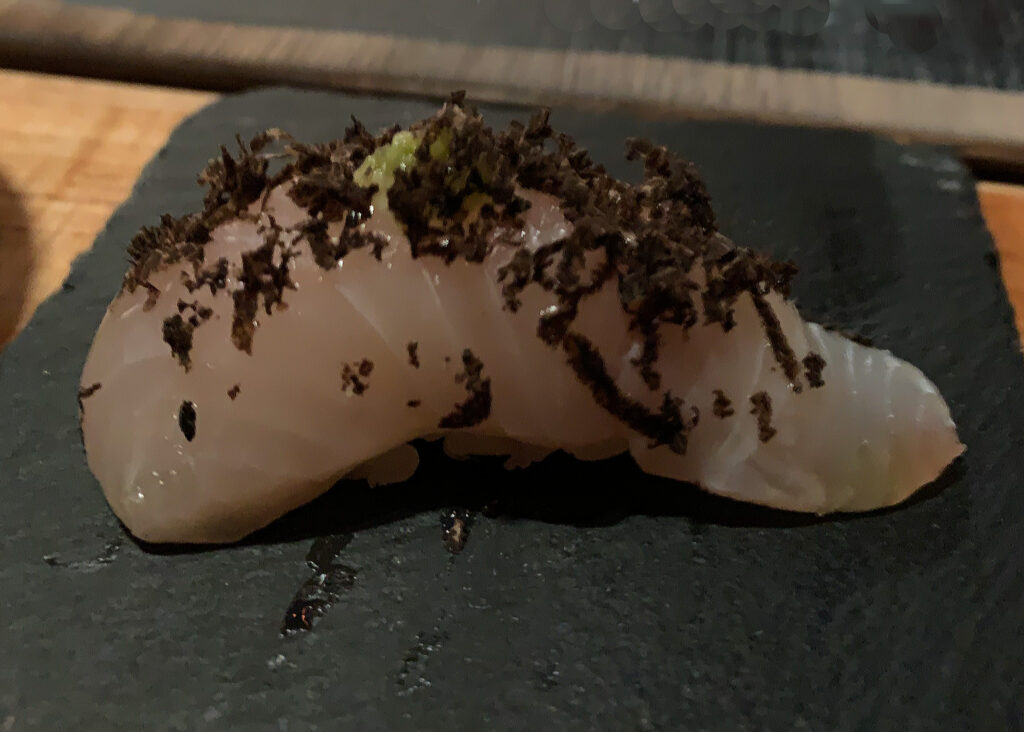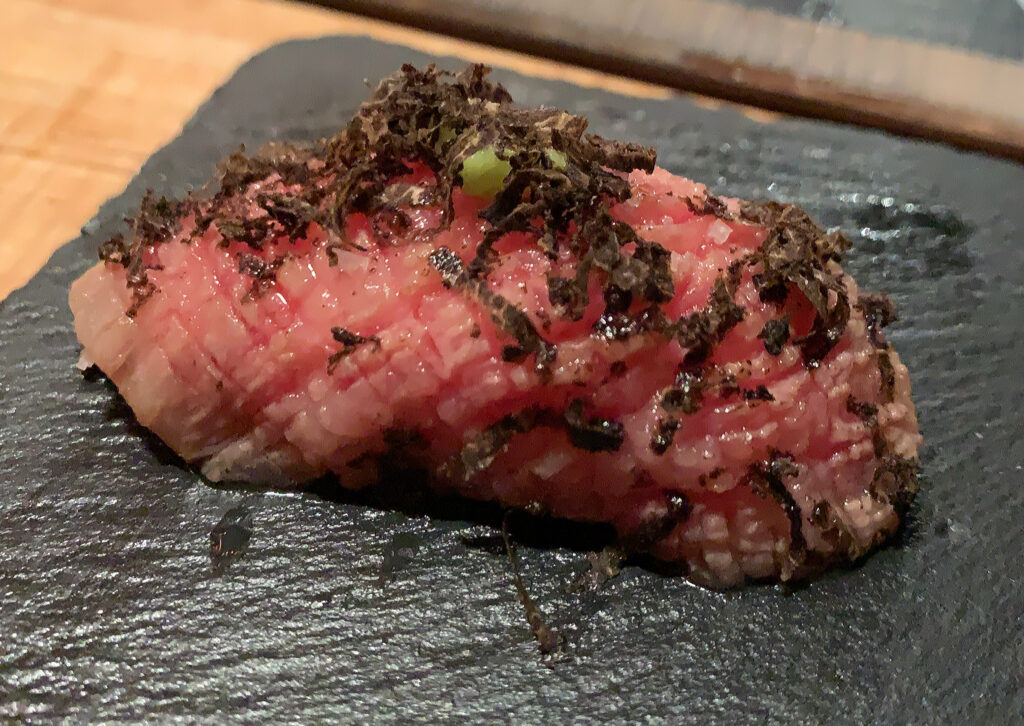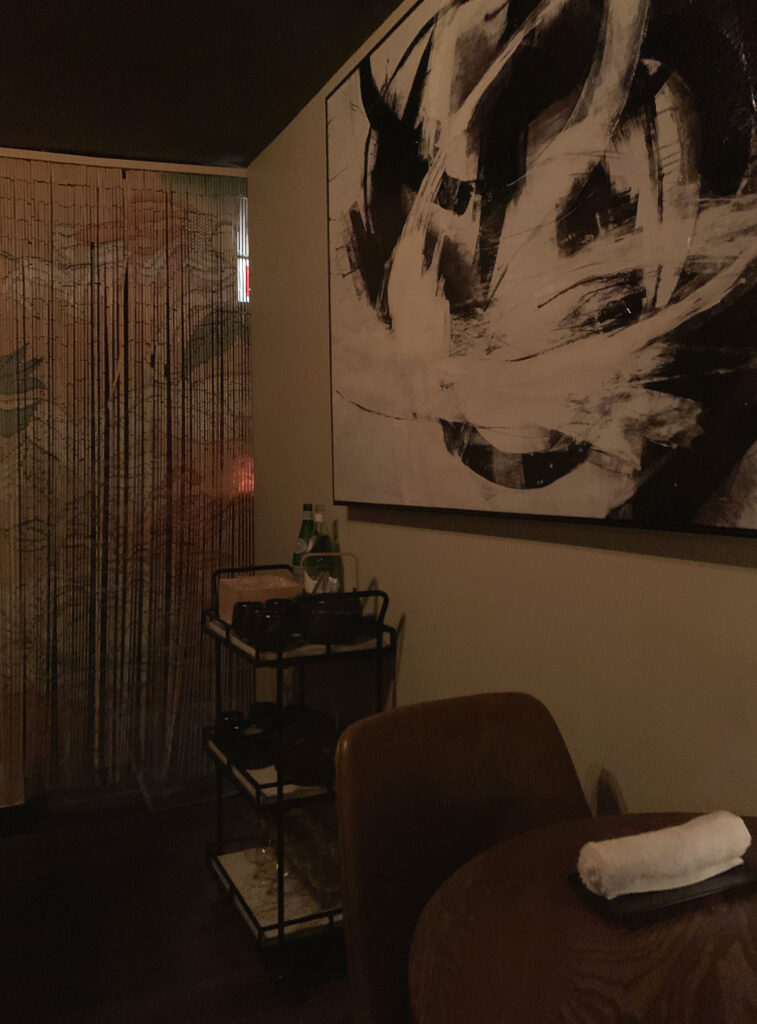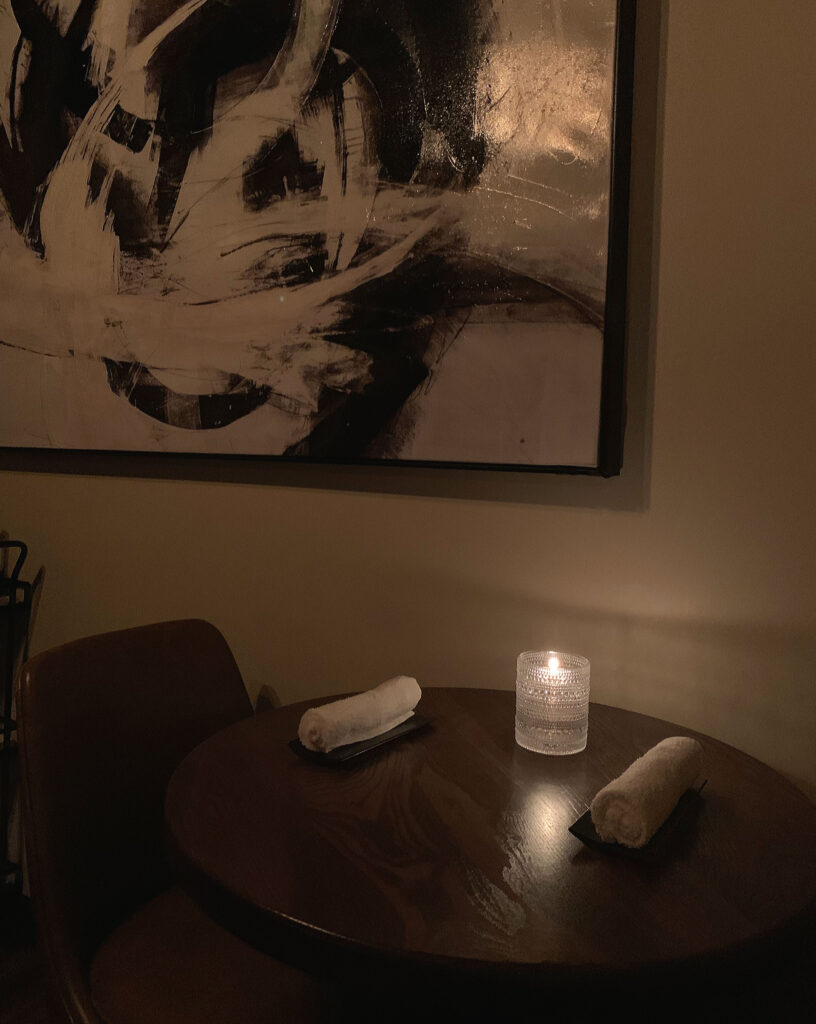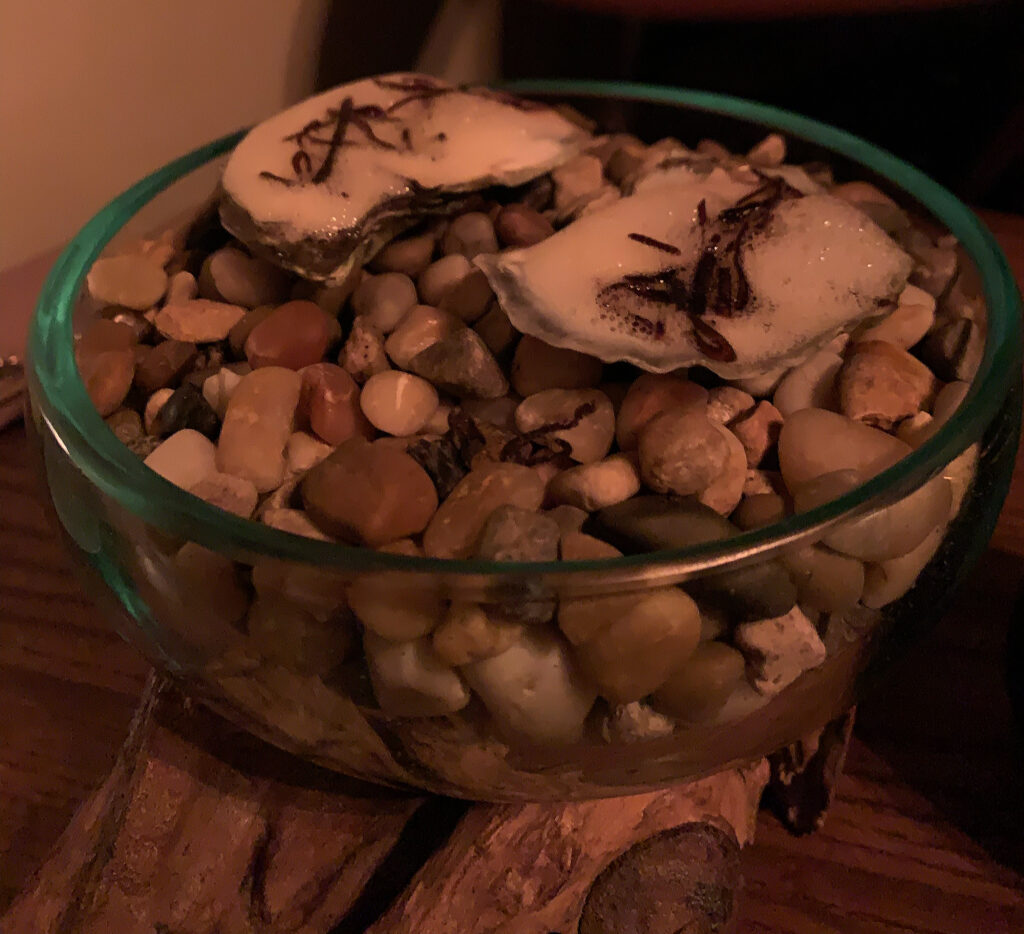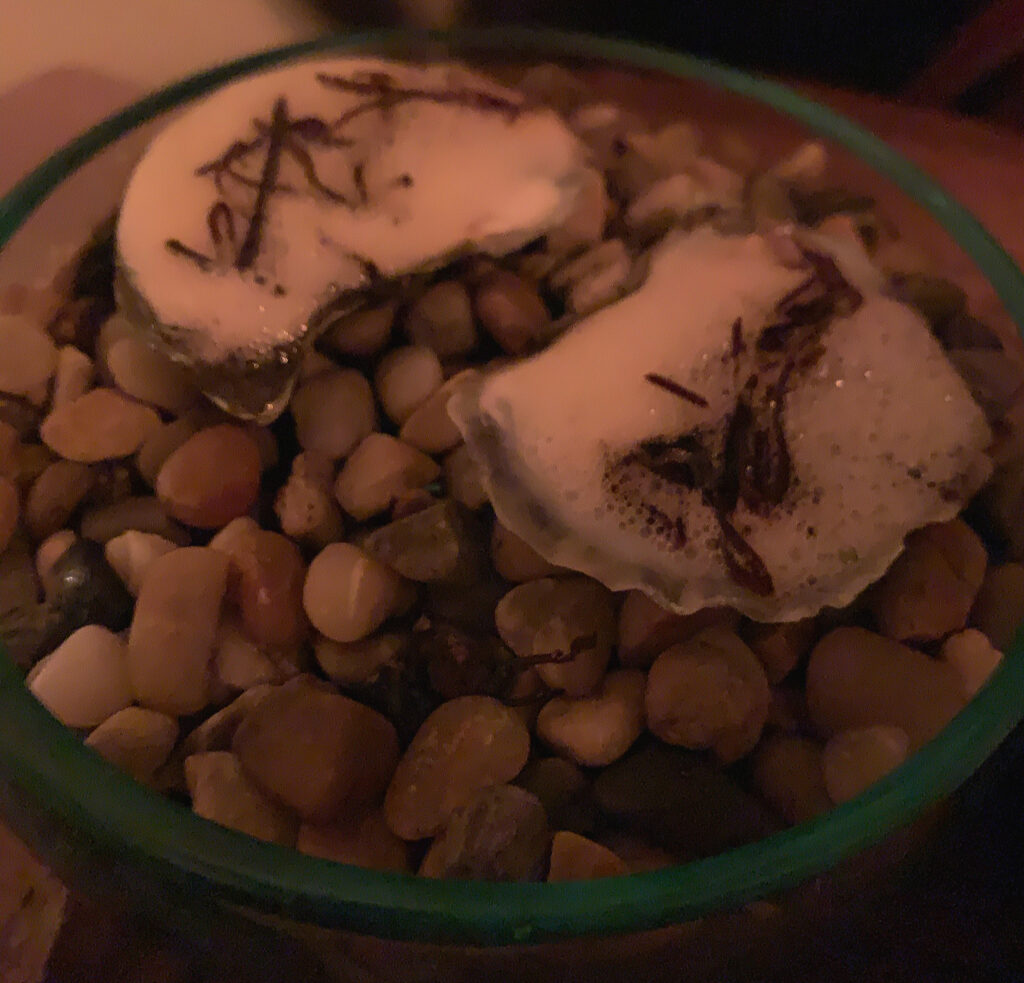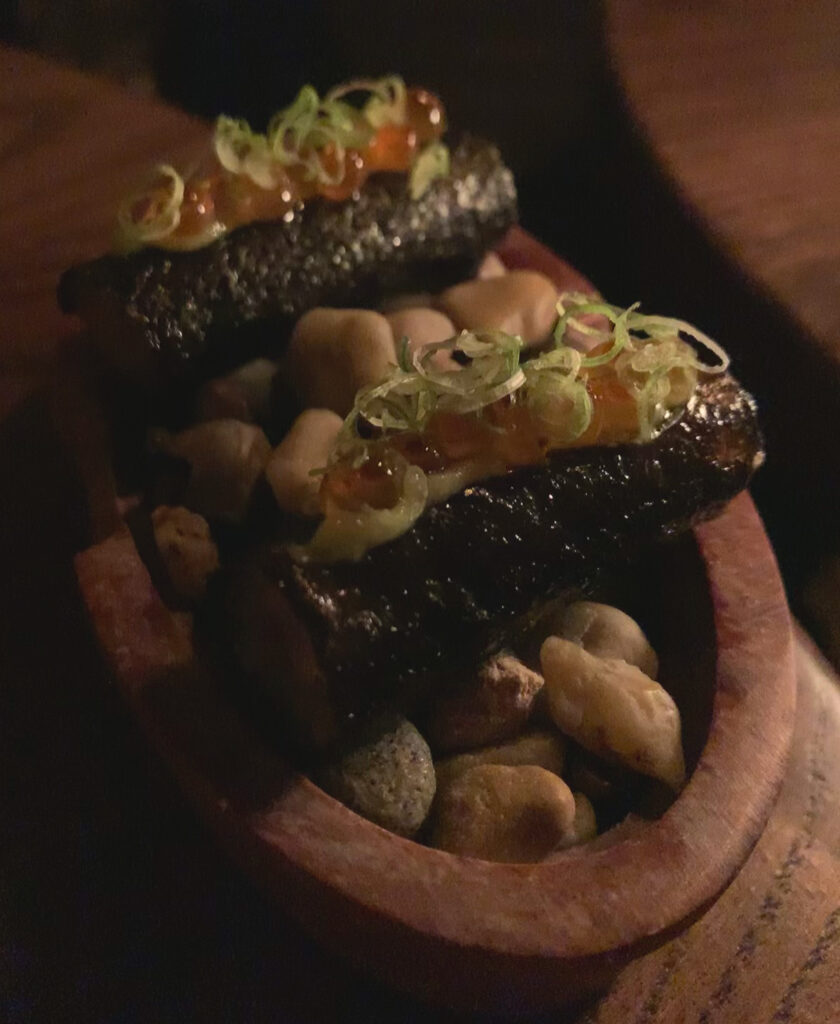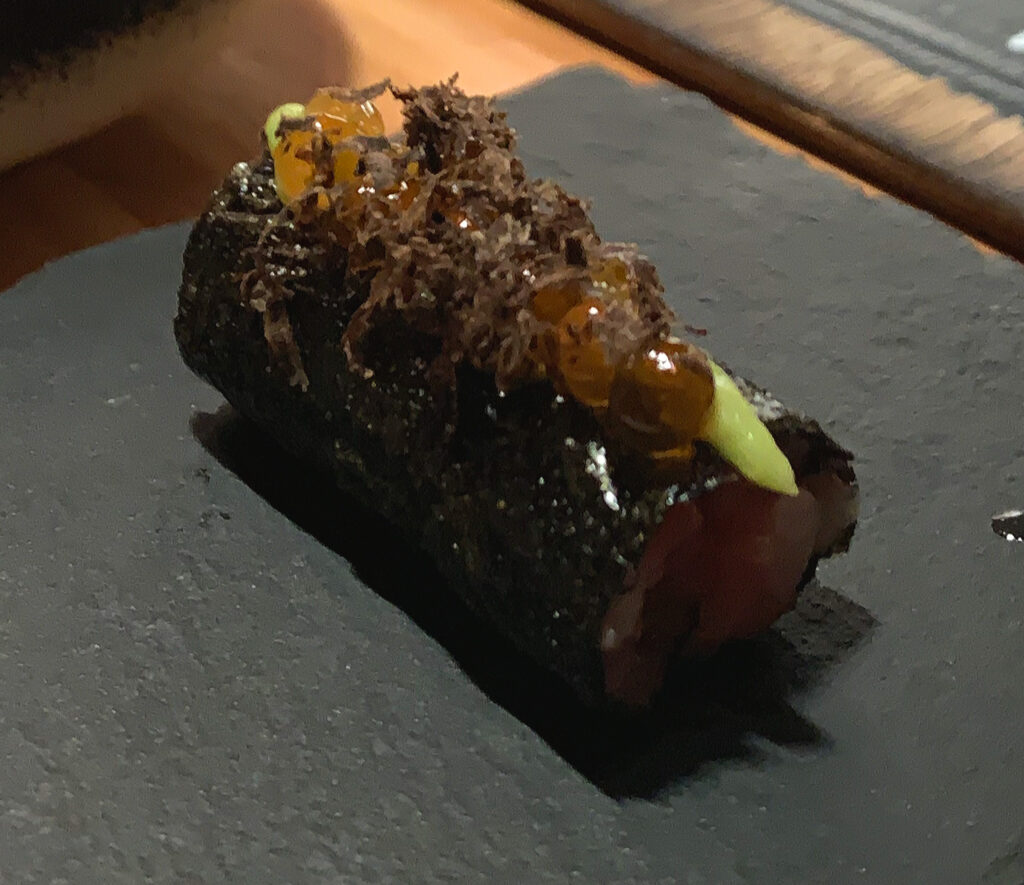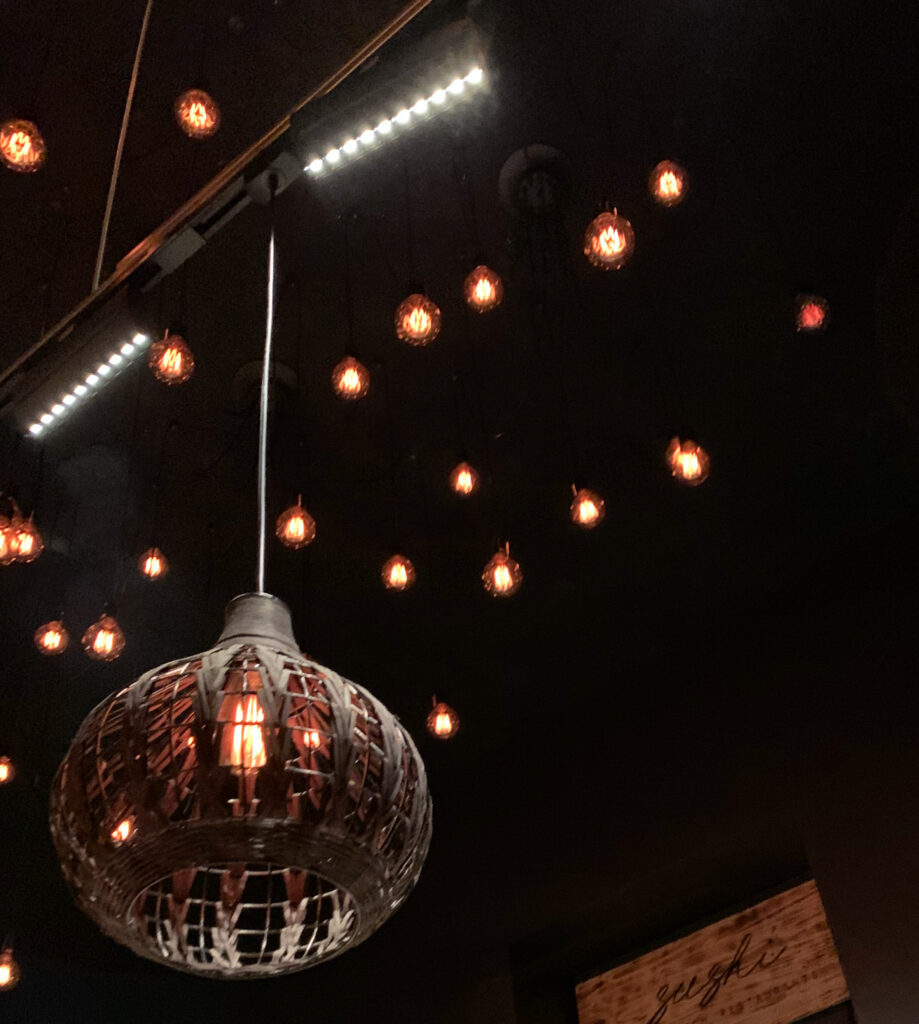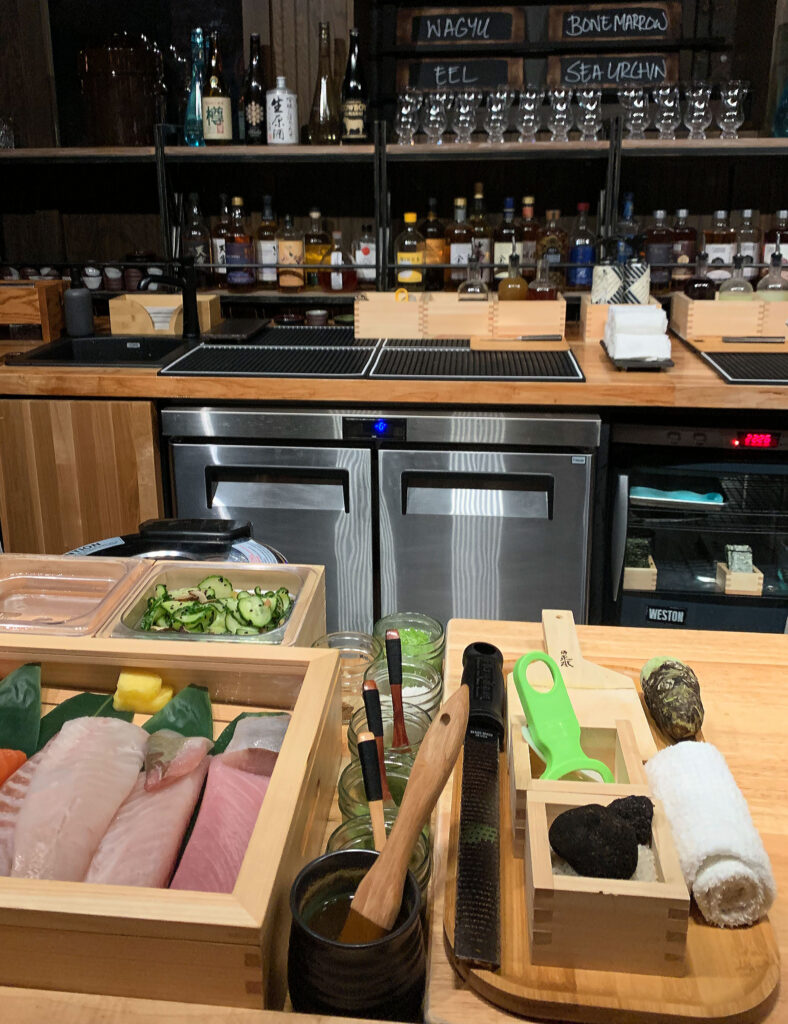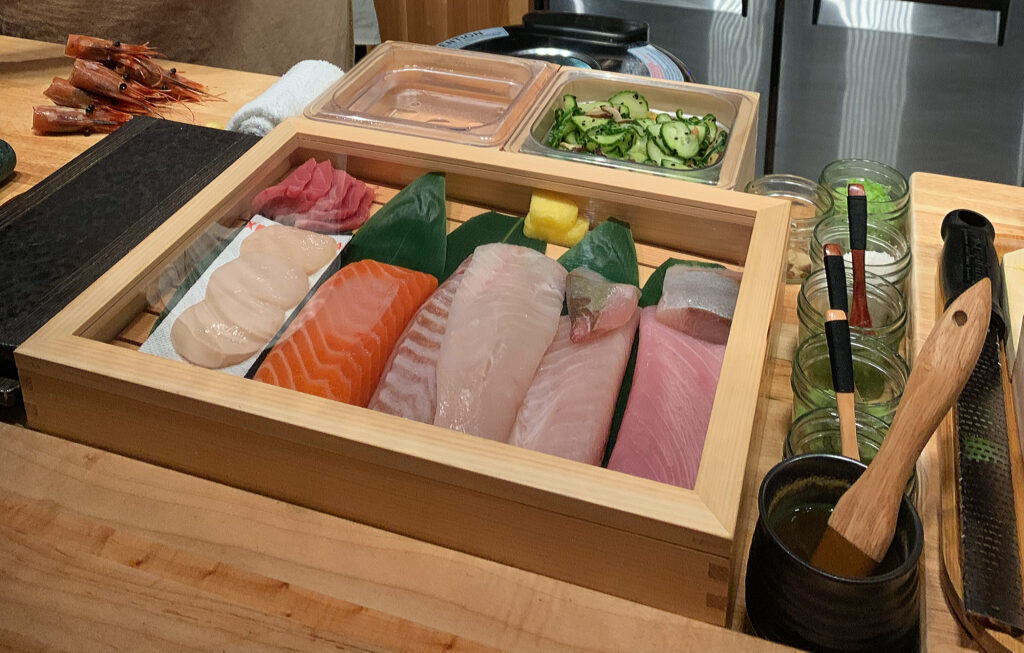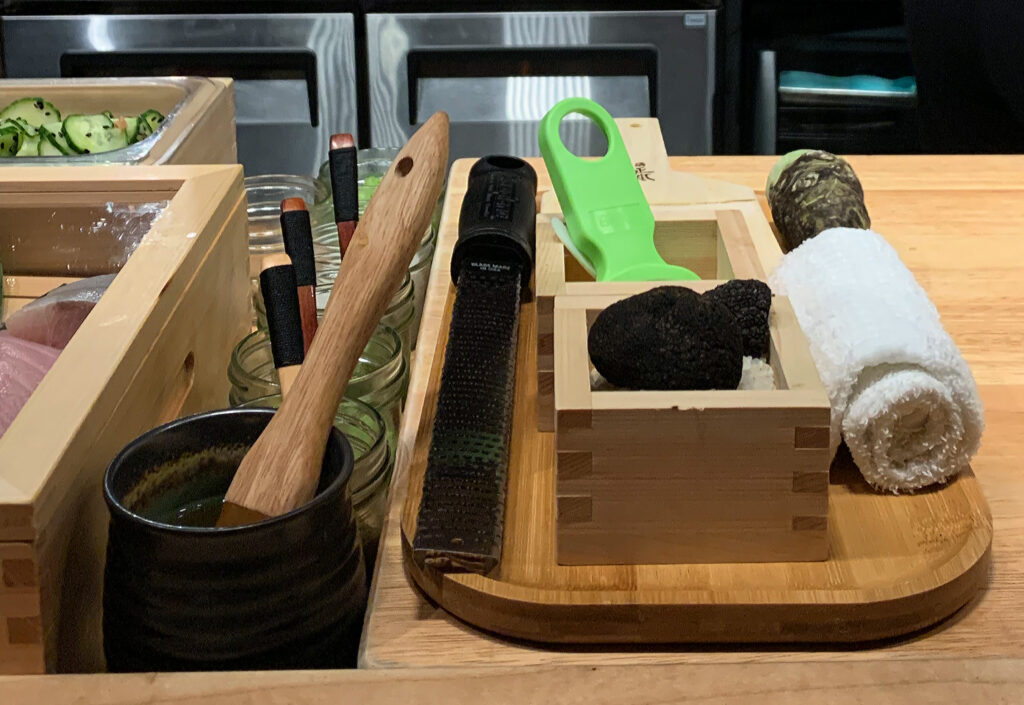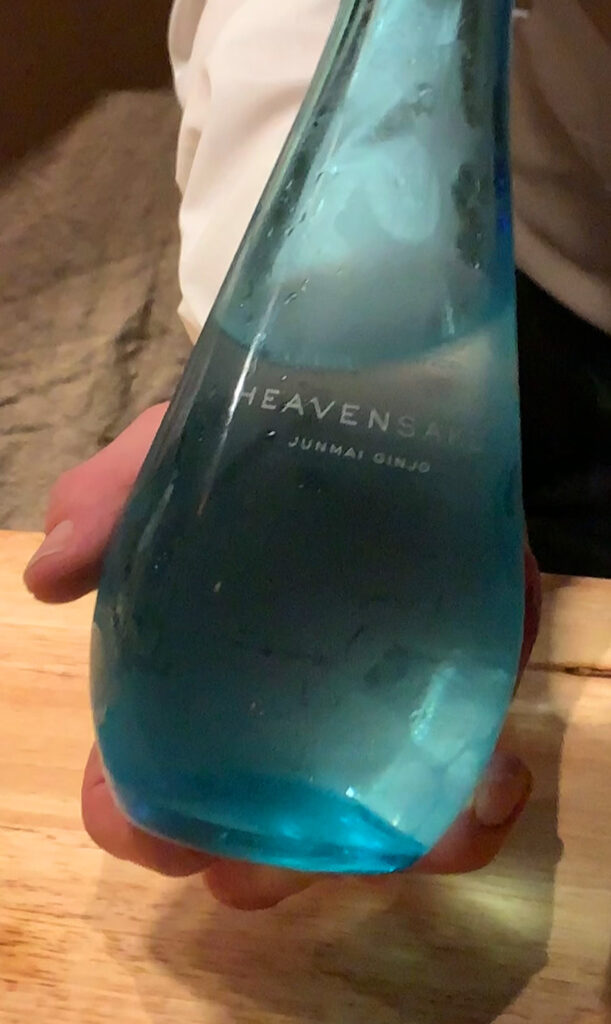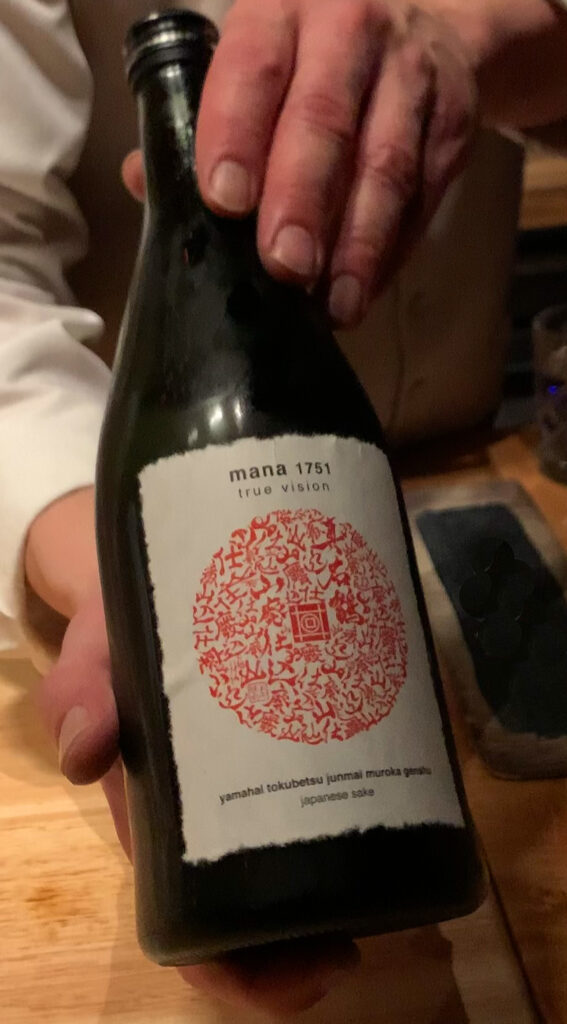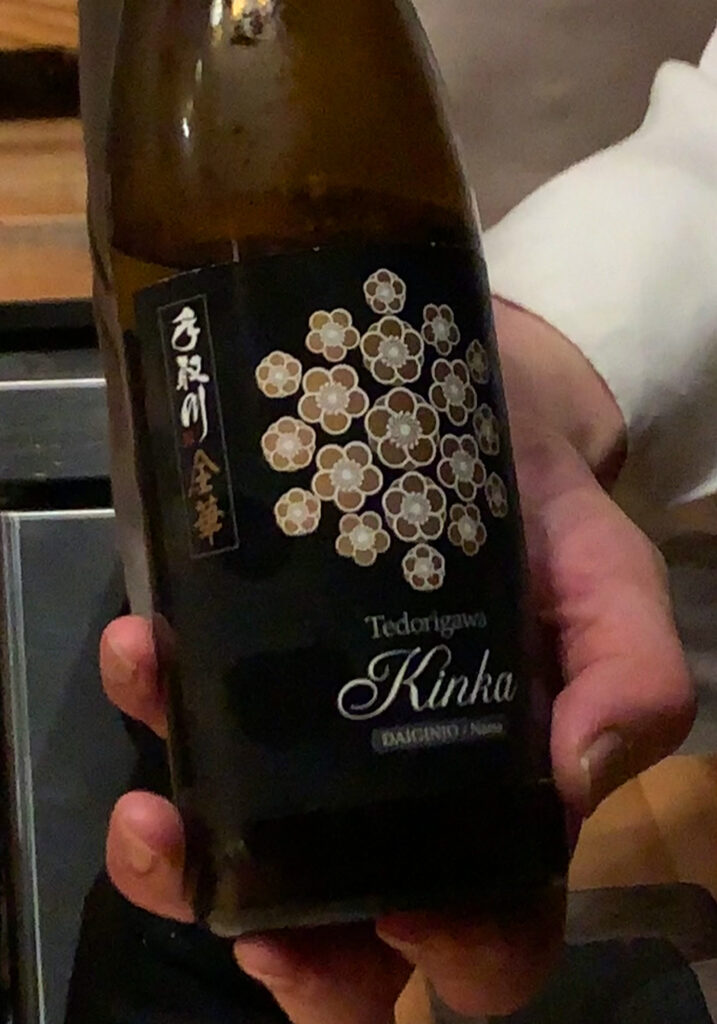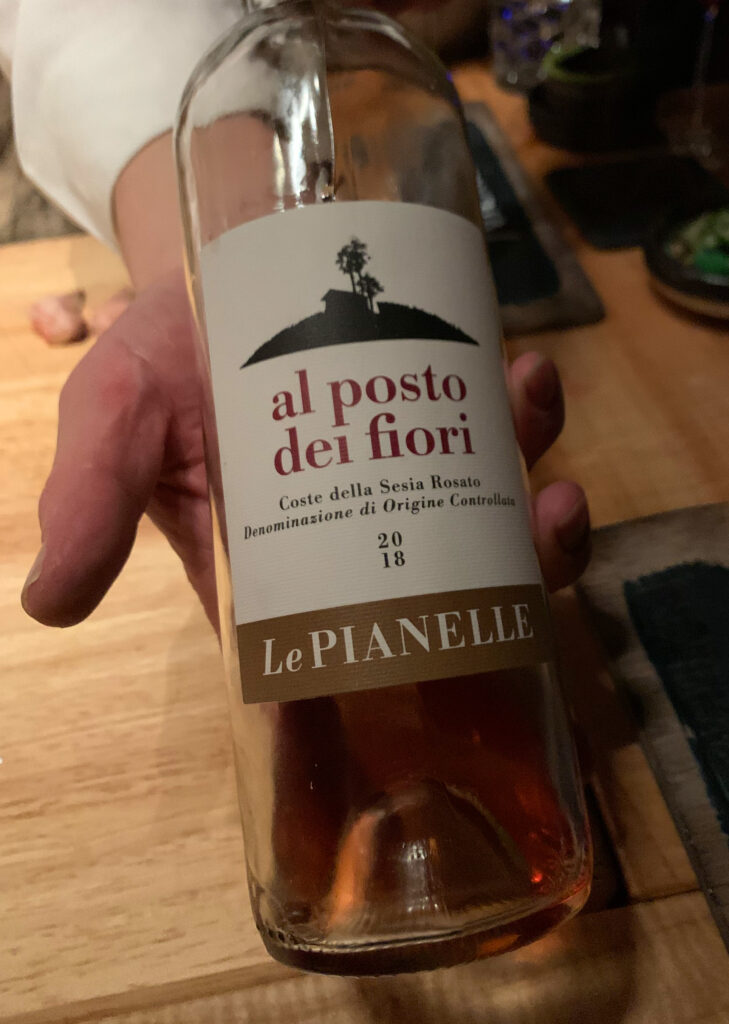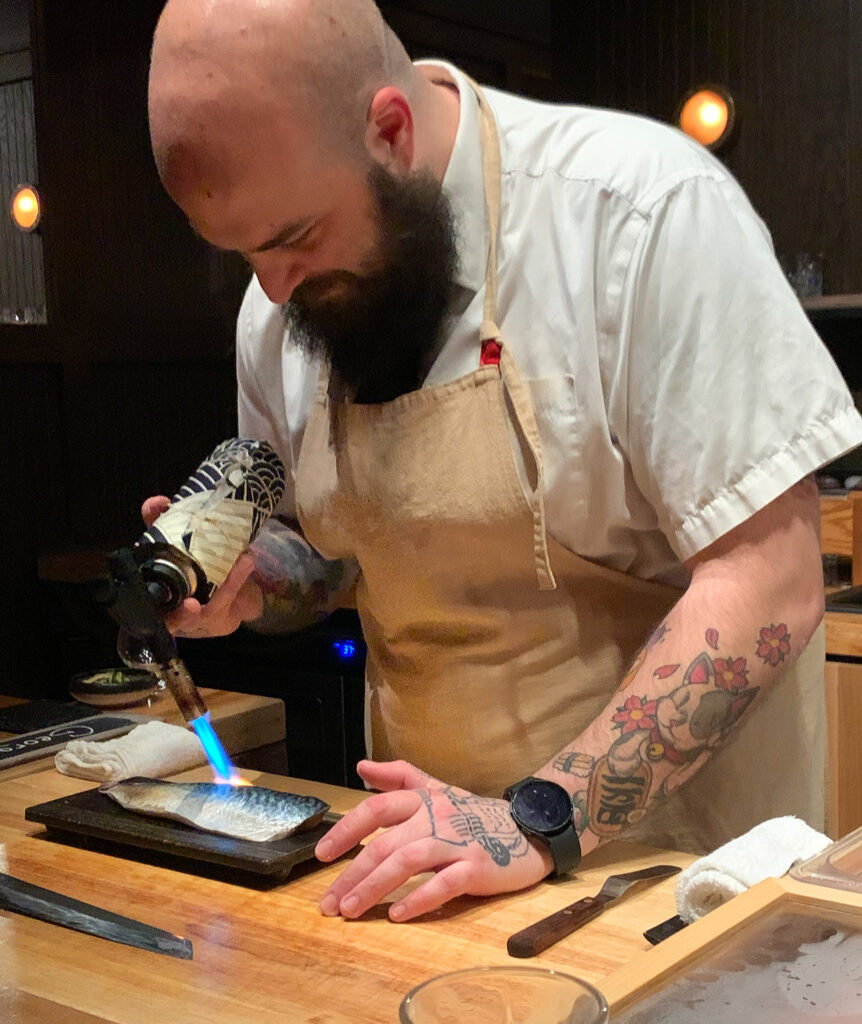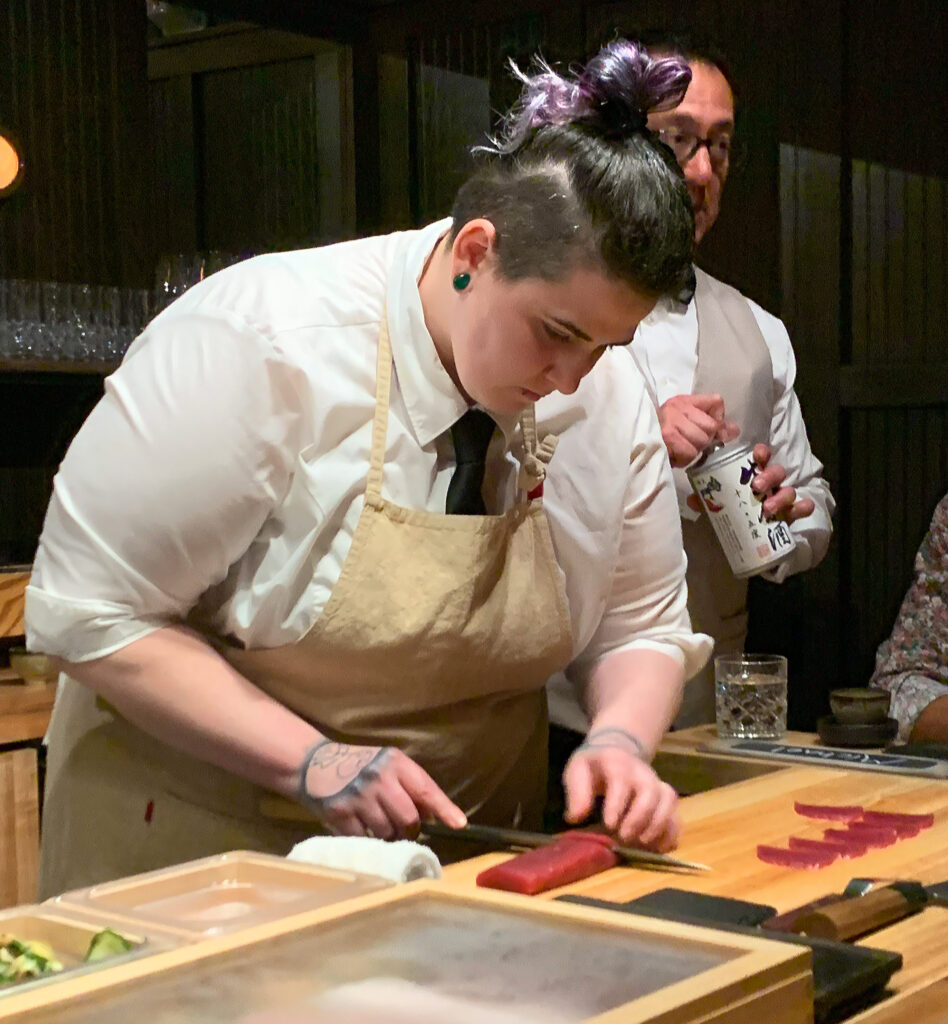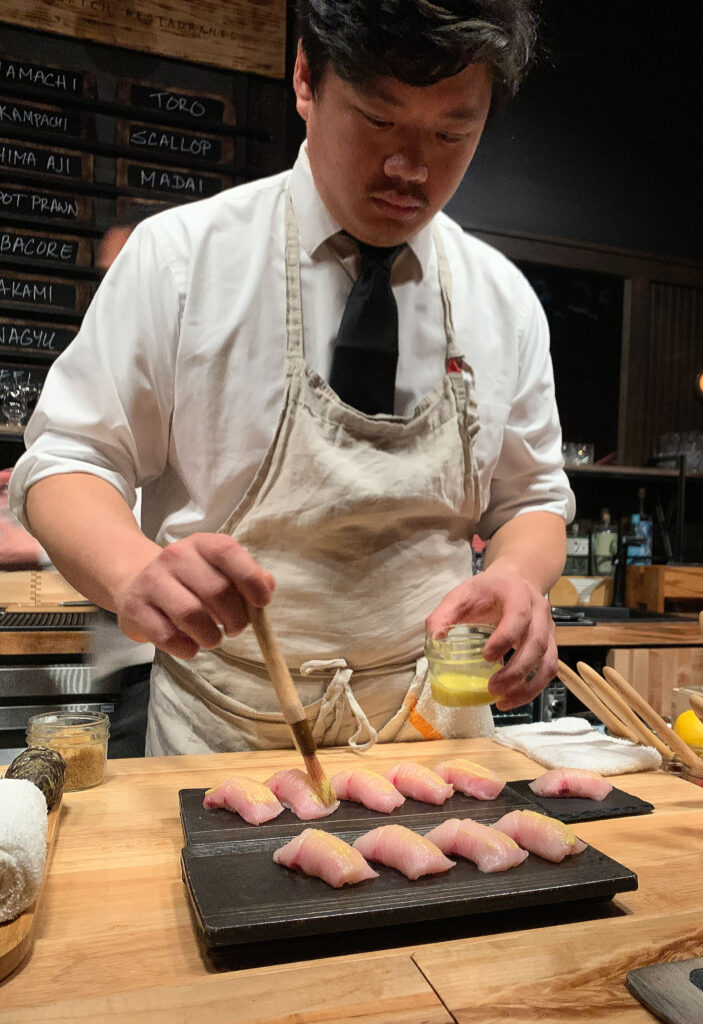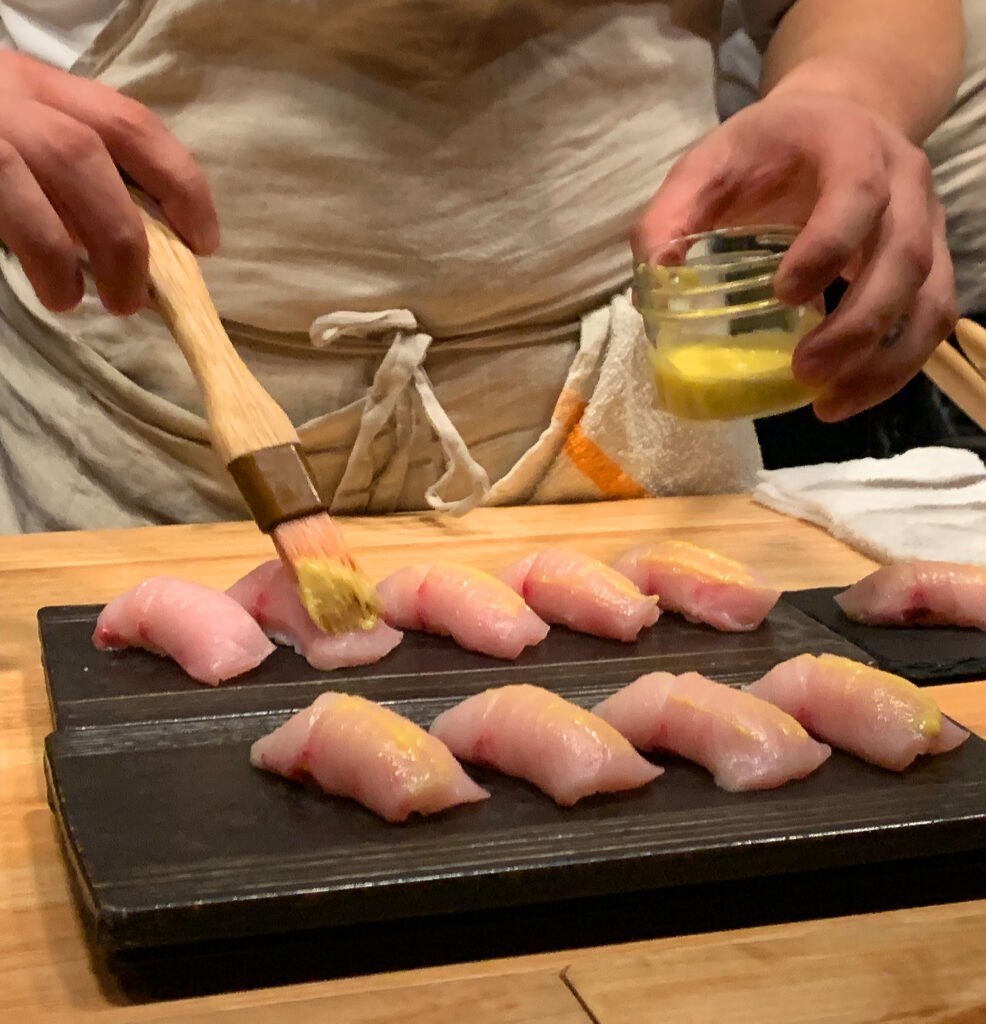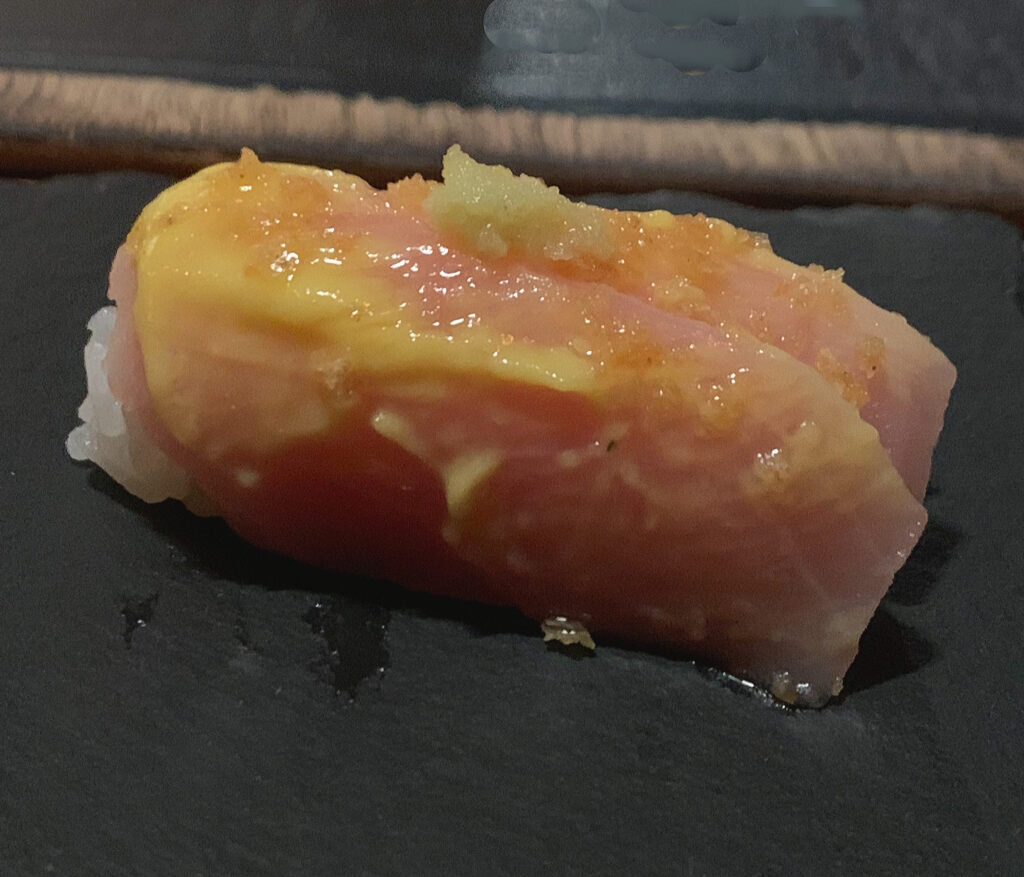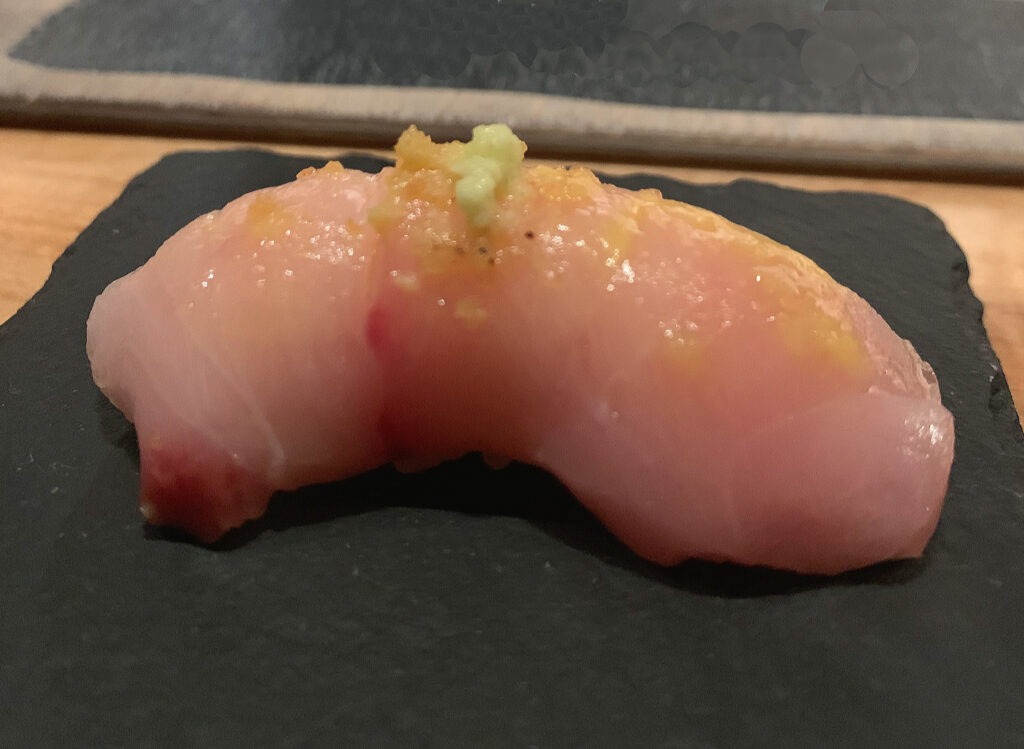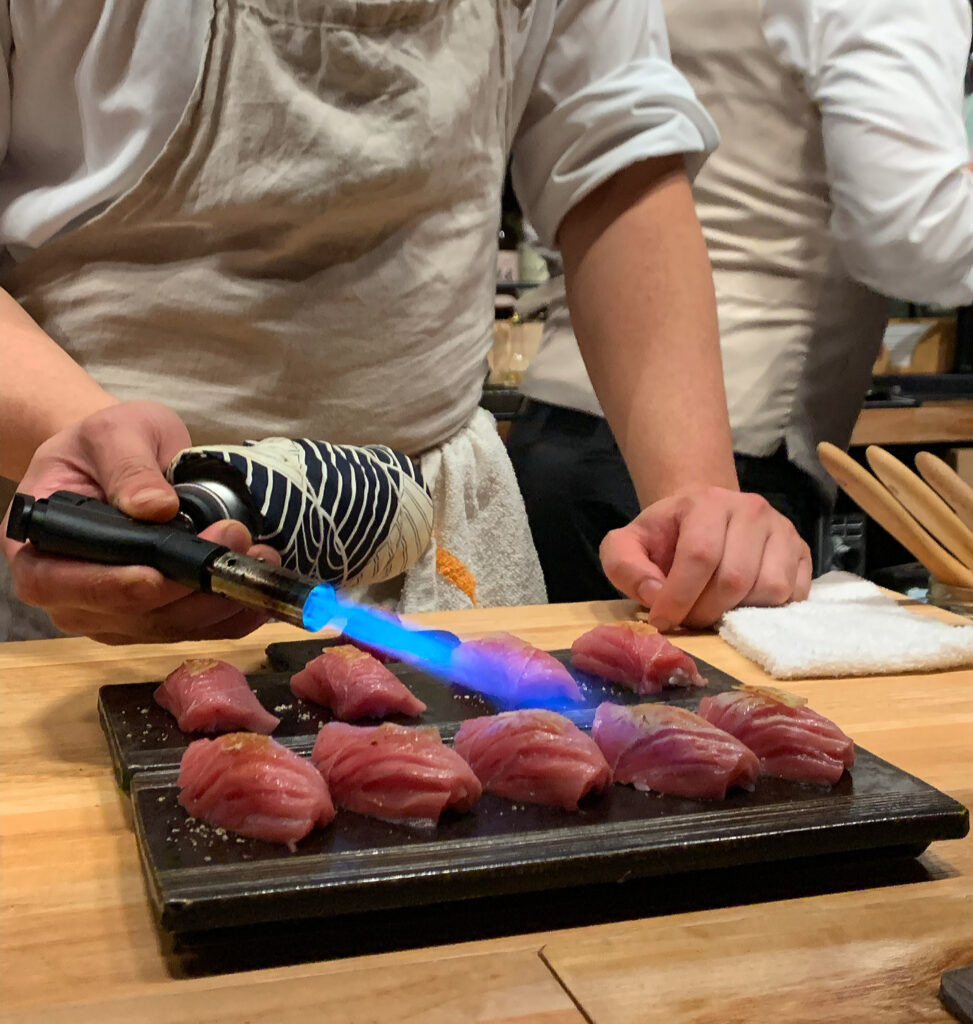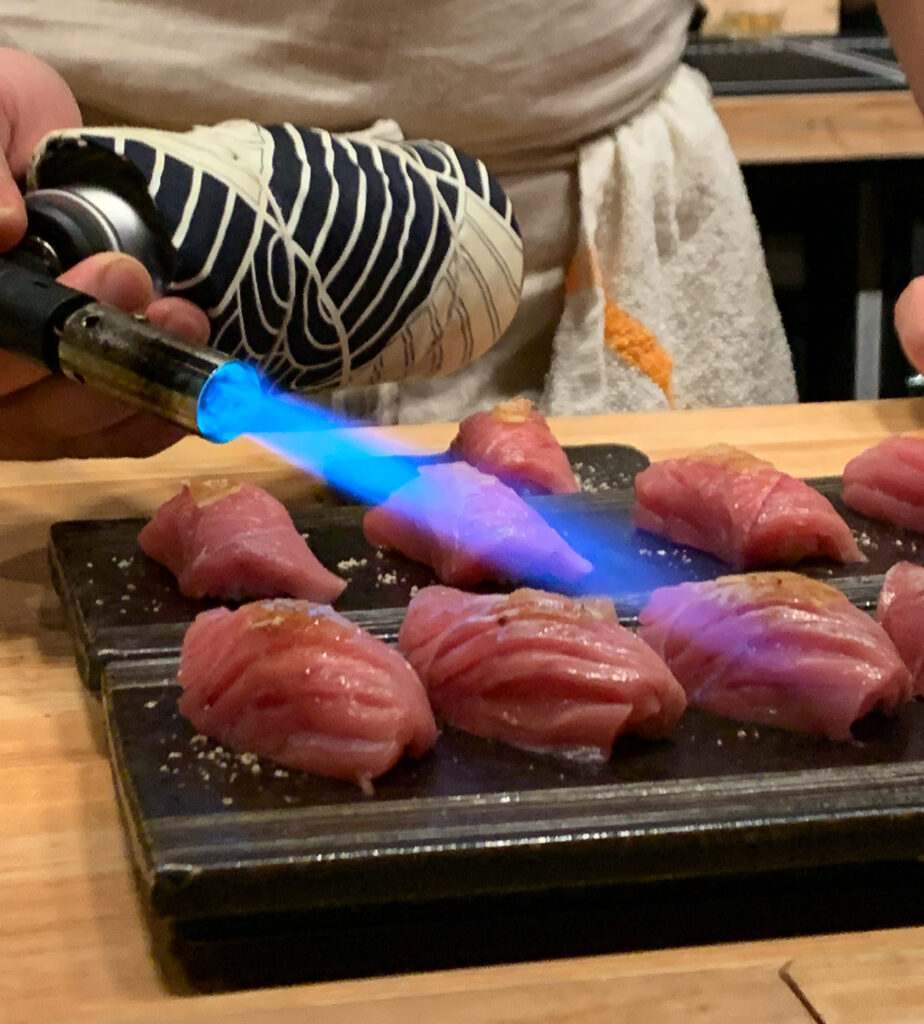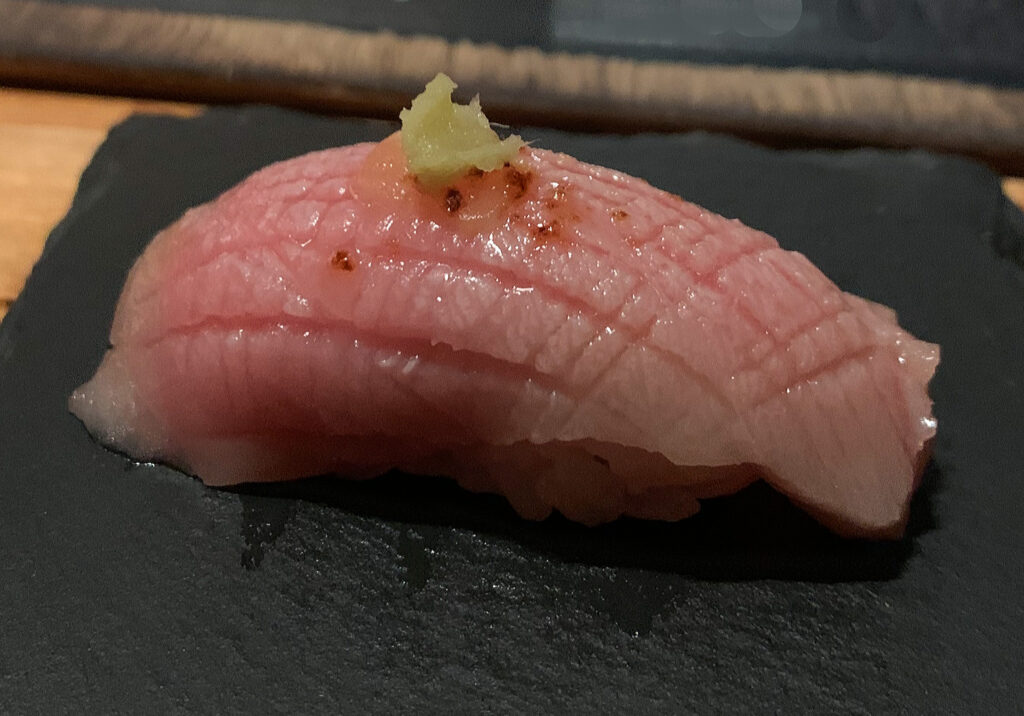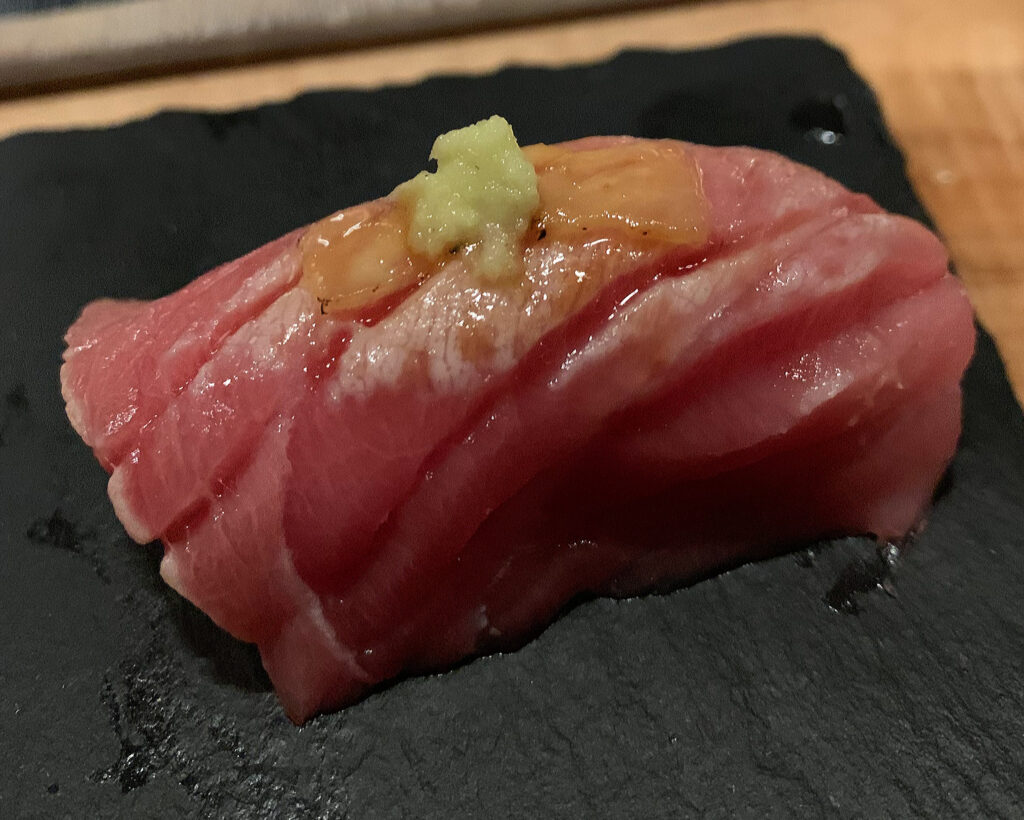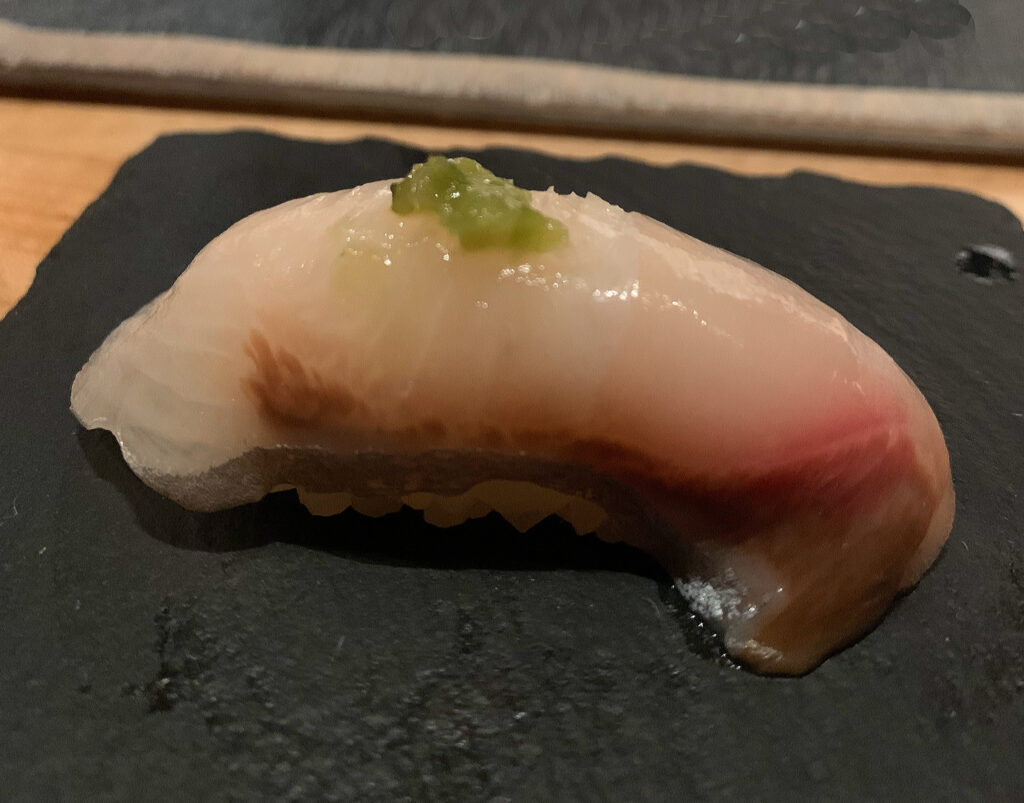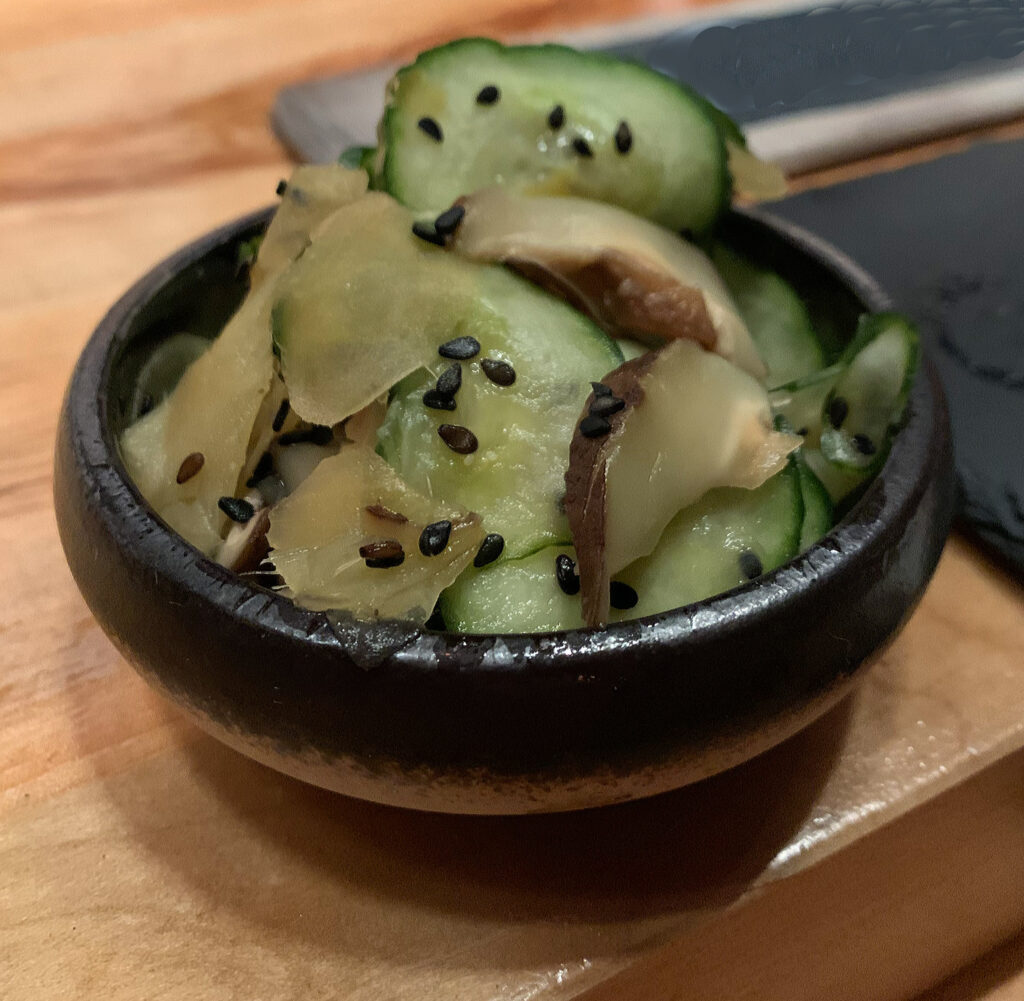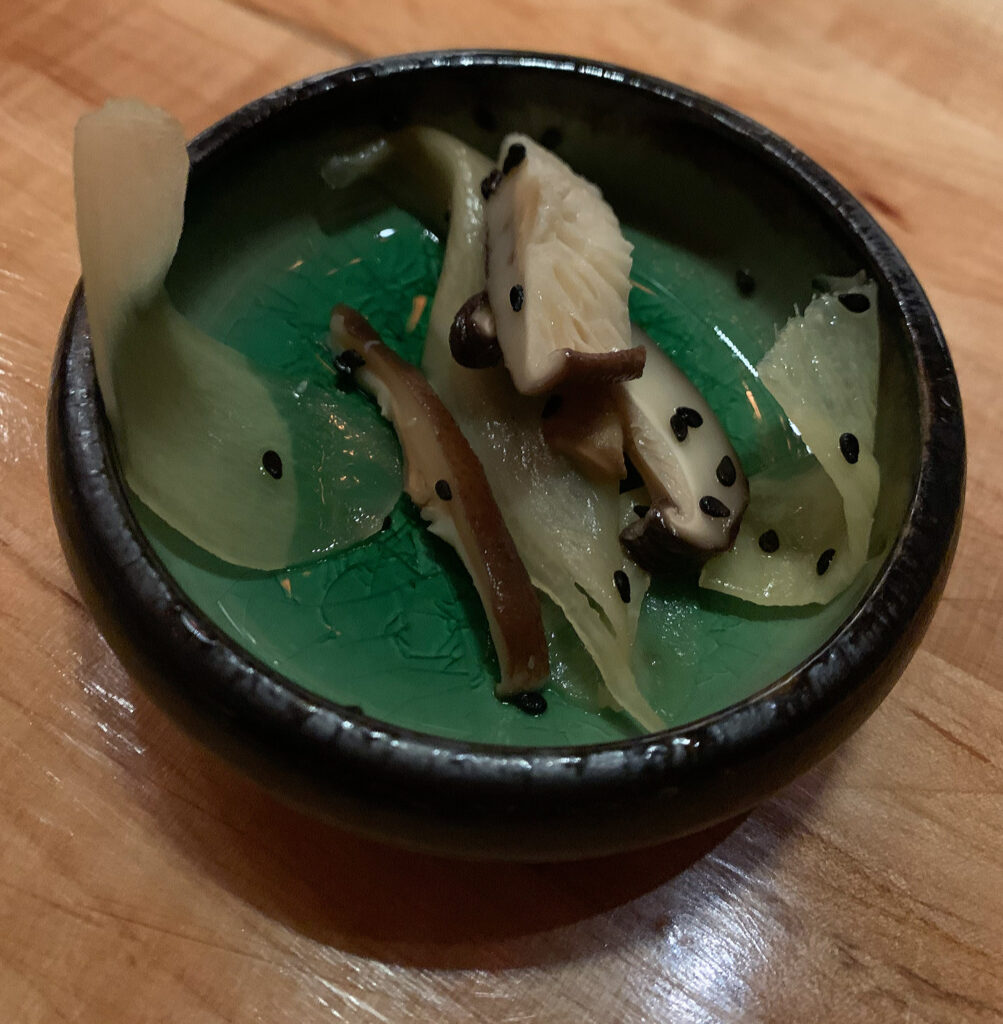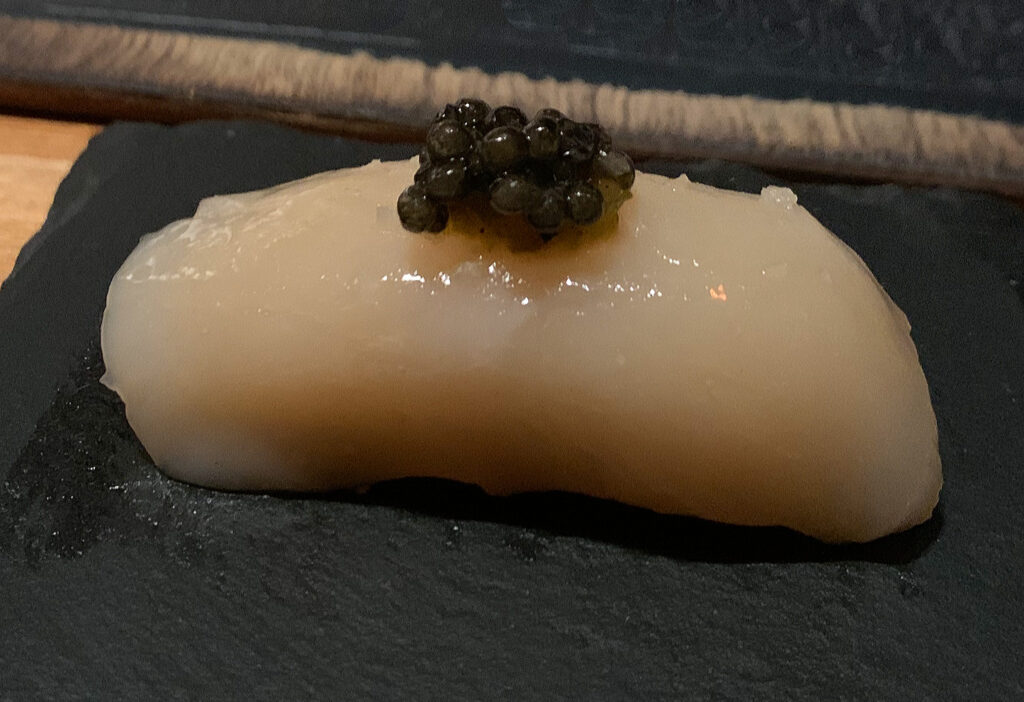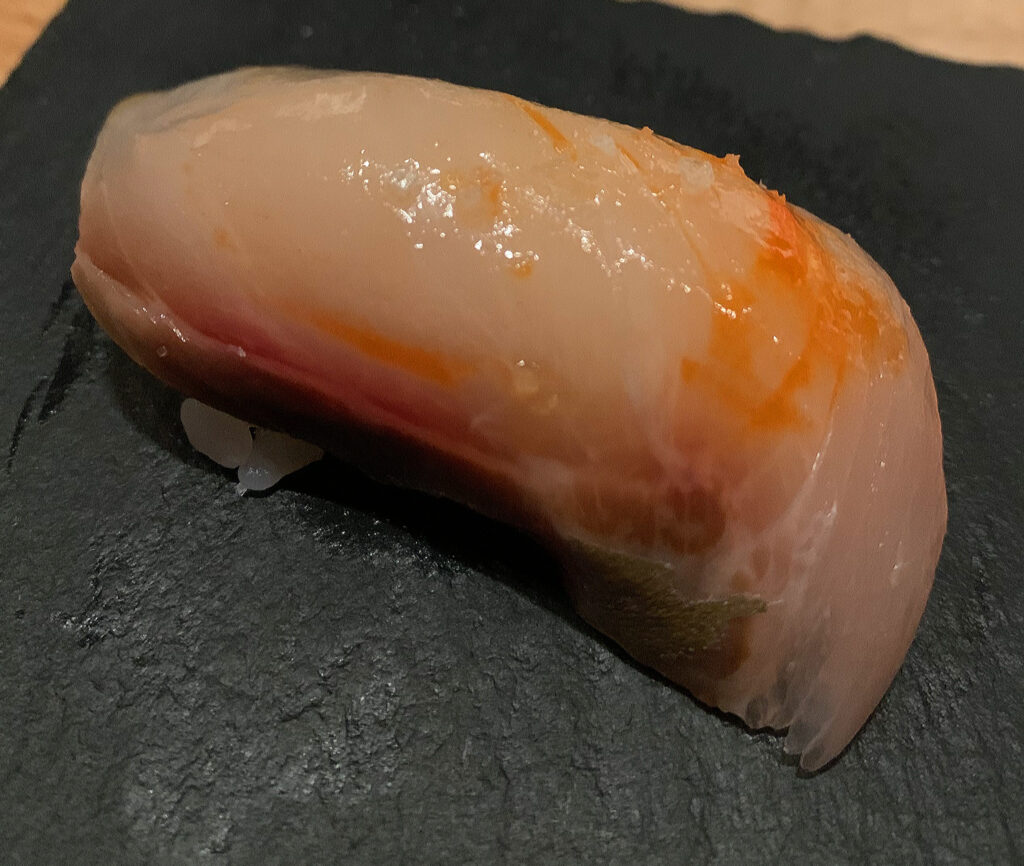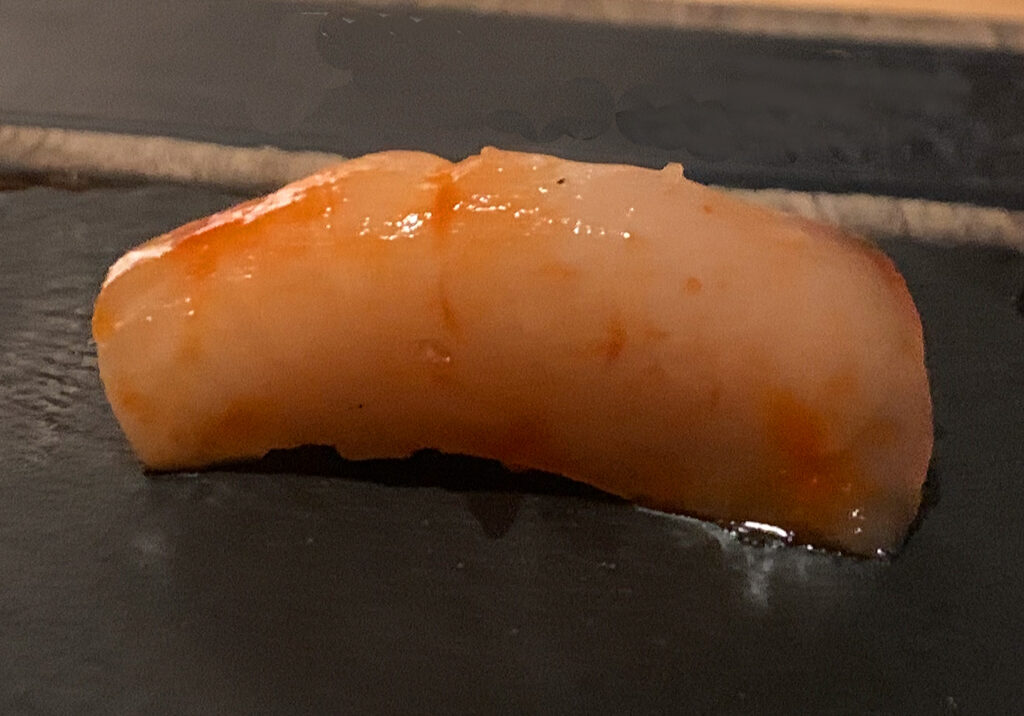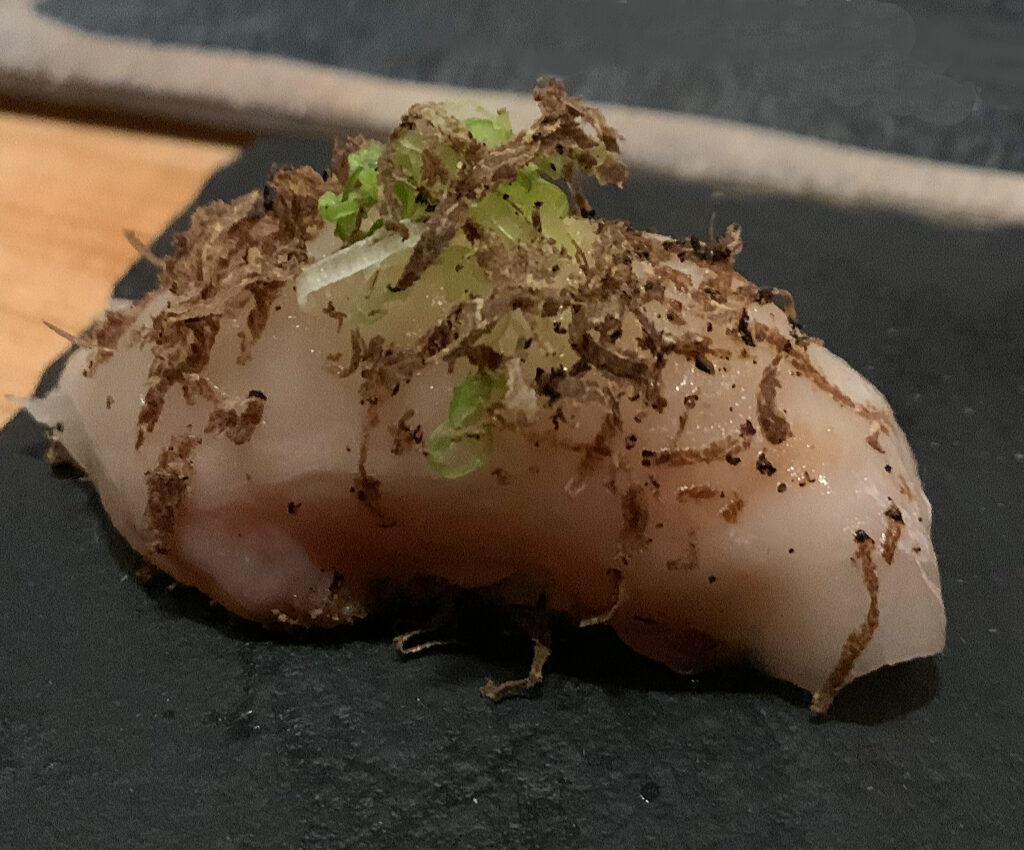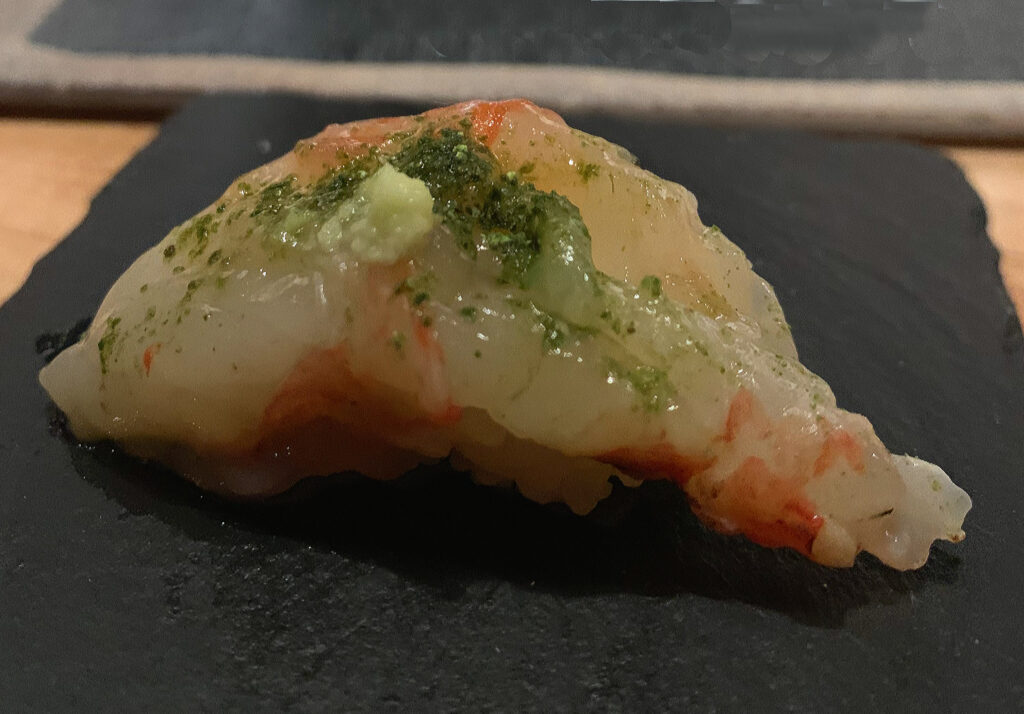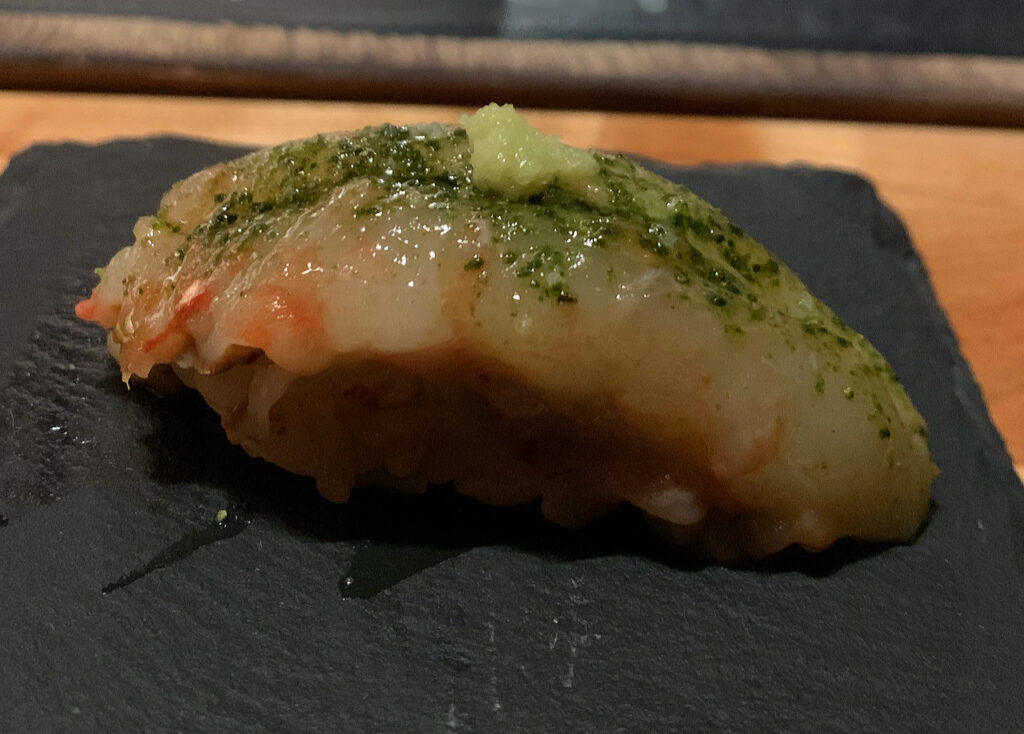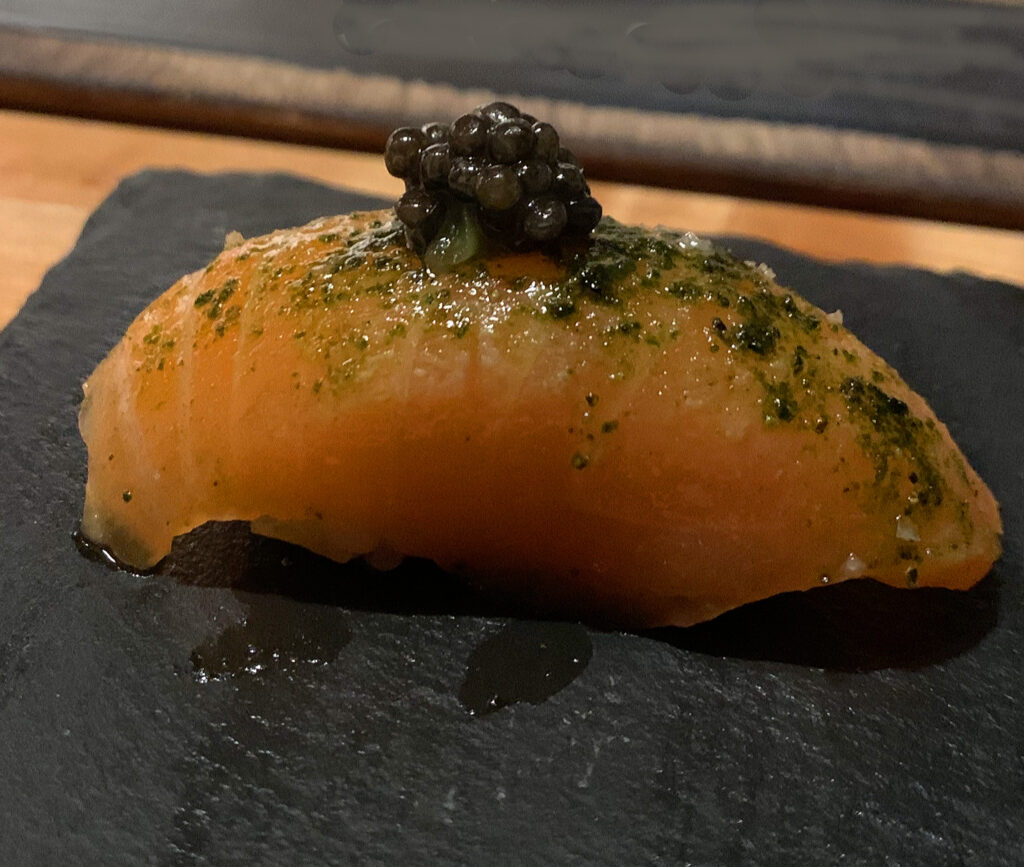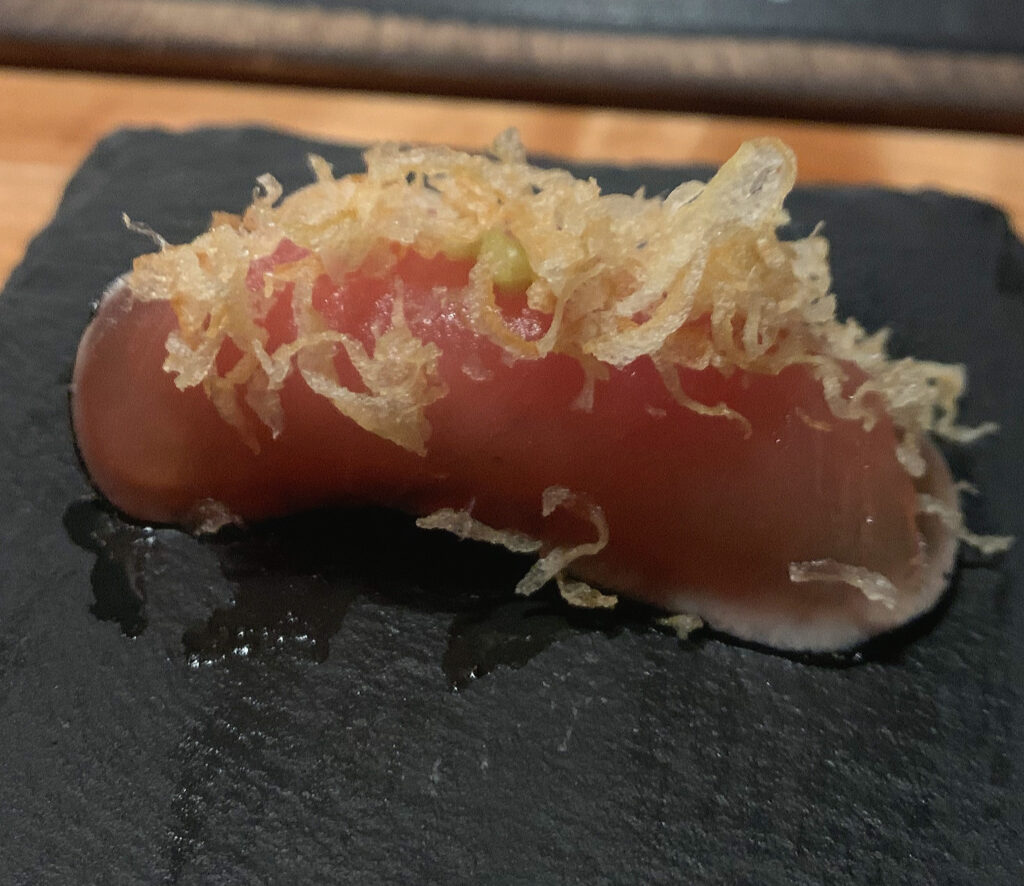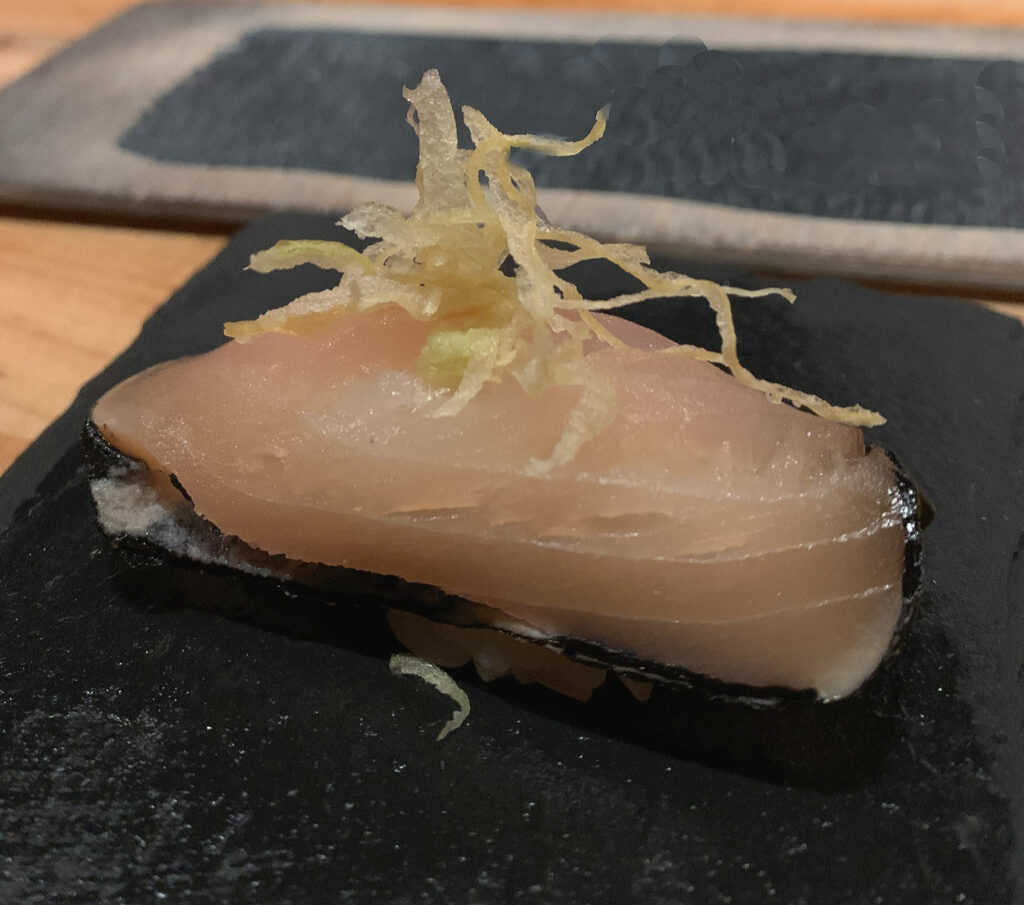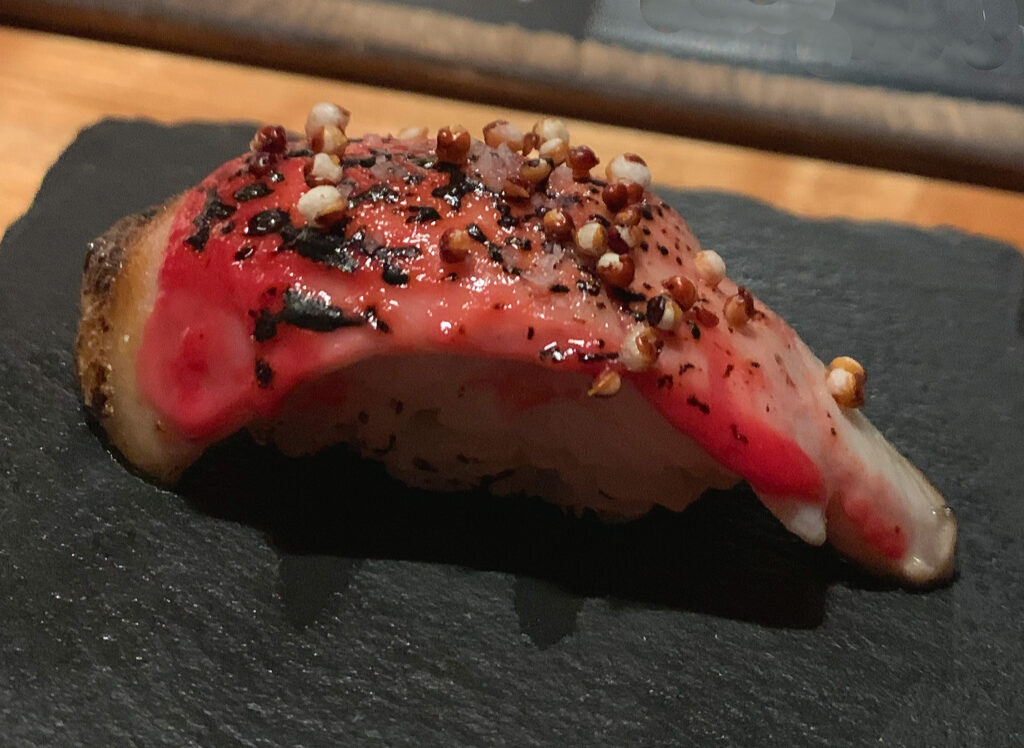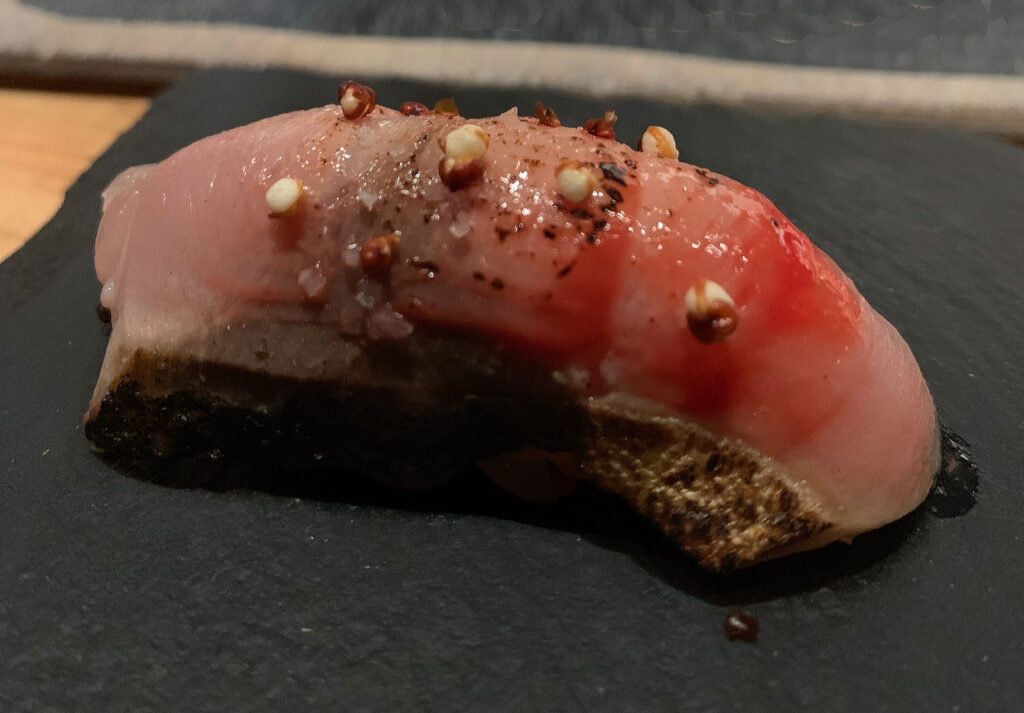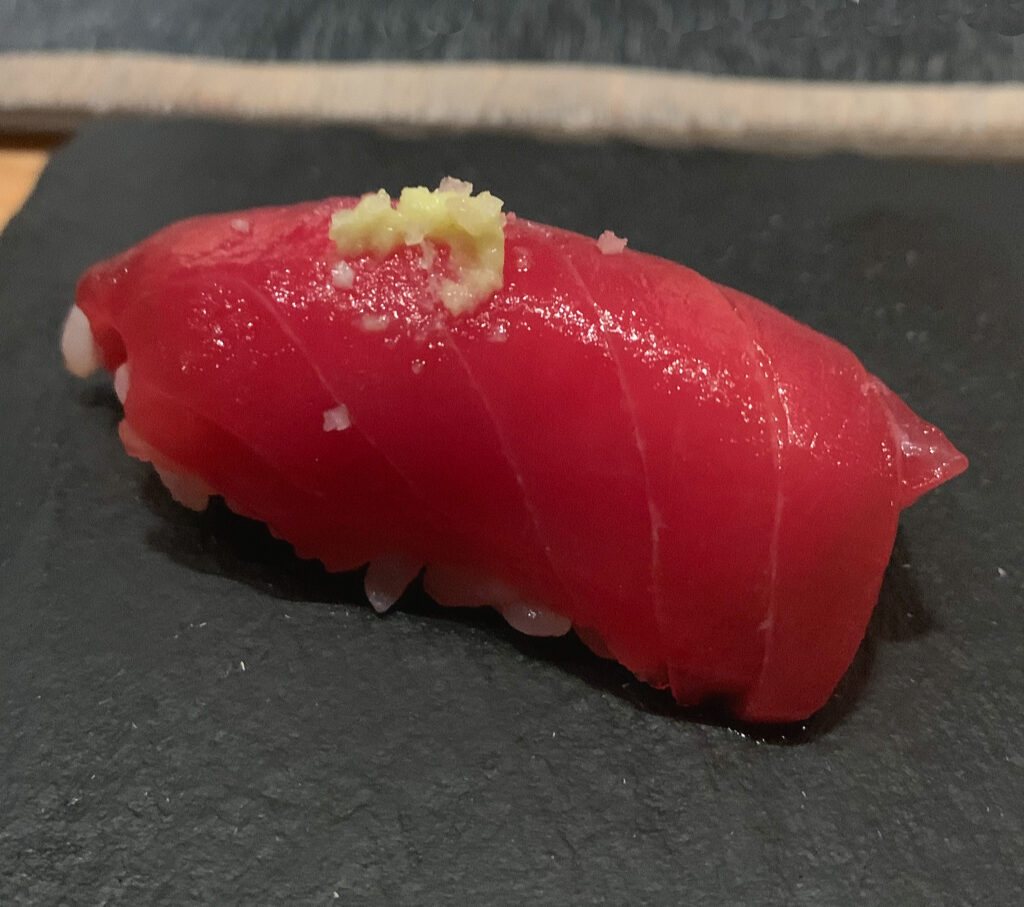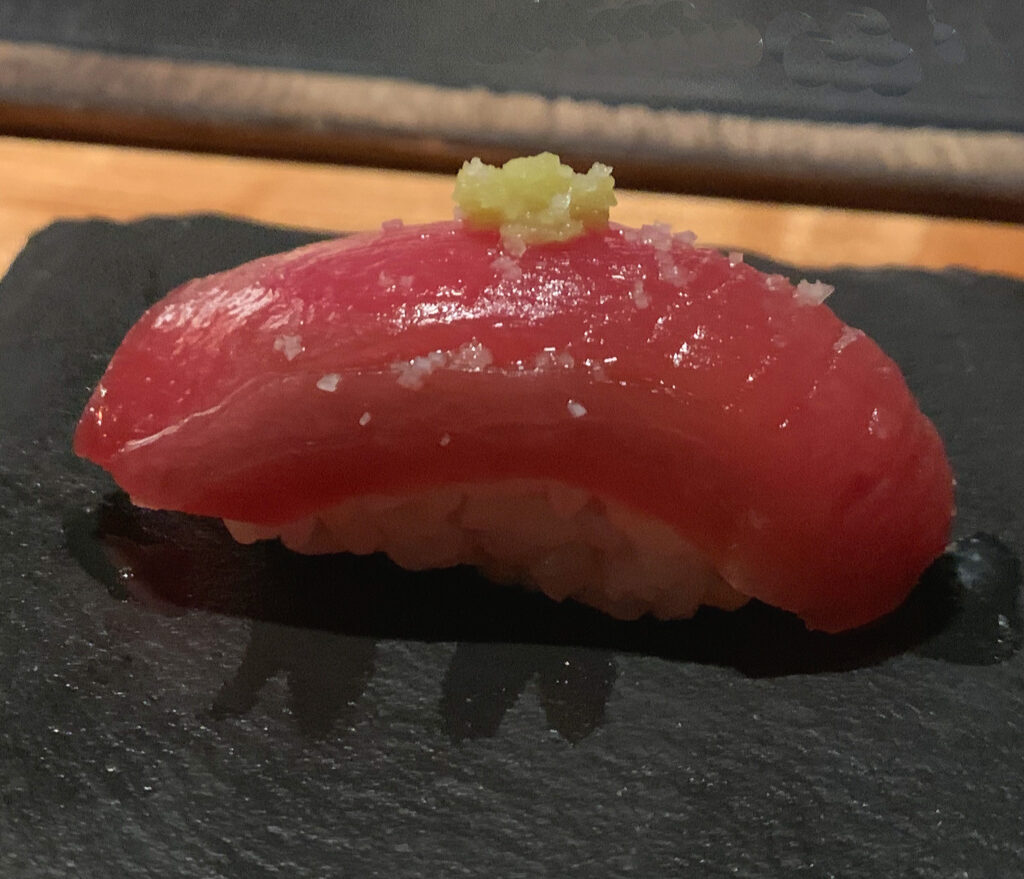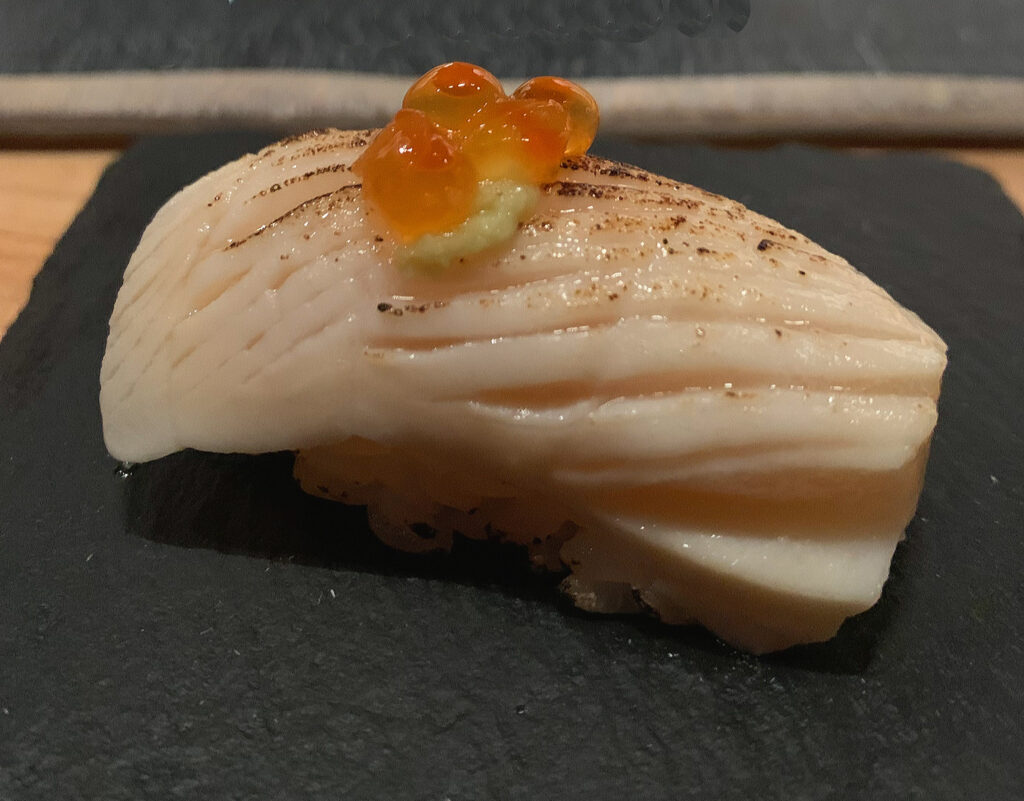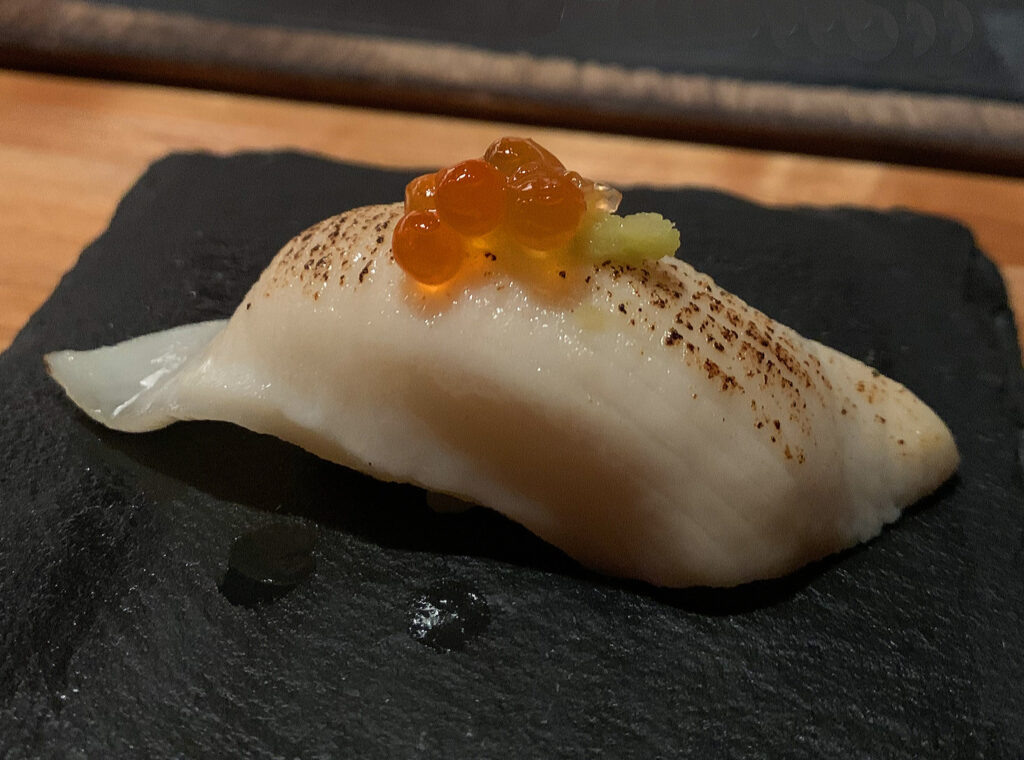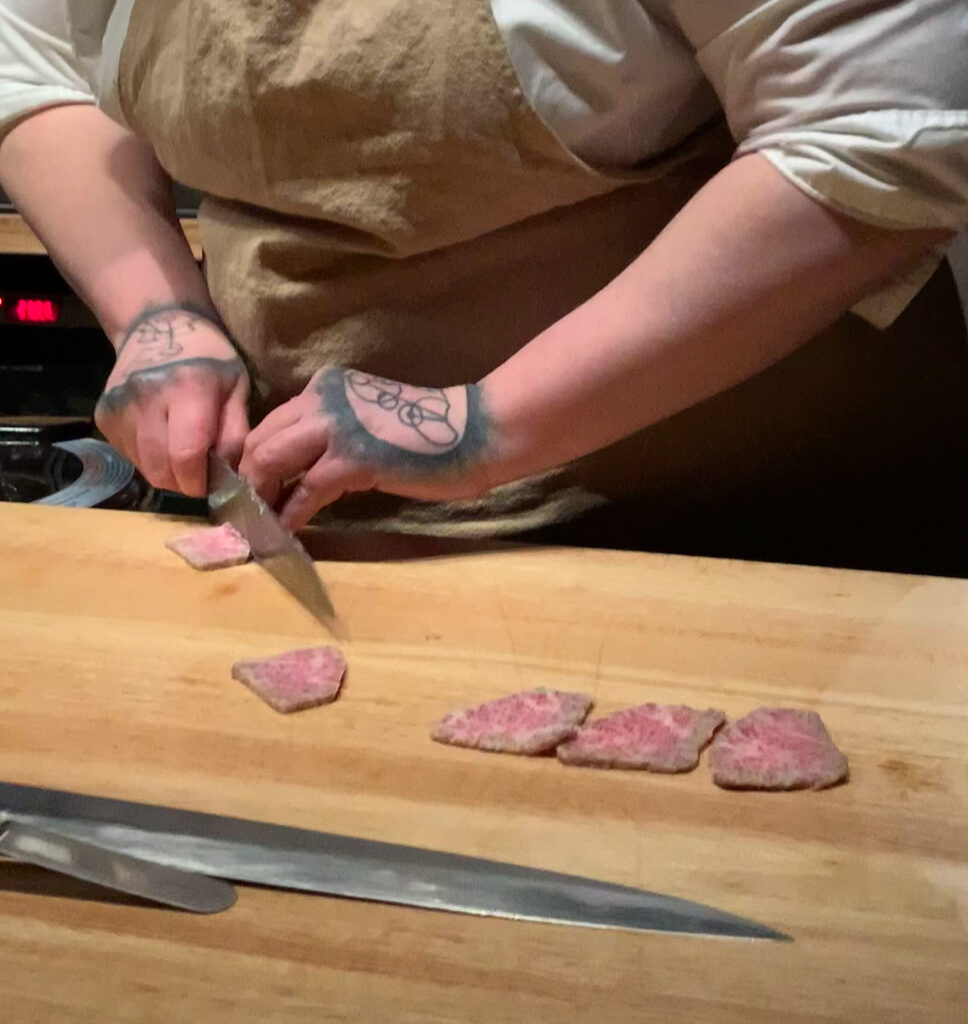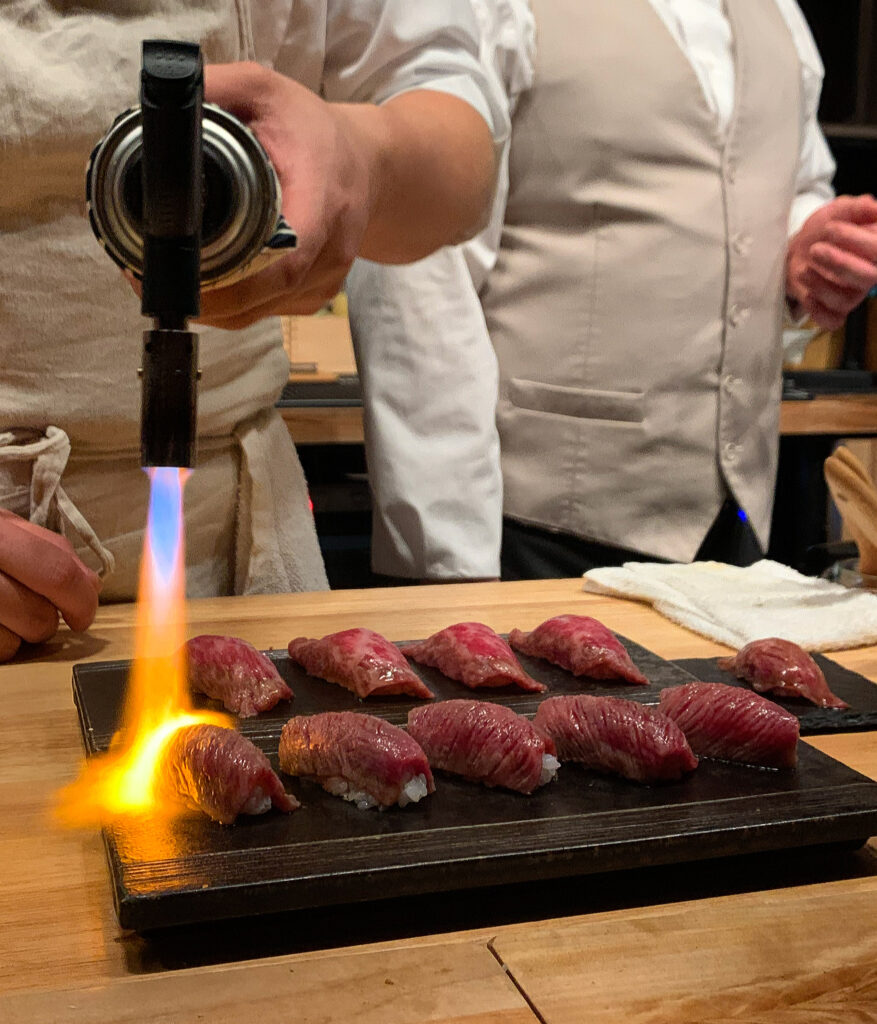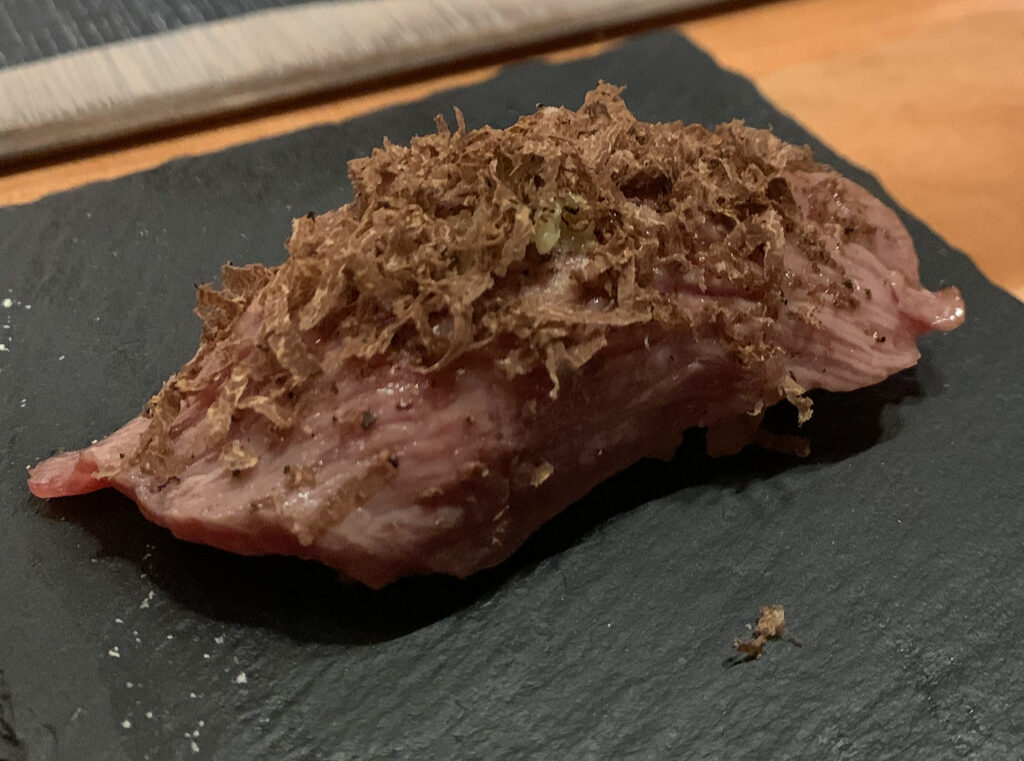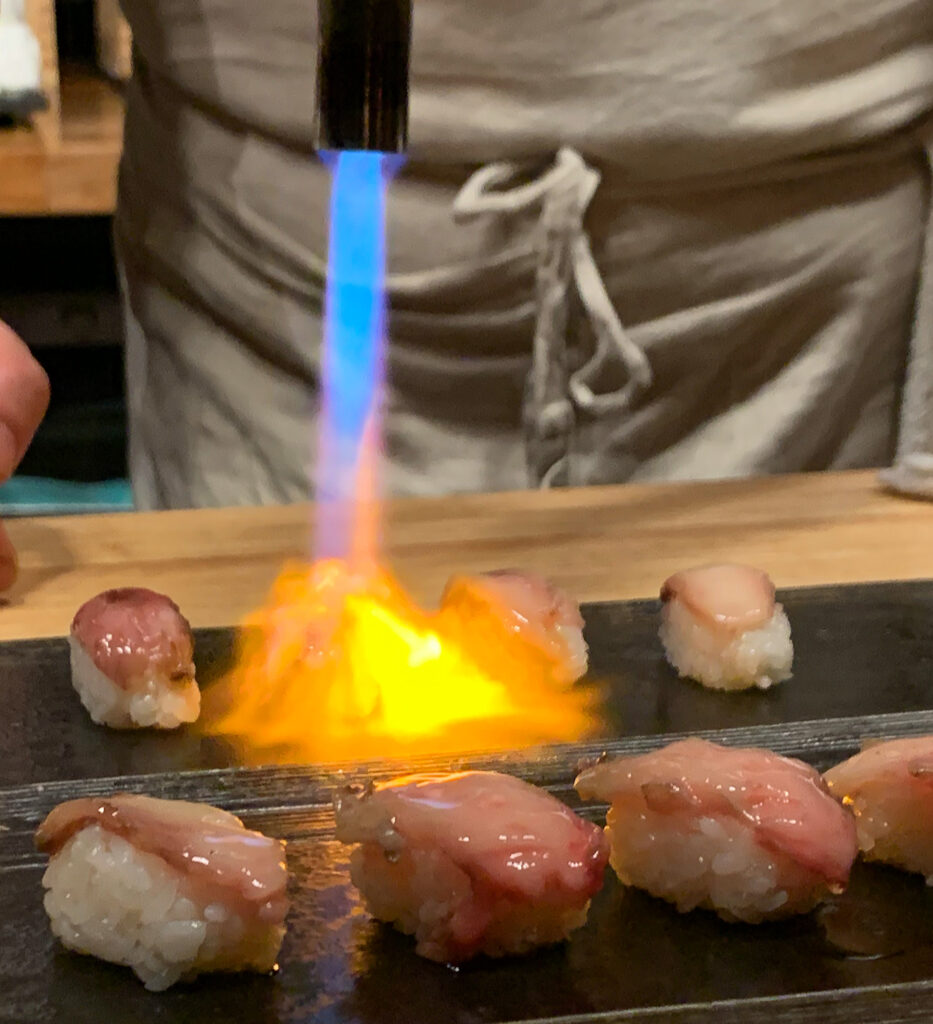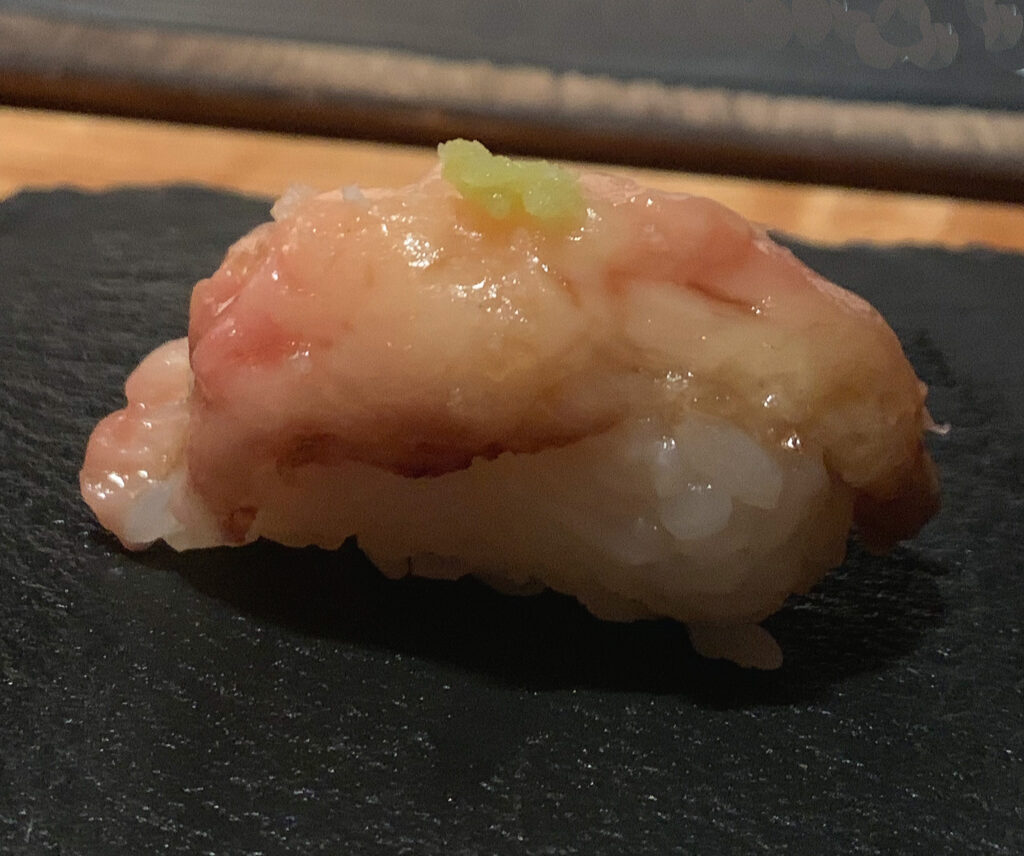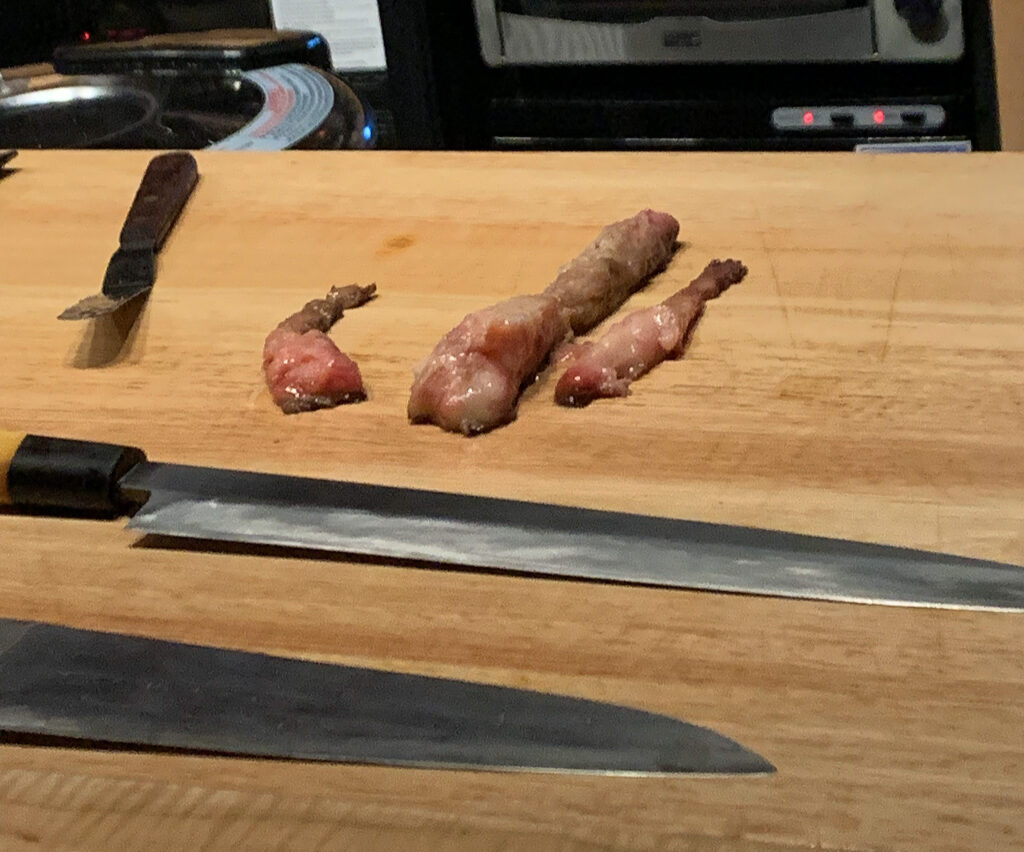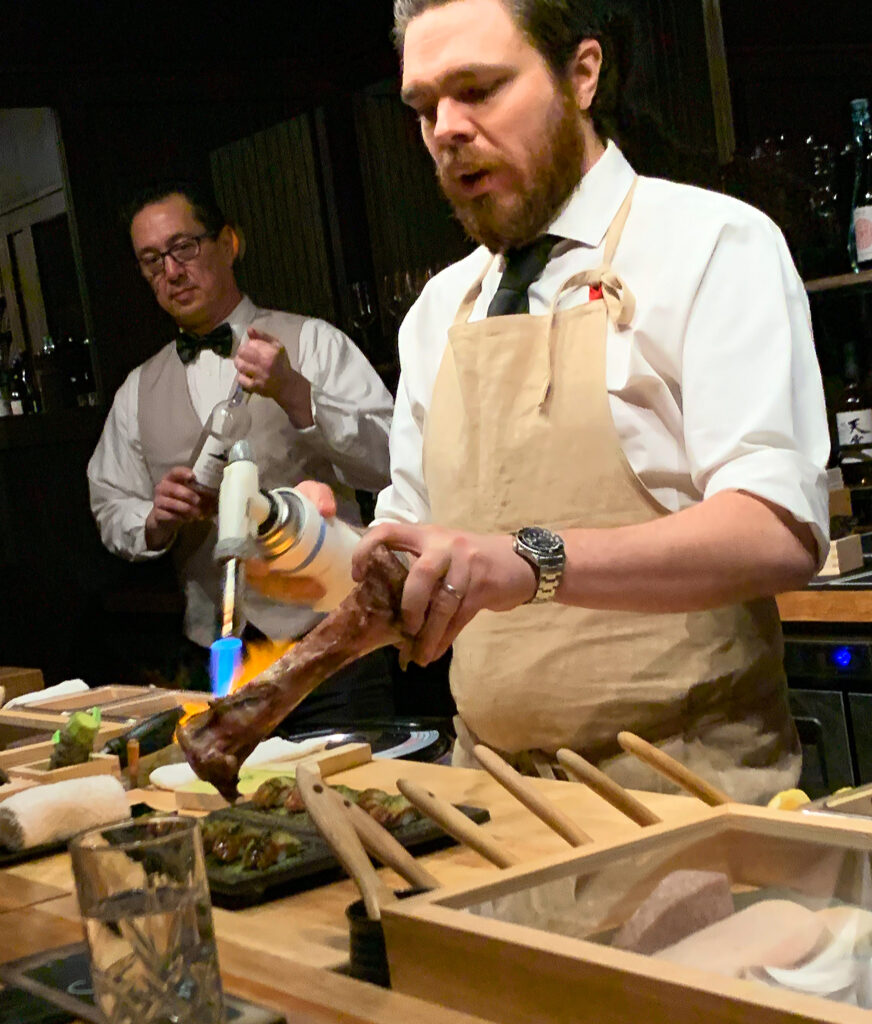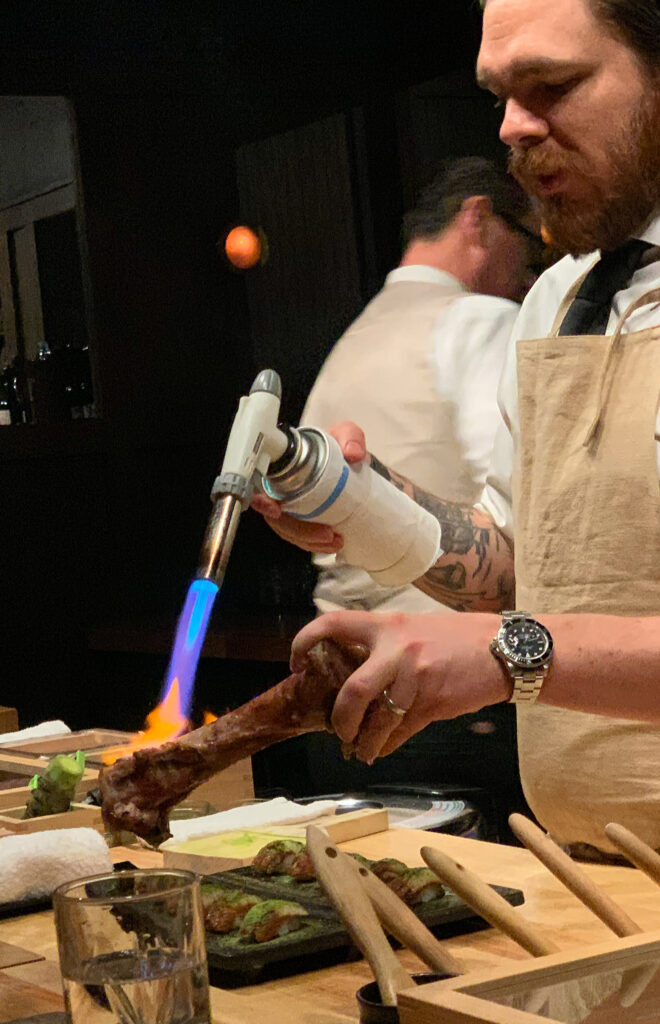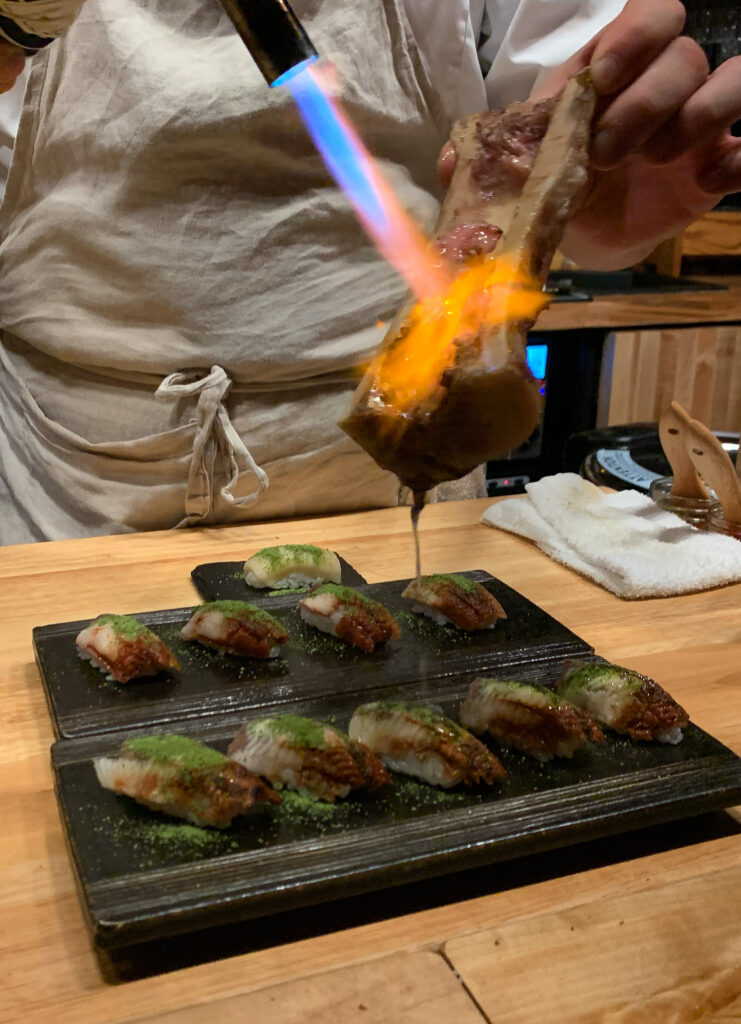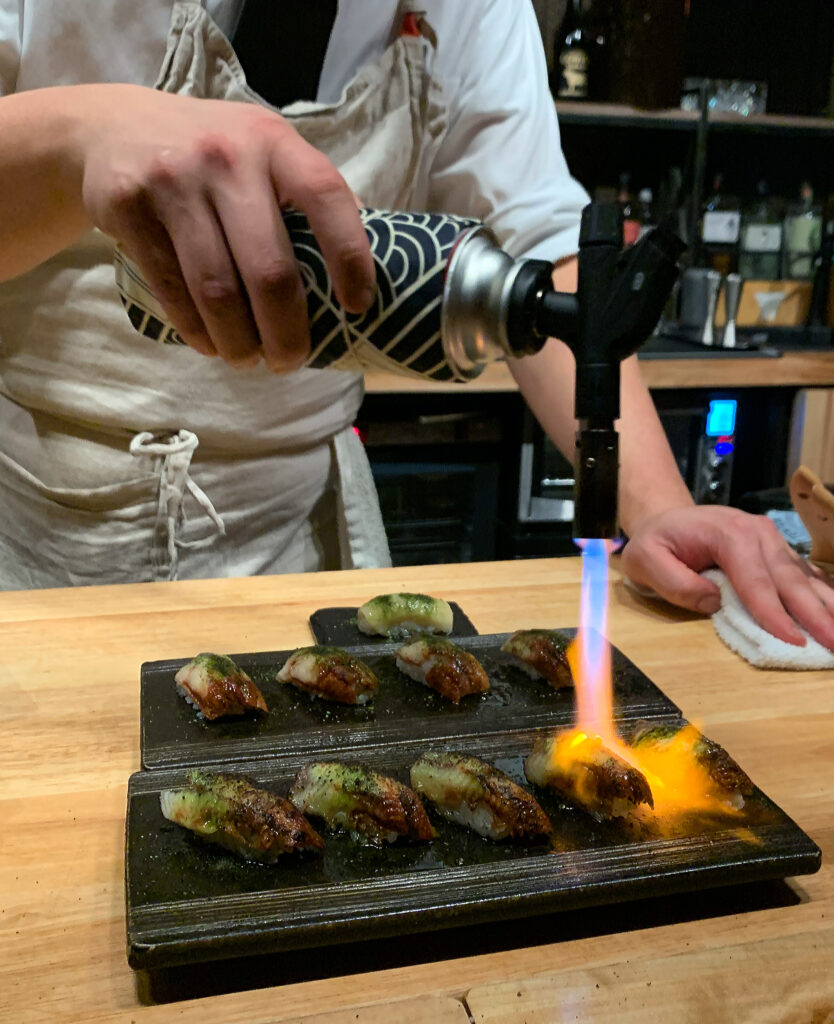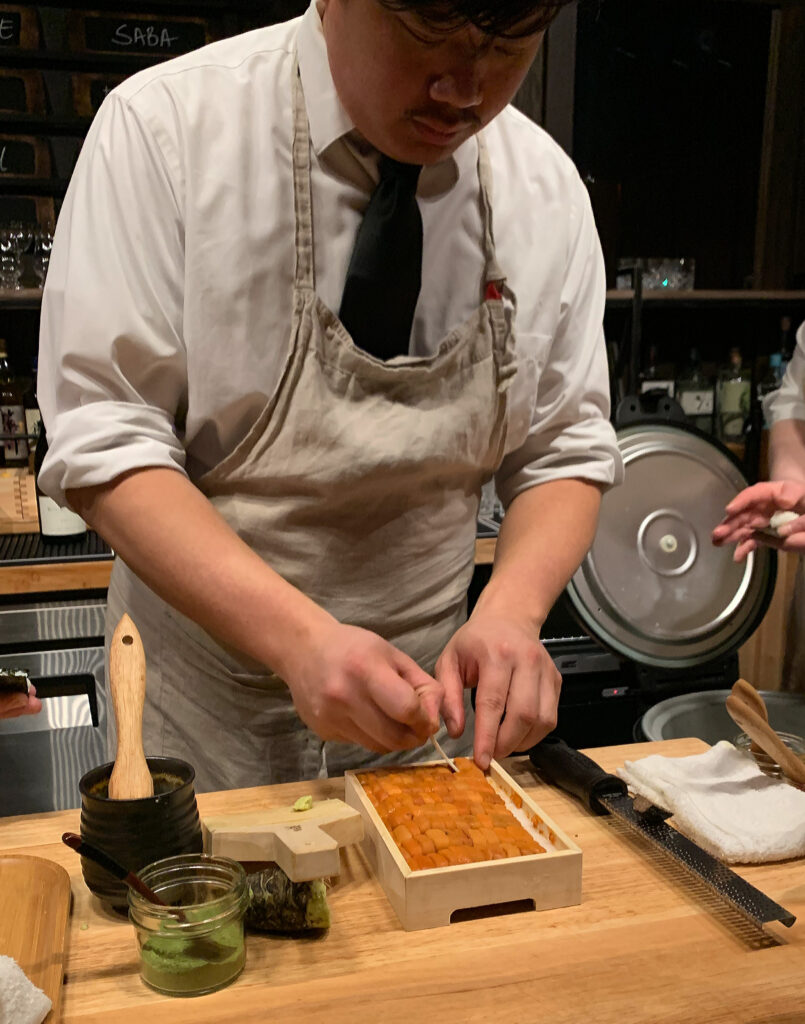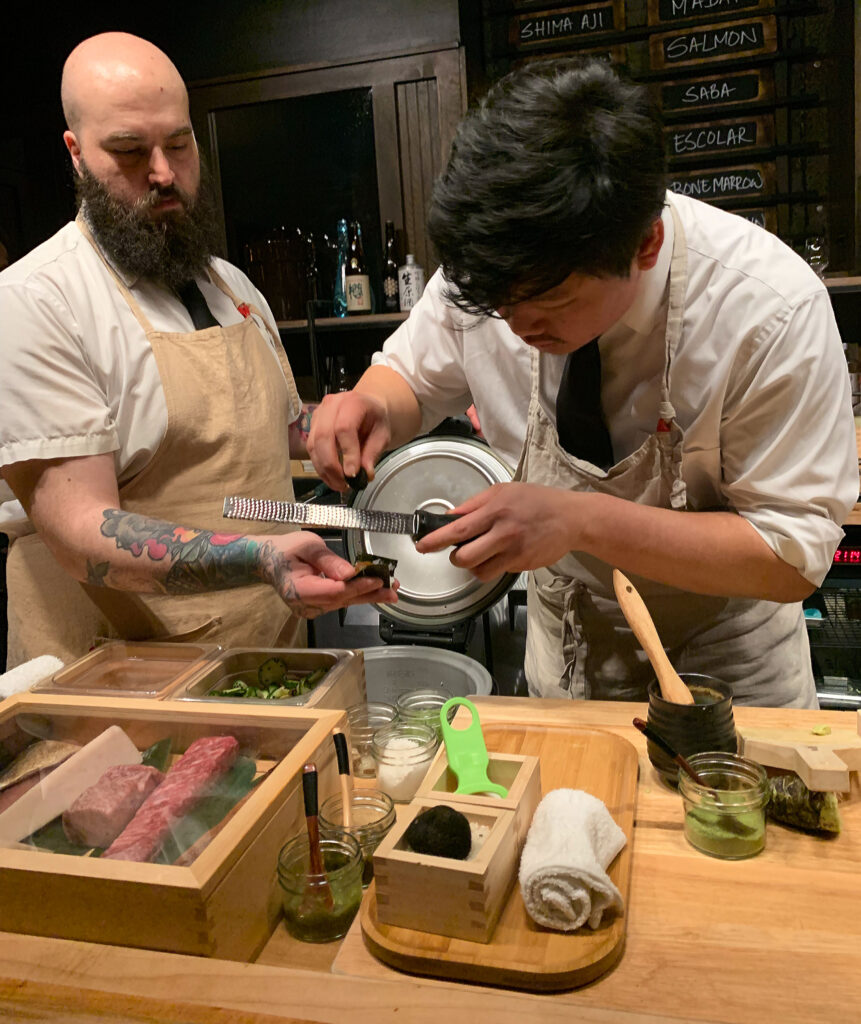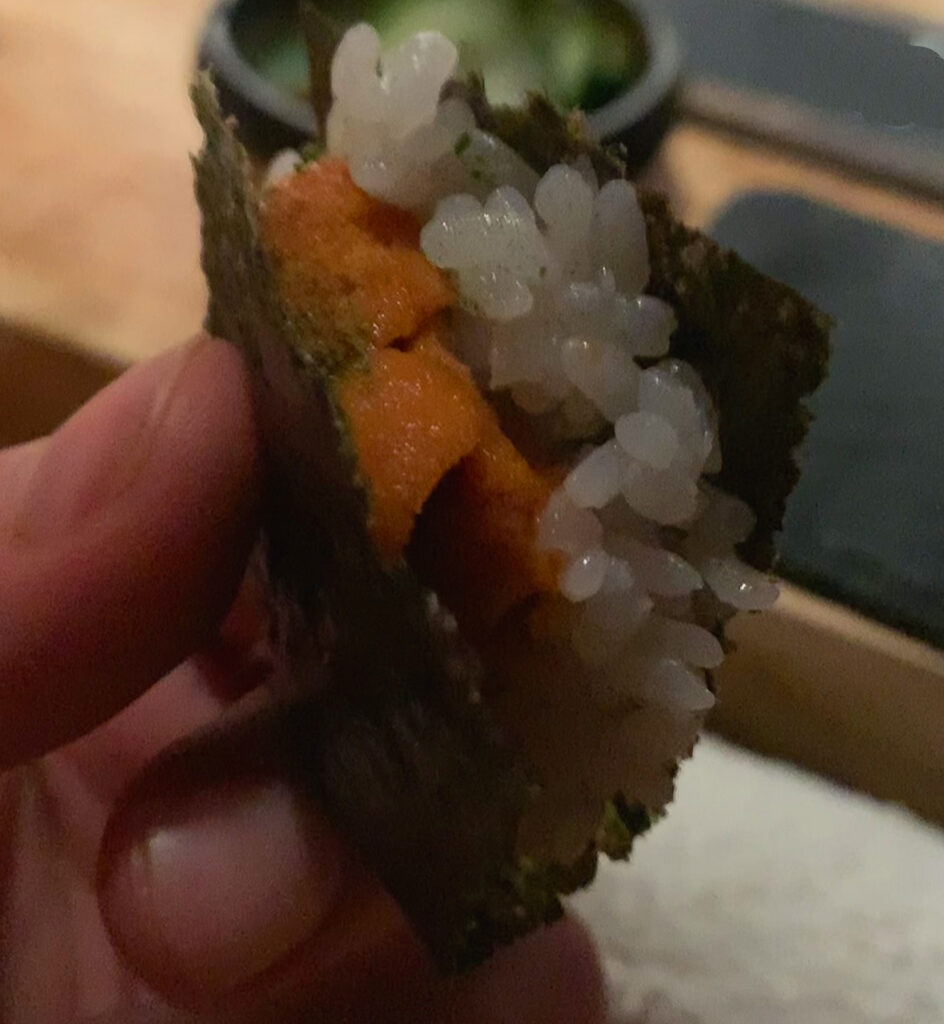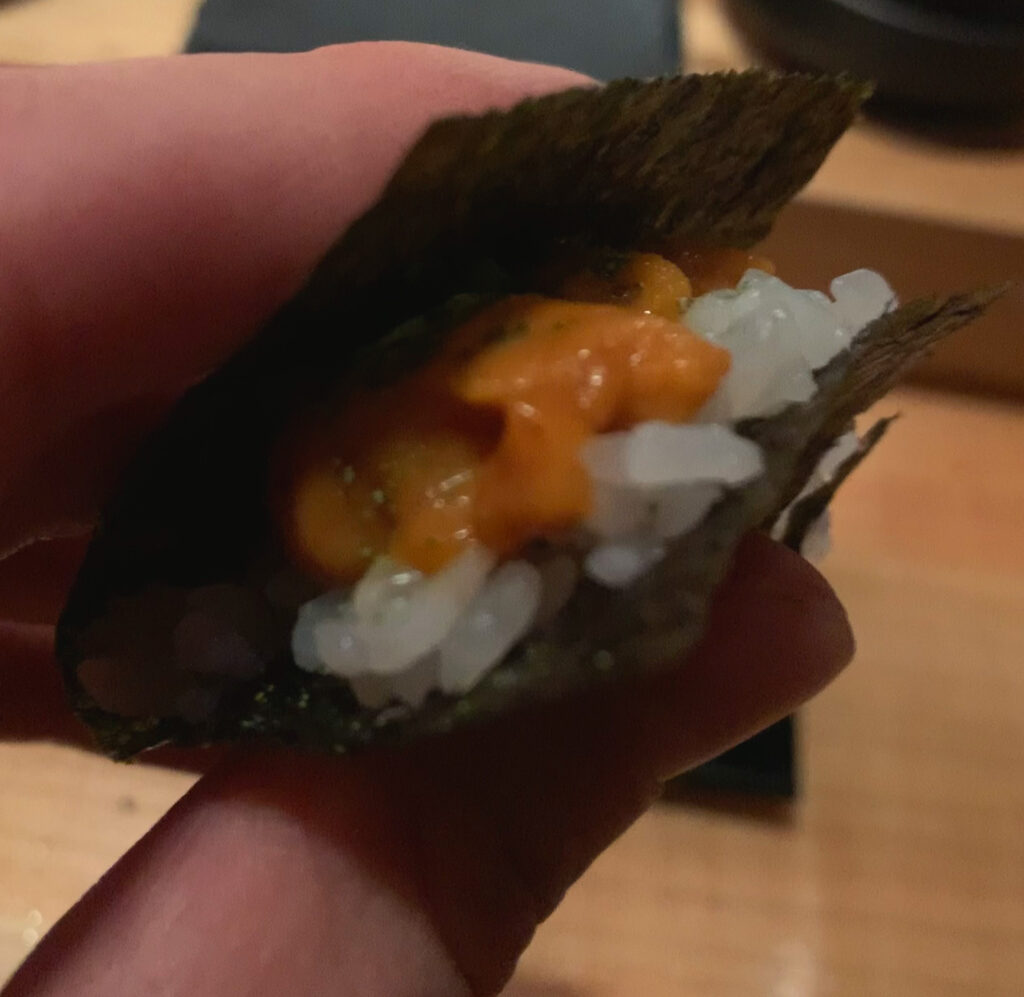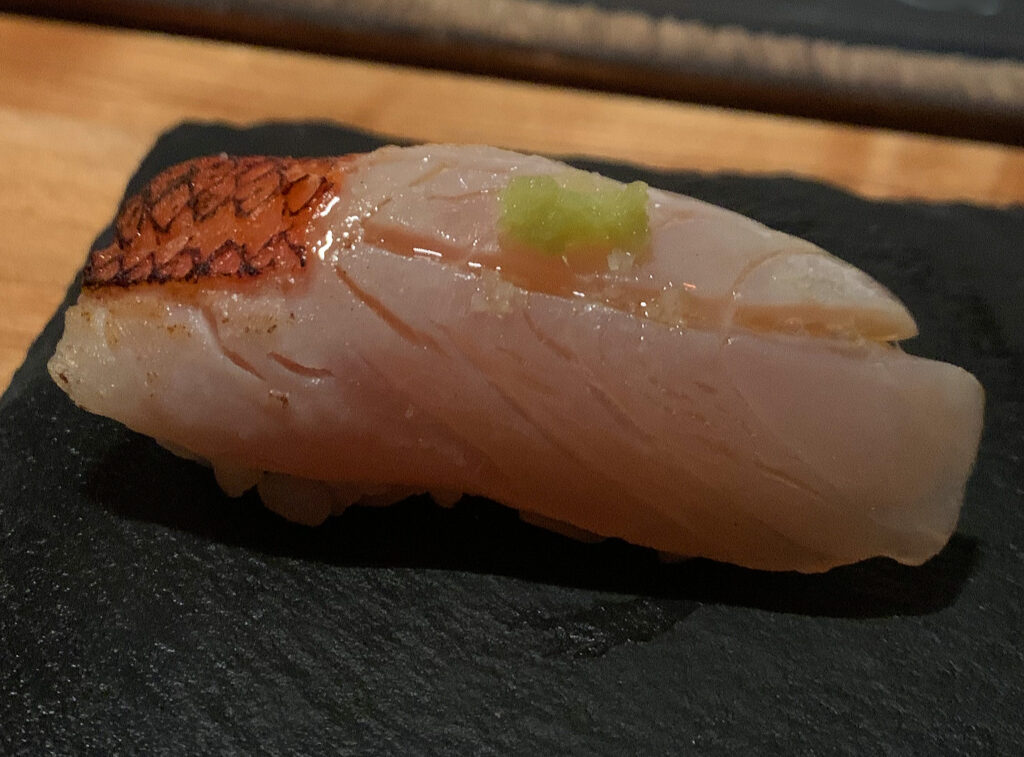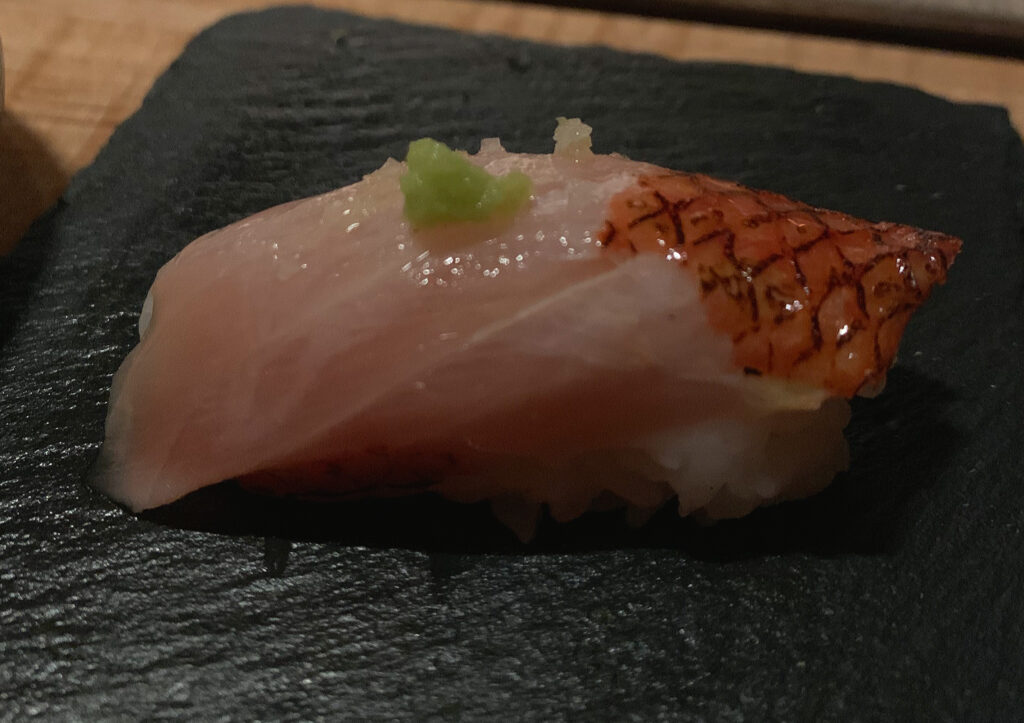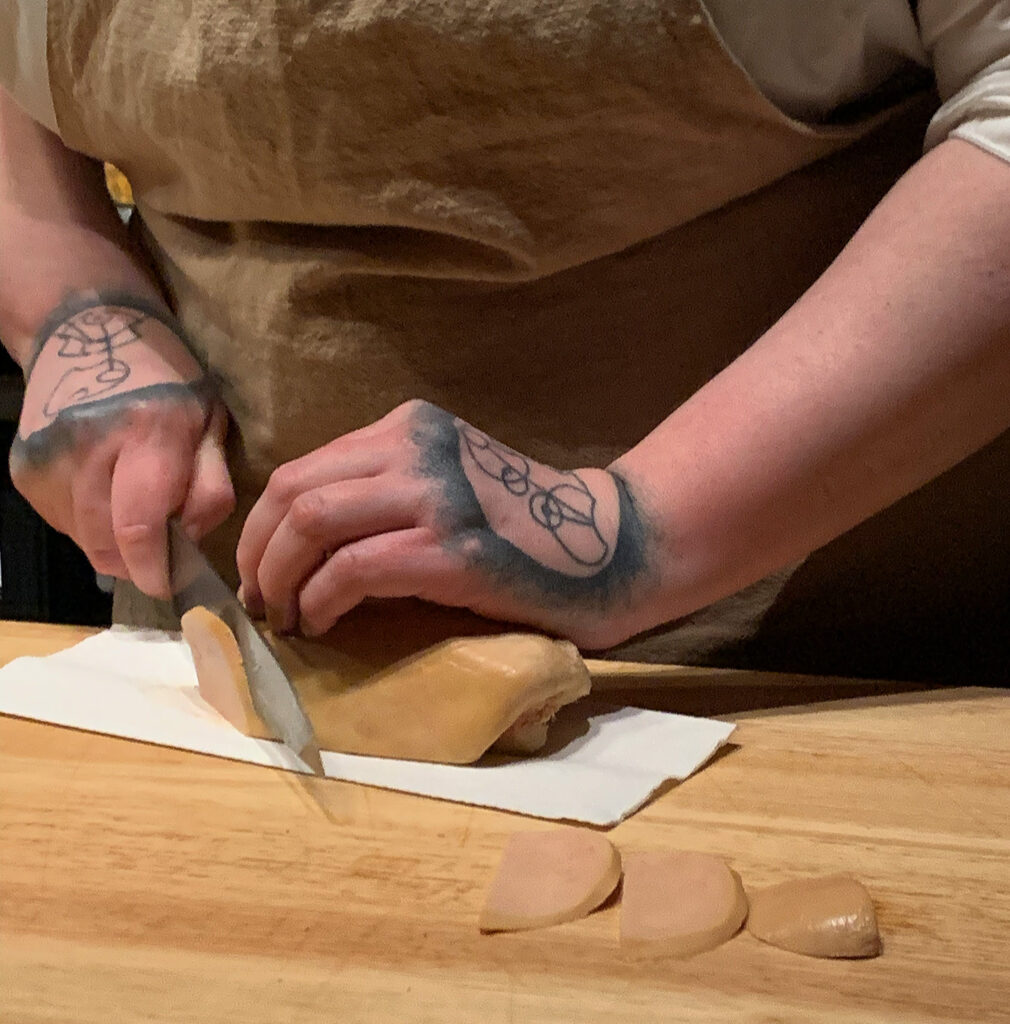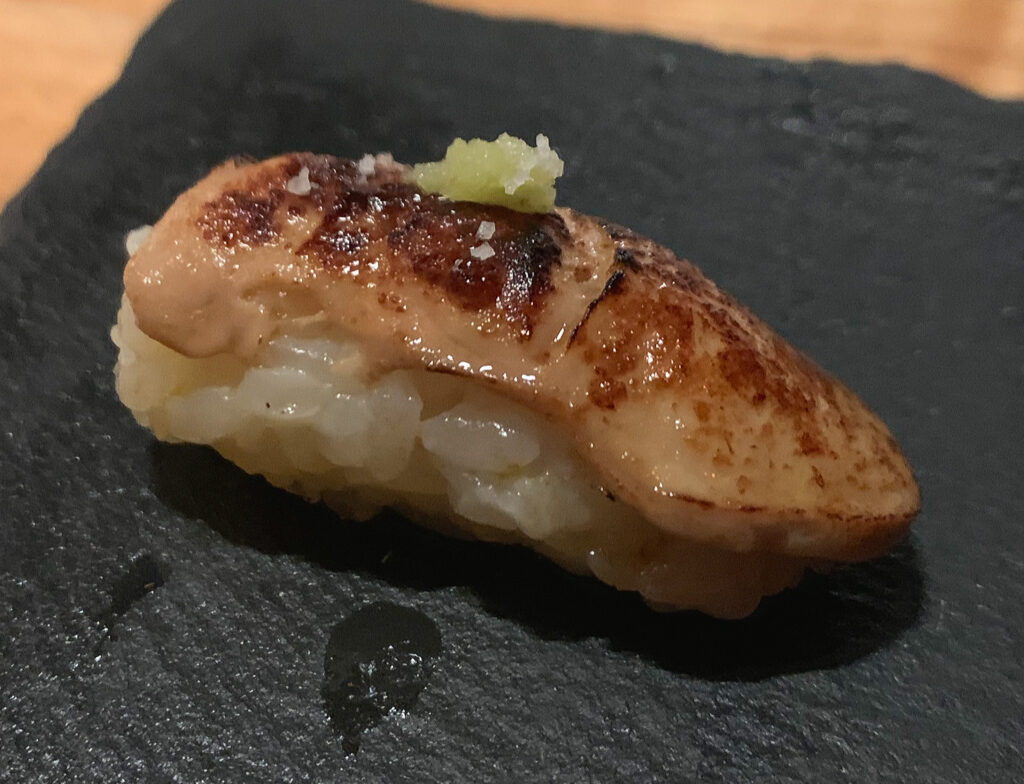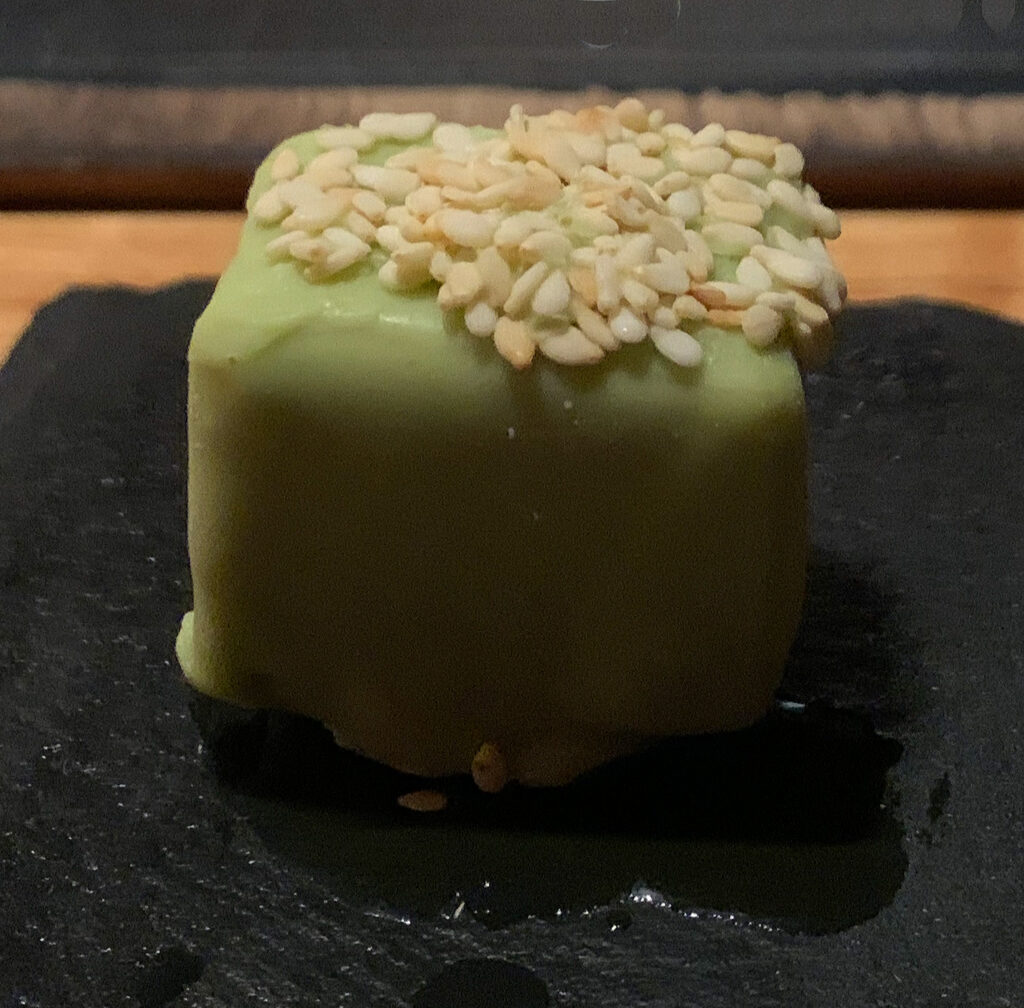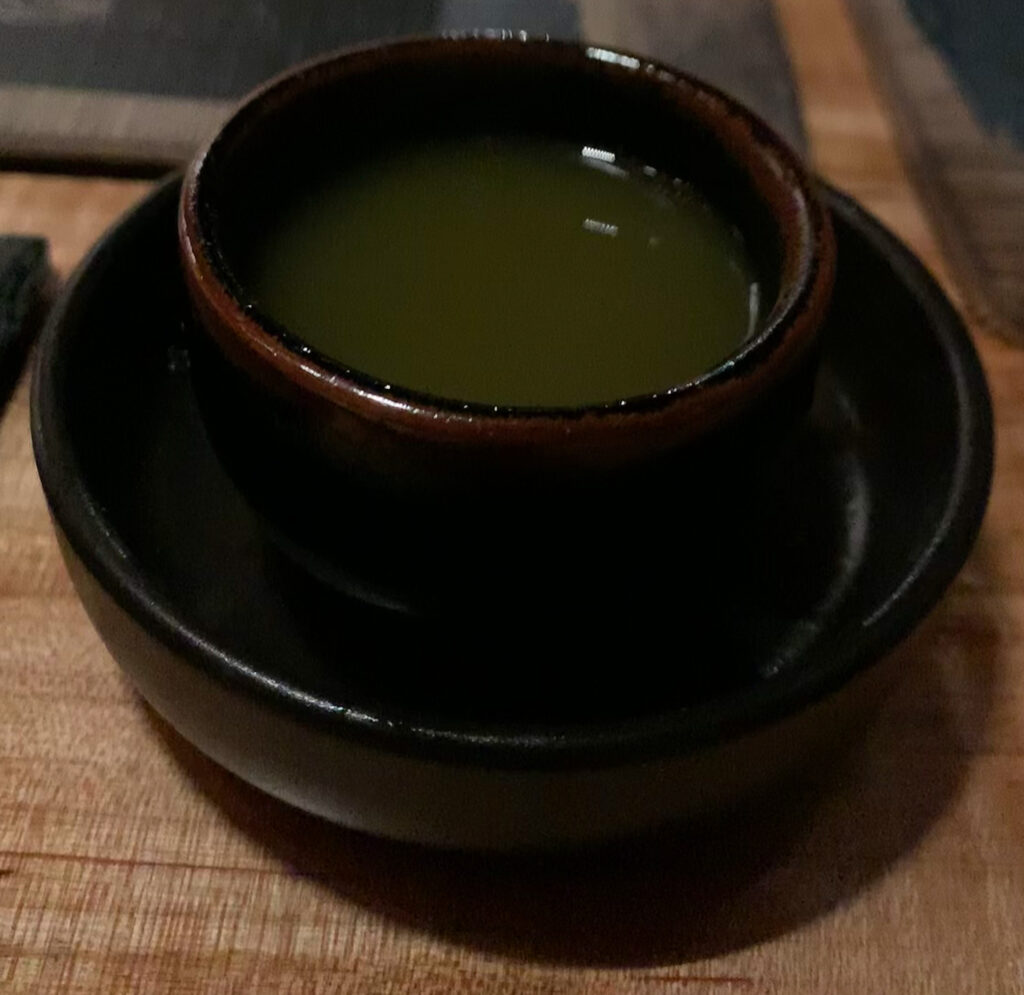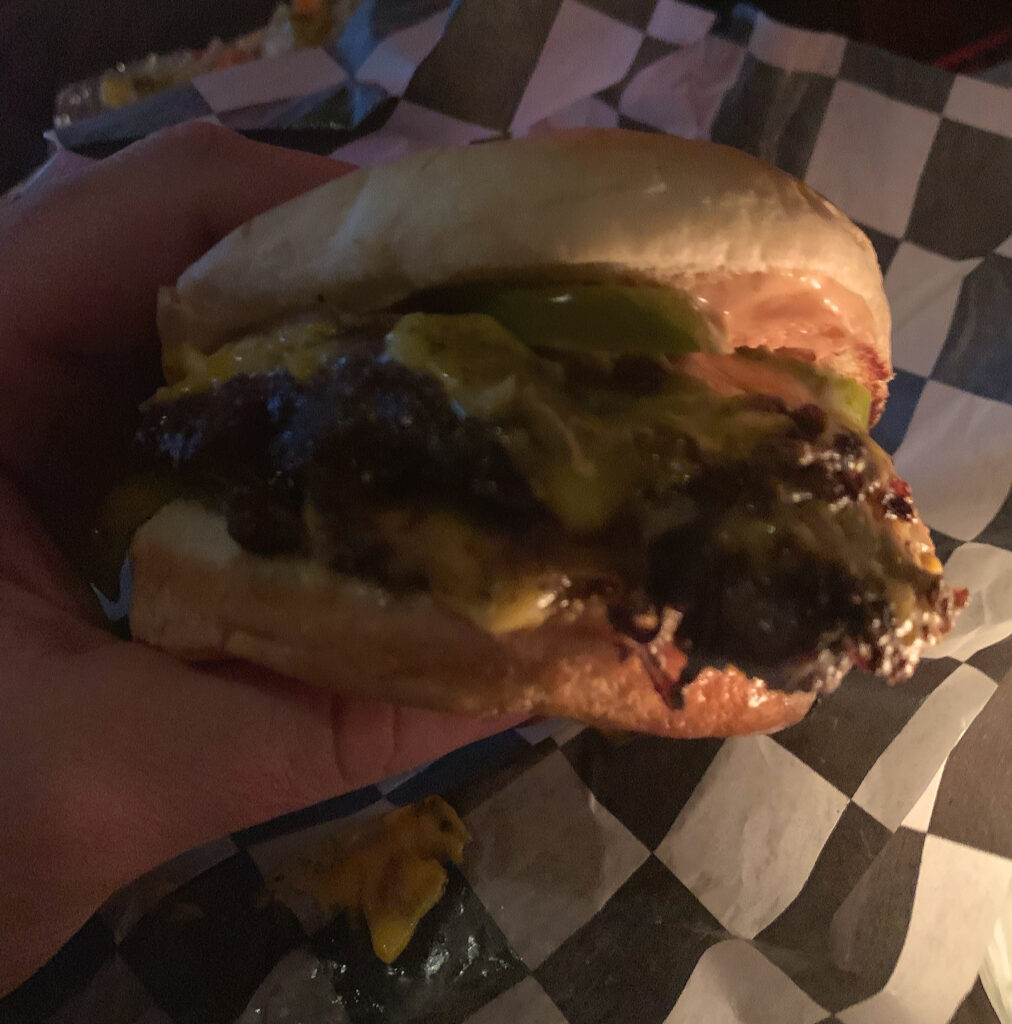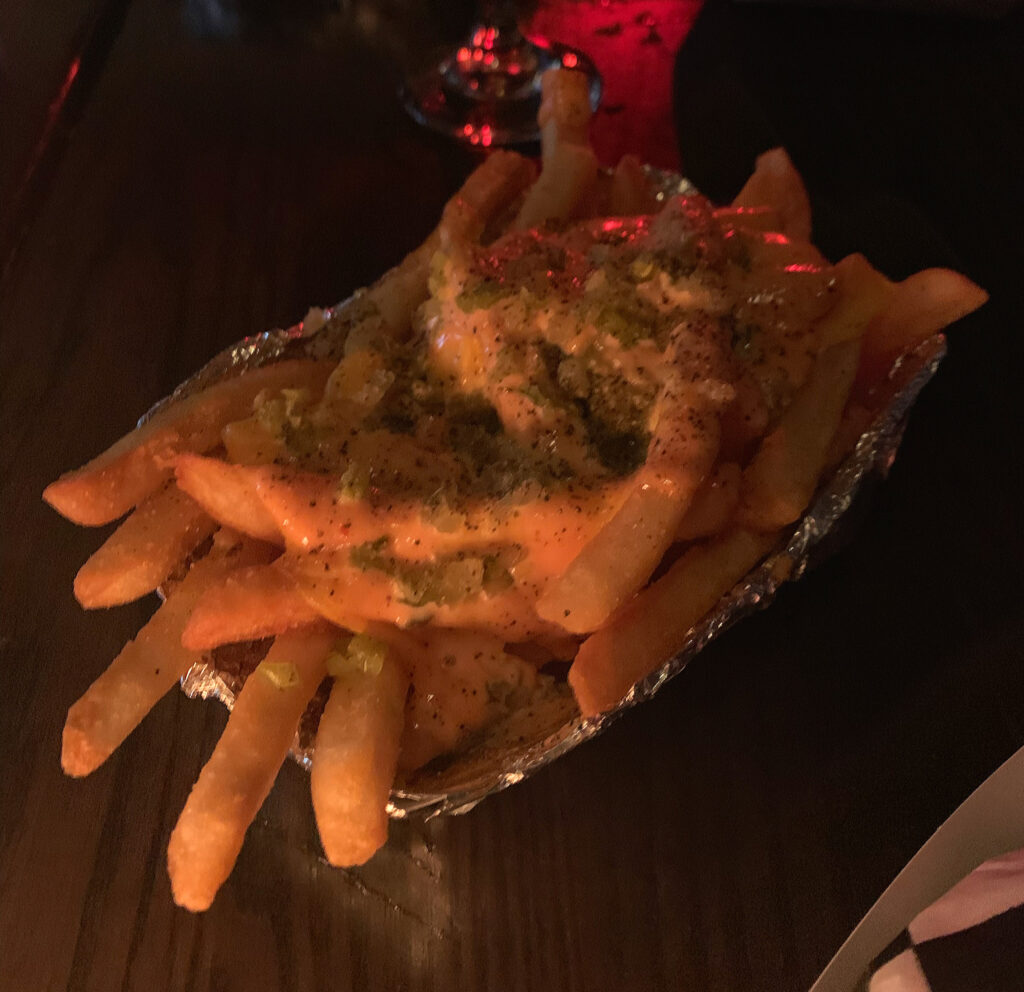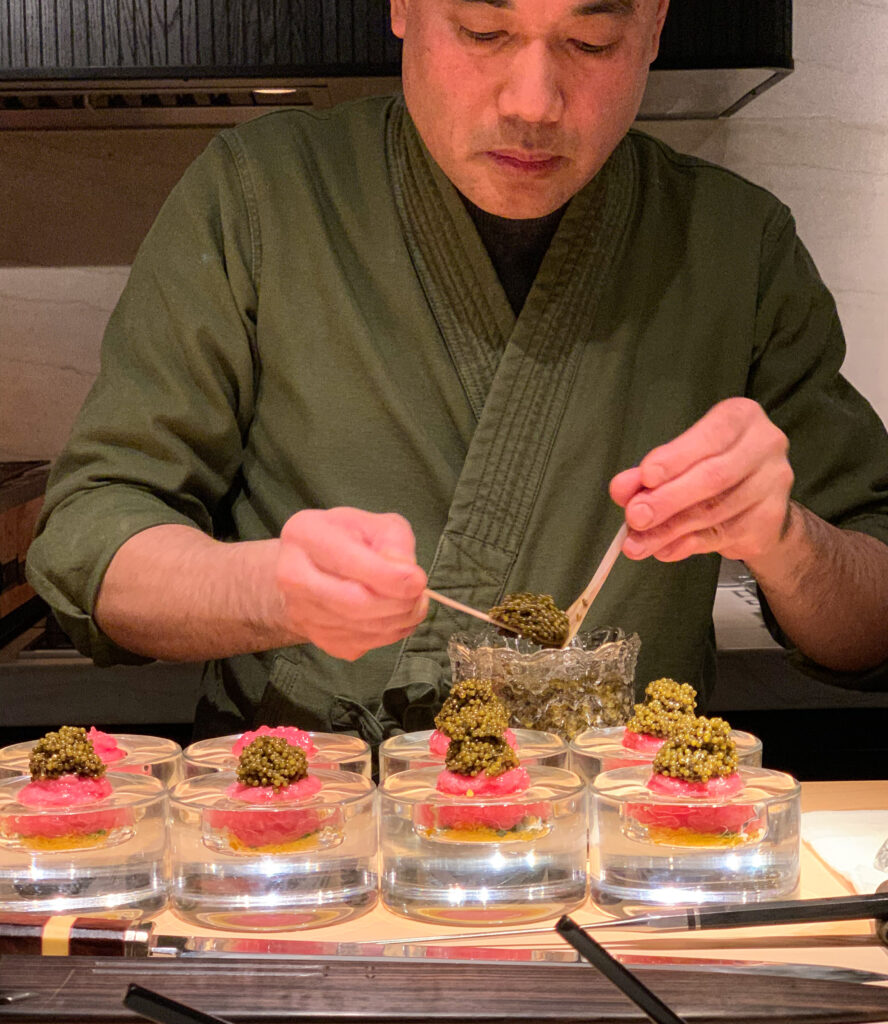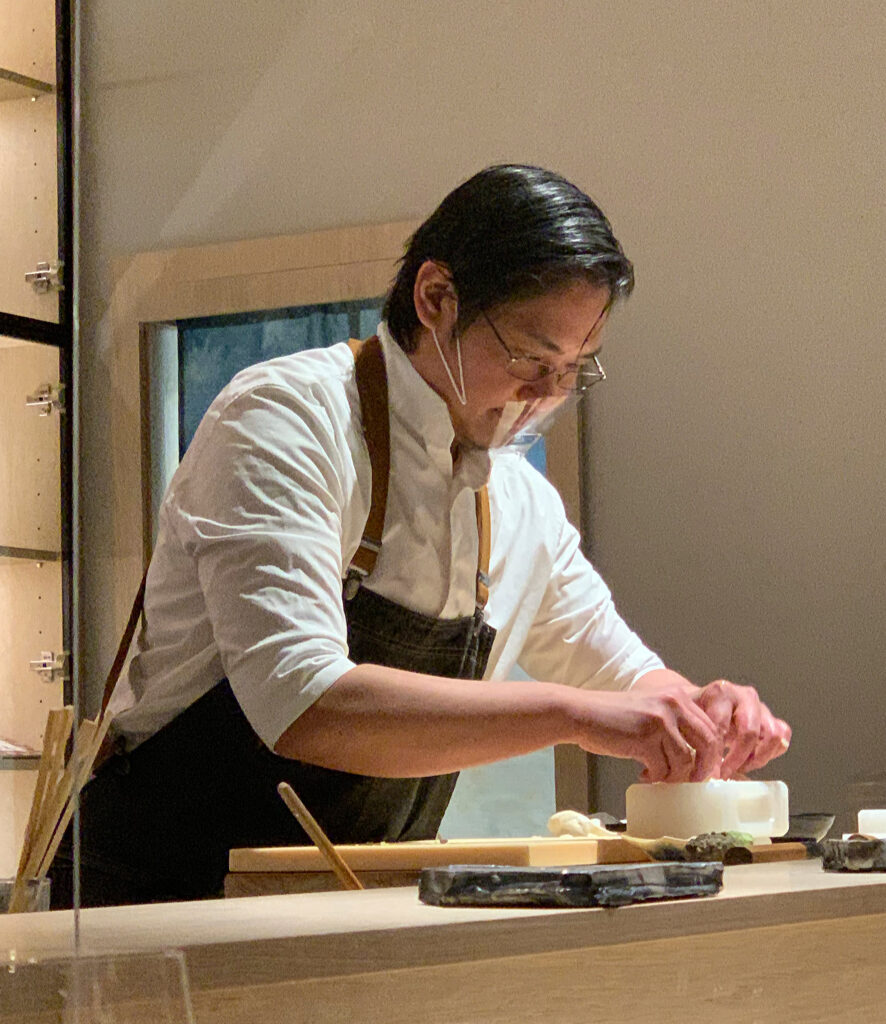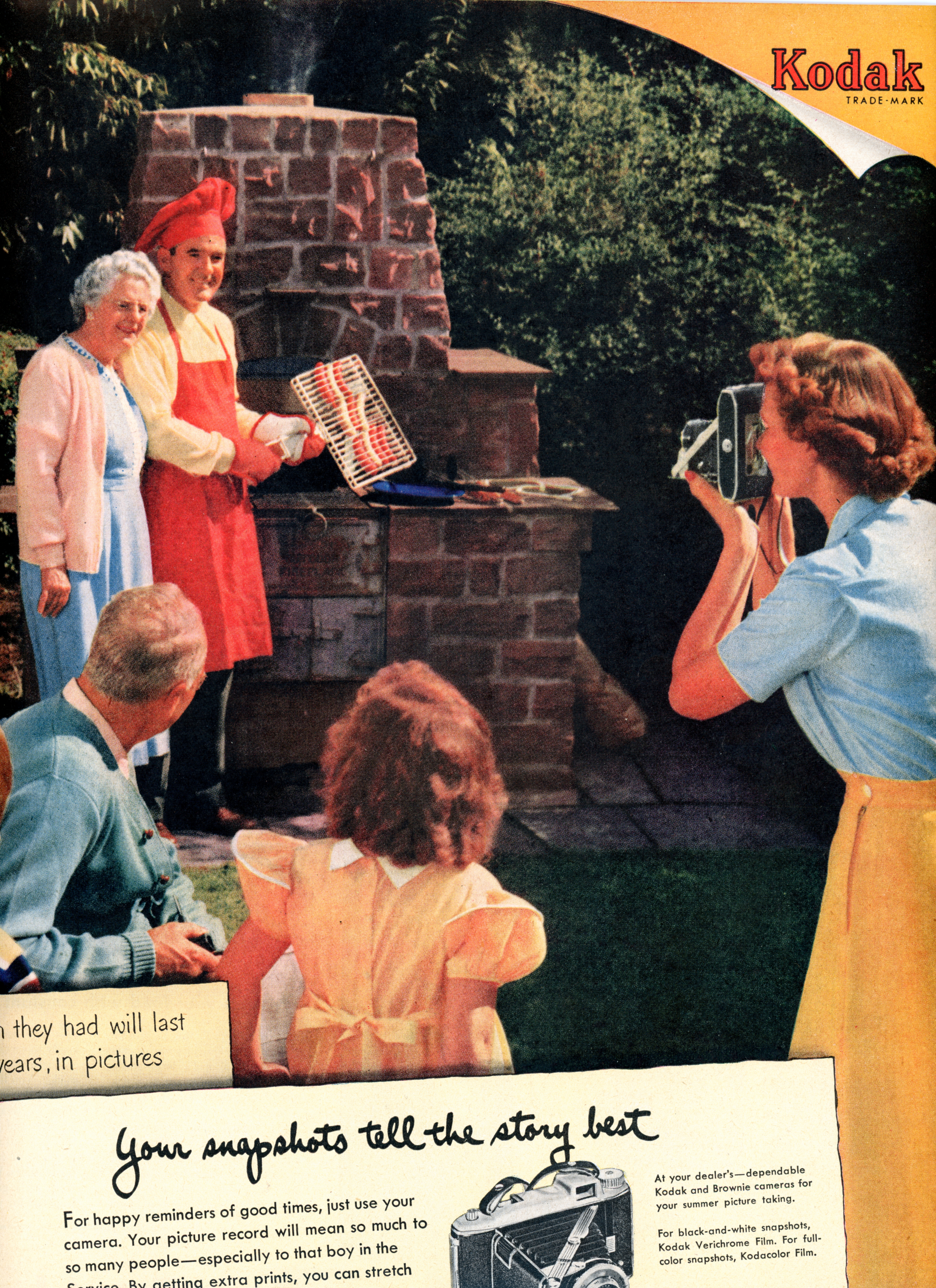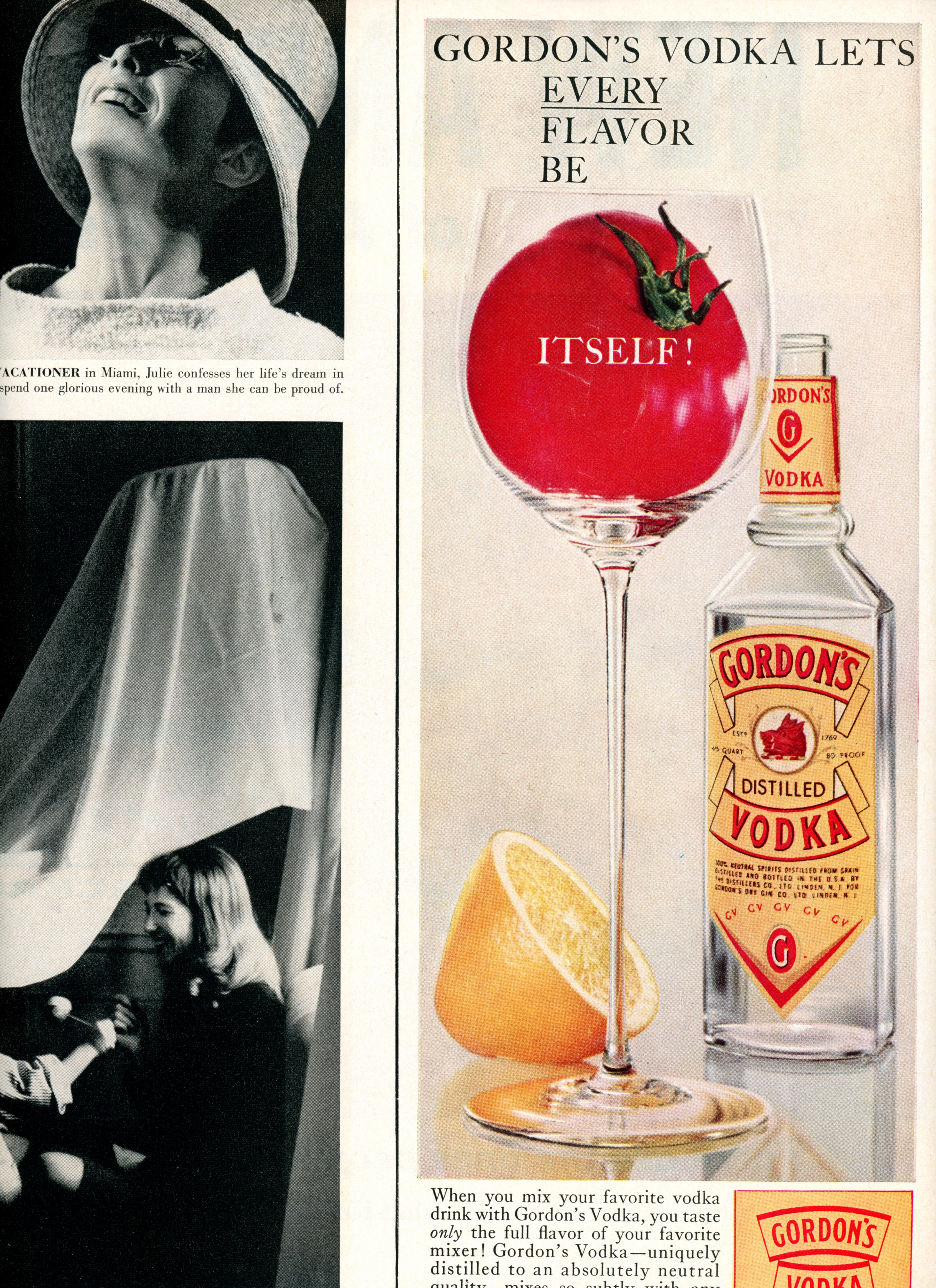Following your recent exploration of the omakase genre, it seems natural to keep your palate trained on the craft of sushi. Nigiri, sashimi, maki, and the like are defined by small degrees: intricacies of flavor and texture that are more easily judged with reference to some other restaurant. Plus, the price stratification within the genre—it must be said—invites comparison. Any chef working in this format will have their fish and rice (and overall experience) measured against the city’s other options as consumers look to discern the right sweet spot for their palate and pocketbook. Thus, it is always worthwhile to lay some of the groundwork for other diners—to dig into the essential differences that define each concept in the rigid (relative to fine dining writ large) world of omakase.
Sushi by Scratch Restaurants is Chicago’s newest entry in the genre, having only opened in February. The concept—with other locations in Austin, Los Angeles, Miami, Montecito, and Seattle—is an import. It’s one of those businesses that, like Sushi Suite 202, reimagines “underutilized spaces.” Your first instinct was to turn your nose up: why bother investigating this disposable interloper when local chefs, manning the same counter each evening, are better worth supporting? The Windy City has no need of opaque national luxury brands when omakase, at its very best, should offer an intimate, singular encounter with a craftsperson who owns and operates the enterprise.
Nonetheless, Sushi by Scratch Restaurants’s Montecito location earned a Michelin star in 2021 and 2022. That pedigree would ensure the restaurant, in a Midwestern city lacking many Bibendum-approved examples of the craft, made a splash when it opened its doors concurrent with this year’s Valentine’s Day celebrations. The omakase has immediately become one of Chicago’s toughest reservations, with all of April’s tickets (save for a couple spots for single diners at 9:30 PM) selling out within a couple days of release and May’s tickets, even more impressively, being depleted in just a couple hours. That amounts to something like 660 seats (each month) that have been filled while Mako, touting its accolades and home-field advantage, struggles to fully book (not counting its tables) a fraction of that. John Shields—the most influential chef of the city’s post-Trotter, post-Alinea era—has given Sushi by Scratch Restaurants his stamp of approval (at least in terms of posting an Instagram story). And the concept, as you dug into its history more, can actually claim some intimate connection to its newest home.
But where to begin? Well, with Phillip Frankland Lee of course—Sushi by Scratch Restaurants’s chef/owner (alongside wife Margarita Kallas-Lee). Like any good founder of a sprawling luxury brand, the man is a living, breathing billboard for his business: a tatted, bearded, timepiece-clad impresario of new-age gourmandise. Lee is polished, no doubt about that. Some might even say charming (and understandably so). He competed in the 13th season of Top Chef, finishing in eighth place, and can count a dozen appearances (both as contestant and judge) across the Guy Fieri properties Guy’s Grocery Games and Tournament of Champions. Throw in a couple spots on Cutthroat Kitchen and Chopped, and you have the makings of a chef that is enviably media-savvy.
You do not fault Lee for being a gifted entertainer (a trait whose increasing importance, vis-à-vis modern chefdom, Gordon Ramsay reminds of us with every passing year and subsequent Botox injection). In fact, showmanship runs in the family: the chef’s mother is an acting coach, his biological father is a musician, and his grandfather (whom Phillip was named after) was two-time Emmy and Tony Award winner Phil Silvers (known as “The King of Chutzpah”). True to form, Lee—“who began acting in commercials as a child”—was characterized by some as “this season’s villain” when he appeared on Top Chef. You cannot say you’ve watched the show yourself, but it is worth mentioning that the contestant claimed his biggest competitors that season “were the judges, or whoever it is that decides who wins and loses.” Lee felt his biggest challenge on the show was “knowing that no matter how hard I would try or how good I would cook, I was not going to win.”
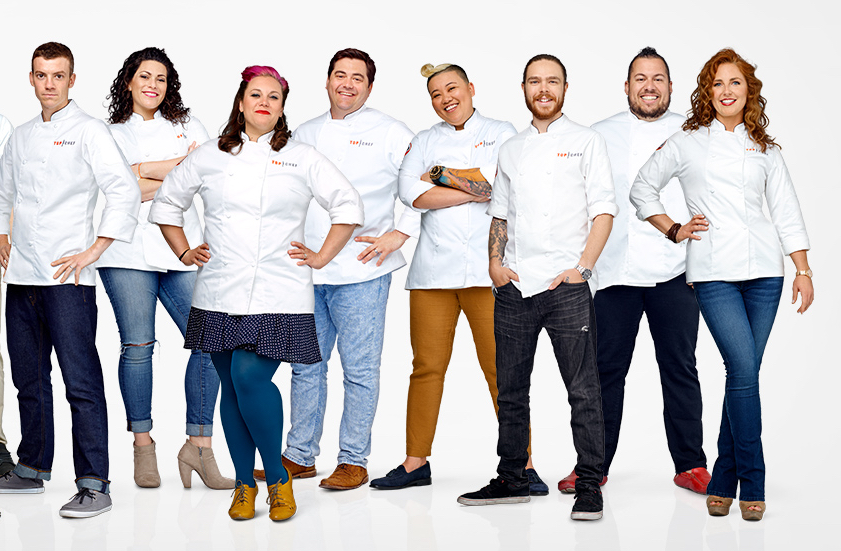
This is hardly the kind of attitude Chicagoans associate with local Top Chef stars like Sarah Grueneberg (of Monteverde) or Joe Flamm (of Rose Mary). Yet, in a way, you also sympathize with Lee. Reality television has little to do with reality, and you are not sure Bravo’s longstanding judges have done anything to establish a sense of credibility beyond occupying their positions (and associating themselves with actual talented chefs) for so long. They, as conductors of the show, are entertainers in their own right. Provoking a contestant that is already prone to self-aggrandizement seems like a surefire way to secure that most delicious of audience segments: hatewatchers. And Lee, to his credit, has not harped on about his Top Chef experience all that much since. The chef can be forgiven for voicing his frustrations (well-founded or not) in the immediate aftermath of elimination.
Yet, since Lee has such a nicely manicured media profile these days (one which you will engage with in just a moment), it is worth dwelling on just one more salvo of criticism courtesy of a fellow anonymous food writer. You do not do so out of any personal dislike for the chef (an impartiality that this particular author, you believe, shares). Rather, the power of public relations ensures that any meaningful critique of any given career, unless someone’s conduct is inescapably controversial, finds itself effectively buried under a mountain of fluff. Criticism should not trade in gossip, but consumer advocacy should also not rely upon “official” narratives spun by “journalists” who have a vested interest in pumping out bland promotional content spoon-fed to them by marketing professionals. So long as Lee is able to spin his tale the way he wants within this article, it seems fair to engage with an intelligent counterpoint. This seems like the only way to ensure that chefs are not unduly advantaged by their media mastery, a dimension of the craft that—in your perfect world—would not exist.
According to this more critical perspective’s reading of Lee’s time on Top Chef, the Sushi by Scratch Restaurants honcho was, indeed, the victim of editors who “really condense[d] all of his worse [sic] traits and statements that are usually a bit more spread out.” The chef can be forgiven for being “a bit prone to grandiose drama” and “thus obviously a self-promoter.” However, the writer—who claims to have “done either detailed profiles, dish stories, Q & A or first job stories with a number of other former Top Chef contestants” argues that Lee’s “inability to take constructive criticism is a real trait, not just editing for TV.” Further, rather than being “open and responsive to constructive criticism,” he “likes to portray himself as a victim to generate sympathy, which in turn only generates something a lot worse than honest criticism…false praise.” This leads to a “grandiosity and bombast in particular about his culinary abilities” that, in the author’s opinion, “are very mediocre.”
These negative traits ultimately work to shield “Lee’s other huge downfall,” a “lack of substance.” During the course of the season, the chef’s “constant mentioning of…doing food from his restaurants” was not just “self-promotion.” These “incessant comments,” it is argued, served to mask “very limited culinary skills.” Lee “really doesn’t know how to cook much other food than what he’s already cooked in his restaurants” because “he never spent enough time in other chefs’ kitchens to gather a wide array of culinary tools.” Instead, he rushed “to open his own restaurants” and do “whatever he wants.” Ultimately, it is claimed, Top Chef only kept him around so long “for production value.”
The real teeth underlying this criticism—and certainly its most speculative and provocative aspect—has to do with Lee’s actual restaurants. The author argues that the chef’s first concept, Scratch | Bar, “was originally a collaboration…[with] two other chefs, Joel David Miller and Ryan Duval.” When “Lee’s mother gave him the money to partner with Lee’s original business partner in Beverly Hills and place this concept [later moved to Encino] in that business partner’s existing restaurant, Lee took ownership of the concept and made it about himself.” At that point, “Miller became the chef de cuisine and Duval the sous for a year before they left and took the entire kitchen crew with them to The Wallace in Culver City.” From this author’s perspective, “Miller and Duval conceived, developed and cooked most of the better dishes at Lee’s restaurant” while the latter chef “seems to prefer schmoozing in the front of house rather than working the pass or on the line in the kitchen.”
You still question whether it is fair to include this kind of speculation within your article and can only really stomach doing so because its author writes so prolifically on more highbrow food topics. You also did not stumble upon this (admittedly somewhat hack psychoanalytical) perspective until you had already visited Sushi by Scratch Restaurants twice and, subsequently, maintain your initial opinion that Lee is a talented performer. However, if you are to write the most piercing analysis possible, it seems right to ask if he is an entertainer masquerading as a chef. This should not, in the interest of being fair to Lee, be all that hard to disprove if his sushi shows even a glimmer of quality. But, to reiterate, it also seems like the fairest posture from which to judge the work of a professional that seems to have enjoyed certain advantages his fellow craftspeople have not. Chicago, certainly, should never allow interlopers with concocted reputations to steer its dining scene toward an appreciation of frippery. Nonetheless, you will table all this cynicism for now and engage with Sushi by Scratch Restaurants’s narrative as Lee tells it.
As the story goes, Phillip Frankland Lee grew up “as an avid eater in the valley of Los Angeles.” The “earliest memories of his love of food” can be drawn “from a home video of his 3rd birthday.” Therein, the future chef’s father tries “to justify to his mother why he bought his young son a chef’s knife,” relenting that “I don’t know what else to get him; all he likes to do is cook.” Lee would grow up “in California’s San Fernando Valley as the oldest of six children” and the one that would handle all the “kitchen chores.” This “instilled in him a sense of purpose and a love of cooking at an early age,” one that would eventually lead him to drop out “of high school to be in a band and find a way to pursue his passion” for cuisine. He “attended Le Cordon Bleu College of Culinary Arts in Pasadena” but “left after three months, feeling that real world experience in the restaurant business would best suit his short-term goals.”
Thus, Lee “began his career as a dishwasher [for his godmother’s catering company] at 18 and quickly rose from the ranks working under some of the best chefs in the country.” That included Quinn Hatfield, whose restaurant Hatfield’s earned a Michelin star in 2009 as part of Bibendum’s short-lived (now restored as part of a broader California edition) Los Angeles guide. Lee also worked for Stefan Richter, runner-up on season five of Top Chef. Through these experiences, the future Sushi by Scratch Restaurants proprietor “became a Sous Chef at 21” He decamped to Chicago in 2010, working as a chef de partie under Laurent Gras at L2O then “completing a stage at Alinea” and helping the group open Next.
In the fall of 2011, Lee returned to Los Angeles looking to apply his “training and experience” within “what he saw as a niche.” The chef “launched a food delivery service together with his then fiancée Margarita [Kallas]-Lee,” serving $200, 10-course tasting menus in which they “set up everything in the homes of the customers.” The couple, it should be mentioned, first met each other in seventh grade and can claim similar, winding paths to the kitchen. Kallas-Lee, “originally from Latvia, grew up with grandparents who indelibly imprinted on her a love of cooking.” Upon moving to the United States “as a young teenager,” she “worked as a runway, print and commercial model while feeding her passion for cooking by catering events around Los Angeles.” In 2011, Kallas-Lee “answered the lifelong call of a culinary career, joining the historic D’Cache in Toluca Lake as pastry chef.” This led her to reconnect with her future husband and, as it happens, did not stop her from booking appearances on shows like New Girl, NCIS, and The Newsroom from 2013-2014.

Wolf Cuisine, as the “food delivery service” was called, offered “a brilliant and innovative dining solution concocted by alpha chef Phillip Frankland Lee.” More specifically, it would claim to offer “whimsical arrangements and adventurous pairings bound to curb even the most ravenous appetite.” The concept’s opening menu is still accessible via social media (and even exists in video form), comprising dishes like “Oyster” (with lime panna cotta, mignonette, and American caviar), “Green Lip Mussel Cebiche” (with avocado mousse, uni, salmon roe, and pickled onion), “Sweet Onion Soup” (with passion fruit), “Scallops” (with foie gras and cauliflower), and “Dry Aged New York [Strip]” (with Peruvian potato, asparagus, and tomato). Truth be told, while the business seems a bit tacky on the surface, the fine dining delivery idea must have been a bold one for Los Angeles in 2012. The dishes, too, demonstrate an admirable degree of creativity for the era without veering off into anything too strange.
It is hard to find much in the way of reviews for Wolf Cuisine during the period it operated. One customer, on Facebook, termed it “the most delicious haute cuisine I had outside of Japan” with raw fish “so fresh it melts in the mouth.” However, the business’s Yelp page only features a trio of one-star ratings complaining about a holiday Groupon deal (that discounted the meal’s $200 price to $99). Users note “horrible customer service & business ethics” in attempting to schedule their delivery, terming the experience “frustrating and aggravating” despite calling “3 weeks before the desired date.” In one case, “the two person coupon turned into 2 people sharing one meal” as Wolf Cuisine “wanted us to buy another for two meals for two people.” While this haggling felt “really sleezy [sic]” and left one reviewer (observing that “the monthly menu never changed over 4 months”) feeling “not even sure this business is real,” another conceded “the food was OK and the idea and presentation were ‘fun’” despite the “lack of responsiveness.”
Whether the experience provided—at that eyewatering $200 price point (equivalent to about $270 today)—was ultimately good or bad, Wolf Cuisine represented an important step in Lee’s career. It marked his move from “dishwasher at 18” and “Sous Chef at 21” to “Executive Chef at 24” and the beginning of a longstanding professional (and personal) partnership with Kallas-Lee. It also laid the foundation of Lee’s larger media profile thanks to features in The Huffington Post and Eater LA that touted the cleverness of the concept (and its chef’s L2O and Alinea pedigree) without passing further judgment on how the food actually comes together. (The latter piece comes courtesy of none other than the queen of conspicuous consumptive “foodie” shilling herself: Kat Odell. One pointed comment states that Lee is “as much a chef as Kat Odell is a legitimate journalist.”)
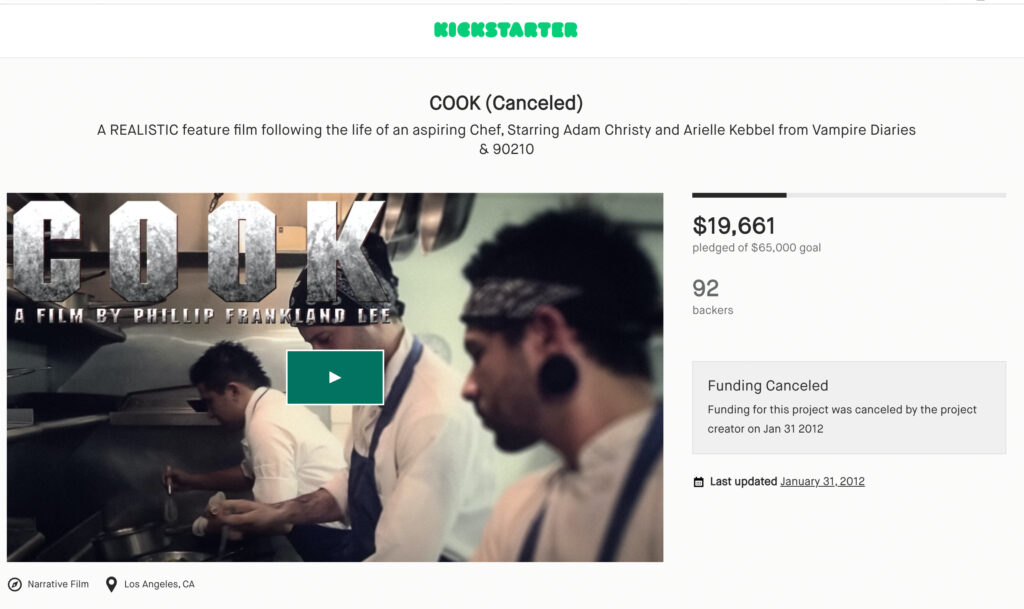
Concurrent with the operation of Wolf Cuisine, Lee would launch a Kickstarter for his movie COOK. The “film,” written and directed by the “award winning” chef, was described as “an intimate story taking audiences into the battlefield of the professional kitchen exploring the intertwining passions of FOOD, LOVE, and SEX.” At the time of the fundraiser’s launch, the project boasted “a full cast and crew of industry professionals excited to go on this adventure” along with “a distribution deal for a wide theatrical release” secured (along with “half” the budget through “private investors”) on the basis of the script and idea “alone.” COOK would only raise $19,661 of its $65,000 goal—meaning the Kickstarter funding was cancelled and the project never came to fruition—but a teaser trailer survives.
By the end of 2012, Wolf Cuisine came to an end as Lee set his sights on the next step of his career. Looking back, the chef would term the “unconventional venture” as “successful” but said “it was a lot of work and he was anxious to open his own restaurant in L.A.” The first move in that direction would come with the announcement (once again from the ethically bankrupt Kat Odell) that Lee dropped “Eater a note explaining that he has accepted the title as executive chef at D’Cache, a small Basque restaurant in Toluca Lake.” Readers might recognize the name of the restaurant as the “historic” place where Kallas-Lee “answered the lifelong call of a culinary career” as pastry chef in 2011. Lee would look to “re-conceptualize” D’Cache’s “existing bill of fare” and try to “bring better cuisine back over the hill.” He would at least try to do so before opening “a full service restaurant under his direction in West Hollywood” the following summer. (Another thorny comment states “unfortunately for all involved, Phil cannot and will not threaten anyone with good food.”)
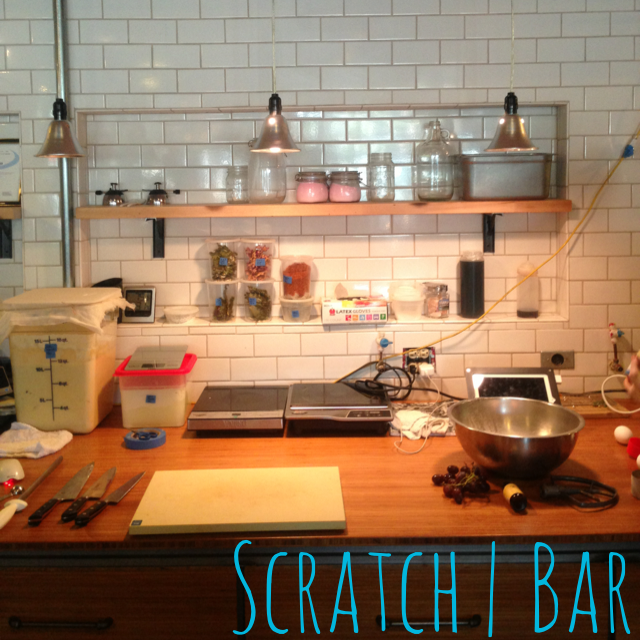
Lee would reach the mountaintop—“chef and owner at 25”—with his “first solo restaurant” in April of 2013. Scratch | Bar would begin as a pop-up within L.A.’s Tiago Espresso Bar + Kitchen but, after a few months, found its own permanent space. With chef de cuisine Joel David Miller (of Cleo), sous chef Ryan Duval (of Animal), and pastry chef Kallas-Lee as part of his opening team, Lee served inventive à la carte fare like “Pork Belly & Raw Oyster,” “Puffed Smelt & Bone Marrow,” “Pig’s Head,” “Warm Hamachi w/ Sweetbreads,” and “Local Squid & Mushrooms” while putting the finishing touches on a “five seat chef’s tasting bar” where he planned to serve a 12-course menu. When this counter eventually opened in December of 2013, it would boast room for 11 diners per seating with “12-15 plates priced at $111” comprising a mix of Lee’s “signature dishes and specials which change nightly.”
Nobody less than Jonathan Gold of the Los Angeles Times would review Scratch | Bar in March of 2014. The dearly departed critic would term the restaurant “a welcome bit of comic relief” in a “restaurant scene dominated at the moment by extreme localism, modernist trickery and the marriage of European and Asian technique.” Gold likened Lee to “the wiseguy telling jokes in the corner while the popular kids forage miner’s lettuce and make buttermilk cheese with a centrifuge” while sagely observing that “hyper-intellectual cuisine has its place, but parody can be more fun.”
Of the fare, the critic singled out “canapés of sweetbreads, tiny flatbread and maple vinegar” (titled “’Chicken’ ‘n’ Waffle”), a “Smoking Goat’s Milk Cheese” (“dry, crumbly fresh cheese” with puréed olives, toast, and “smoldering dried timothy grass”), and the “signature presentation” of “Squid in a Box” (with “fried potato” and a “tar-black purée of charred eggplant”) for praise. Other experiments, like combining “the squishiness of long-braised pork belly” with “the briny creaminess of uni” or a “corn-infused custard spiked with king crab meat” do not work. However, Gold says “you can see the reason behind” the pairings. Ultimately, he is “not sure Lee is aiming toward a higher end at Scratch Bar,” but the chef’s “food tastes pretty good, it is attractively presented and it makes you smile.” “This,” the critic says, “may be enough.”
Gold was right to note that Scratch | Bar’s “tiny portions and militant whimsy might enrage a certain kind of customer,” for Yelp reviews from that era are split between a majority of four- and five-star ratings and a notable minority of one- to three-star evaluations criticizing strange flavor compositions and an unshakeable sense of hunger. Still, the restaurant was clearly (at the very least) a modest success, and Lee—with wind in his sails—set about opening a second concept in September of 2014.
The Gadarene Swine, as his next venture was called, represented the chef’s Biblically named “return to the Valley” (where he once worked at D’Cache) via a “near-vegan restaurant” (compromising on the use of honey) with an eight-seat chef’s counter and a few scattered tables. It sounded a lot like Scratch | Bar and would allow Lee, once more, to make “much of the food right in front of the guests” in accordance with an “all-vegetable” ethos and that evening’s “whims.” However, the chef wanted to avoid the word “vegan” because the term “has become so politicized” and he was looking to cook for a broader audience than what it might imply.
The opening menu included dishes like “Lemon & Pistachio Kale Chips” and “Olive Stuffed Olives” (both taken from Scratch | Bar) alongside new creations like “Blackened Cauliflower,” “Roasted Mushrooms w/ Burnt Sweet Potato,” “Crispy Lollipop Kale,” and “Vegetables in a Box” (a variant of the signature “Squid in a Box.”) Yelp reviews of the concept would, once again, be split between a majority of positive (four- and five-star) reviews and a vocal minority (in the one- to three-star range) terming the menu “pretentious,” the portions “cartoonishly tiny,” and everything tasting “EXACTLY the same.”
Nonetheless, Jonathan Gold would review The Gadarene Swine a couple months after opening and term it maybe “the first purely vegan restaurant ever opened by a frankly carnivorous chef, an animal-free zone populated by hummus with seaweed chips served in clay planters and dips served in simulated birds’ nests.” Rather than embracing “alternative proteins” or indulging in “vegetable worship,” the critic contends that “Lee’s cooking is basically the same as it is at Scratch Bar, except without the meat: housemade everything, tons of pickles, lots of crunchy dehydrated vegetables, pistachios everywhere, and simple flavors enhanced with olive oil, lemon and salt.”
More specifically, Gold characterizes the “Vegetables in a Box” as “basic yet complex, depending more on the delight of the presentation than on the mash-up of flavors.” Lee’s “PB&J” (“churned peanut butter topped with smashed prunes, thinly sliced onions, pickled vegetables and arugula”) is “like what would happen if your dad absent-mindedly garnished your lunchtime sandwich as if it were Black Forest ham on rye.” But the critic, at least, “liked the sweet, deep-fried olives a lot” in an overall lukewarm review that left him thinking The Gadarene Swine “is a complicated place.”
2015 would see Lee named as one of 10 U.S. finalists in San Pellegrino’s “Young Chef 2015” competition (he would lose to Vinson Petrillo of Charleston, SC) and, otherwise, continue to run both his concepts until the start of a rather strange saga. In the middle of July, Scratch | Bar closed “overnight” as the restaurant was “nearing the end of its lease” and the chef sought to relocate the “2.0 version” to a “hipper part of town.” Fair enough, you say, but—just a week later—“Someone Reopened Scratch Bar in Beverly Hills, But Didn’t Tell Phillip Frankland Lee” (as the Eater LA piece was titled). The revived concept, later termed an “imposter,” was helmed by Dario Danesh, “Lee’s longtime (former?) partner in the…space” and a partner in The Gadarene Swine to boot. When a Yelper complained about a subpar experience under the management, Lee personally responded and noted Scratch | Bar had been reopened “without…[his] consent.” The chef graciously offered the aggrieved diner a free meal at The Gadarene Swine to make up for the confusion. However, the “imposter” concept would persist until October of 2015 when it finally closed.
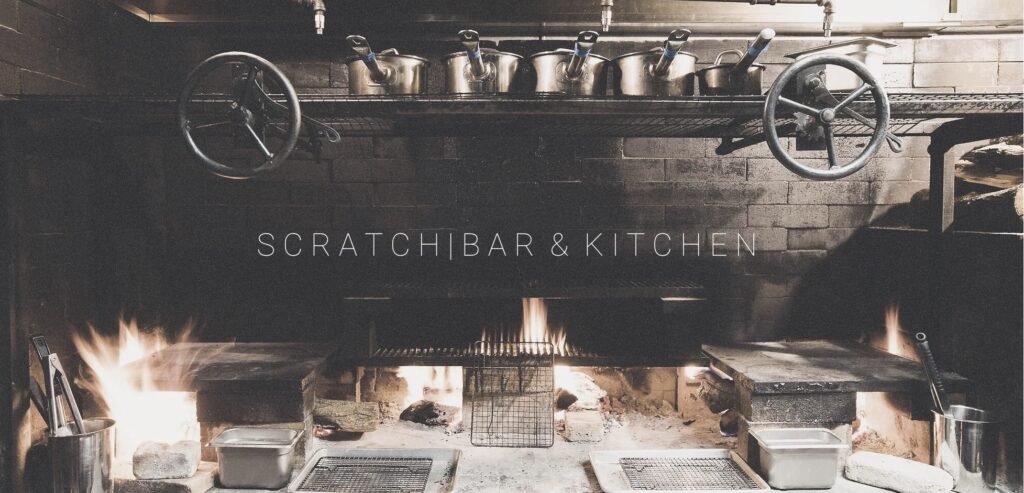
That month, nonetheless, would be a great one for Lee. He would formally announce the new location of Scratch | Bar (now formally titled Scratch | Bar & Kitchen) on the second floor of a “high-volume shopping center” in Encino. And, even more consequentially, the chef could announce that he would be competing on the 13th season of Top Chef. You have already mentioned some of the reaction Lee provoked via his appearance on the show, but—even in that “villain” role—the boost to his public profile would have been significant. The season aired between December of 2015 and March of 2016, ending just in time to see Scratch | Bar “2.0” receive its first professional review.
The concept had actually opened in December, ensuring that Lee could make the most of his Top Chef run, and the chef’s television appearance would strongly color LA Weekly critic Besha Rodell’s two-star (out of five) review. In the piece, the author mentions season six contestant Michael Voltaggio as a point of comparison with her subject. Both he and Lee (who “played the part of villain perfectly, either through force of personality or force of clever editing”) are said to embody the image of the “tattooed badass” redefining “American culinary modernism.” The two appear to be “cut from the same cloth,” but the latter complained about having to “cook food to make the judges happy” (exiting mid-season) while the former won Top Chef feeling “it was just about cooking good food.” Voltaggio, like Lee, “may give off the appearance of doing whatever the fuck he wants,” but “underneath it all is a rigorously trained chef, one who understands the rules before he breaks them.”
This forms the core of Rodell’s criticism of Scratch | Bar, the “conundrum” that “lies at the heart” of the concept: “Can a chef really just do whatever the fuck he wants — with no classical training, no years spent working his way up through the ranks? Should the truly talented be able to fly free early and without constraints?”
The critic singles out “a sake shooter layered with sea urchin and avocado mousse, with a green mussel and a sliver of serrano chili speared across the top” as being “assertively sweet” and setting off the seafood “in the most disconcerting way possible, like a dirty martini garnished with a maraschino cherry.” A “bowl of popcorn touched with butter and thyme and salt and, yep, sugar,” she says, “doesn’t work any better.” There’s even an “insane ode to lowbrow sushi rolls”—”made up of a base of sushi rice topped with torched sea urchin, nubs of pork belly, diced cucumber and tons of salmon roe”—that Rodell cannot decide is “brilliant or an abomination.”
While sugar “is an issue throughout many dishes,” there are great “successes” when “Lee resists his obviously strong urge to combine dinner and dessert.” These include “soft roasted salmon…with beautiful rainbow carrots, salmon roe and daubs of yogurt,” “torched escolar over sunchoke puree with puffed amaranth…[and] nubs of sweetbreads,” and more salmon roe “used on a dish of house-made chorizo over a smear of mushroom paste.” Even “some of Scratch Bar’s cheeses are pretty good.”
Rodell finds “there’s something genuinely heartwarming about the enthusiasm and sense of adventure that drive this troupe of cooks” who “make everything, including bread and charcuterie” by “scratch.” But she contends, for “many kinds of culinary techniques, there really is no substitute for learning under a master, for being an apprentice rather than a wunderkind. This shows itself most obviously with disciplines that are entire professions: the aforementioned charcuterie (which in the case of Scratch Bar is mainly smoked or cured pork that turns out far too salty and slick in all the wrong ways), as well as baking (the bun on the Scratch Bar burger is supposed to be brioche but is dense and almost crumbly and overwhelms the other ingredients).”
Lee “appears to be someone who believes that training in those fields is optional, that some chefs can succeed through the sheer force of talent.” But, in doing so, the chef “does a disservice to the very profession he aims to glorify.” He is “so wrapped up in boundary-pushing that he can’t taste the flaws in his own cooking” and ultimately lacks “training and time and the ability to recognize when people ‘not understanding’ your food is actually just the food not tasting very good.”
This review, while quoted at length, strikes at the core of the criticisms levied at Lee for his time on Top Chef and (via comment sections and Yelp) the nature of his cooking. You think it provides a particularly useful paradigm with which to judge Sushi by Scratch Restaurants, especially when Rodell concedes “there’s plenty that tastes good at Scratch Bar” along with “inventiveness and excitement and food that could only come from the freedom Lee has given himself and his crew.”
The chef, true to form, took to social media to rail against the negative review, perceiving it as more of a “personal take on me as a professional” (based on Top Chef) than a careful evaluation of “cookery or technique.” He felt “dumbfounded and a bit let down” to see her not mention “desserts, drink options, hospitality, or many of the things you would look for in a ‘review’ of an establishment” but invoke the trailer to Lee’s COOK project (as you yourself did). Personally, you think Rodell was fairly specific about the flaws in some of the dishes and the flawed attitude that informs how crafts like charcuterie and baking are approached at Scratch | Bar. Given that Lee has benefited from an uncommon degree of media attention since the very start of his career, it seems proper (as you have already done) to call his manicured image into question. “Chutzpah” (a term that Rodell invokes in her review) has its place in inspiring diners’ confidence, but no good critic should allow naïve consumers to be deceived by a dilettantish approach to craft. Insofar as she actually noted problems with the cheese, charcuterie, and bread, it is right to take aim at a “persona” that seems unwilling (or unable) to hone his techniques in a traditional fashion. Rodell certainly shouldn’t stand by and allow someone to transform laziness or arrogance into a virtue!
Despite the negative evaluation from LA Weekly, Yelp ratings of Scratch | Bar from the time show the usual pattern: a vast majority of four- and five-star reviews juxtaposed by a notable minority of one- to three-star ratings finding the experience “loud, crowded, and uncomfortable” with “pretentious” food lacking “in diversity and quality ingredients” for the price.
Though The Gadarene Swine would close in July of 2016 (due to lingering problems with former business partner Danesh), Lee had signed on as a chef of “longtime Los Feliz Mexican dining anchor” El Chavo in May and could tout a forthcoming “Scratch Bar adjacent noodle joint,” titled Oh Man! Ramen, in November. The latter spot would fall through but be replaced by a “seafood-focused venture” titled Frankland’s Crab & Co. On the other side of Scratch | Bar, the chef would open Woodley Proper, a “full-on cocktail den” offering a “proper dining at the bar experience” like towers of “house-cured charcuterie, Scratch Bar x Stepladder Creamery cheeses, and chilled shellfish.”
Woodley Proper and Frankland’s Crab & Co. would open in April and May of 2017 respectively. The latter concept would survive less than a year, closing (with a three-and-a-half-star Yelp average) to “make room for a lounge area for Scratch Bar.” Woodley Proper would last a little over two years (and can claim a four-and-a-half-star Yelp average at the time of closing). But the year’s most consequential opening would occur at the very end of June when Lee “surprised media… with a multi-course omakase meal from a newly-built private sushi counter, hidden inside a formerly unused back room” within his cocktail den.
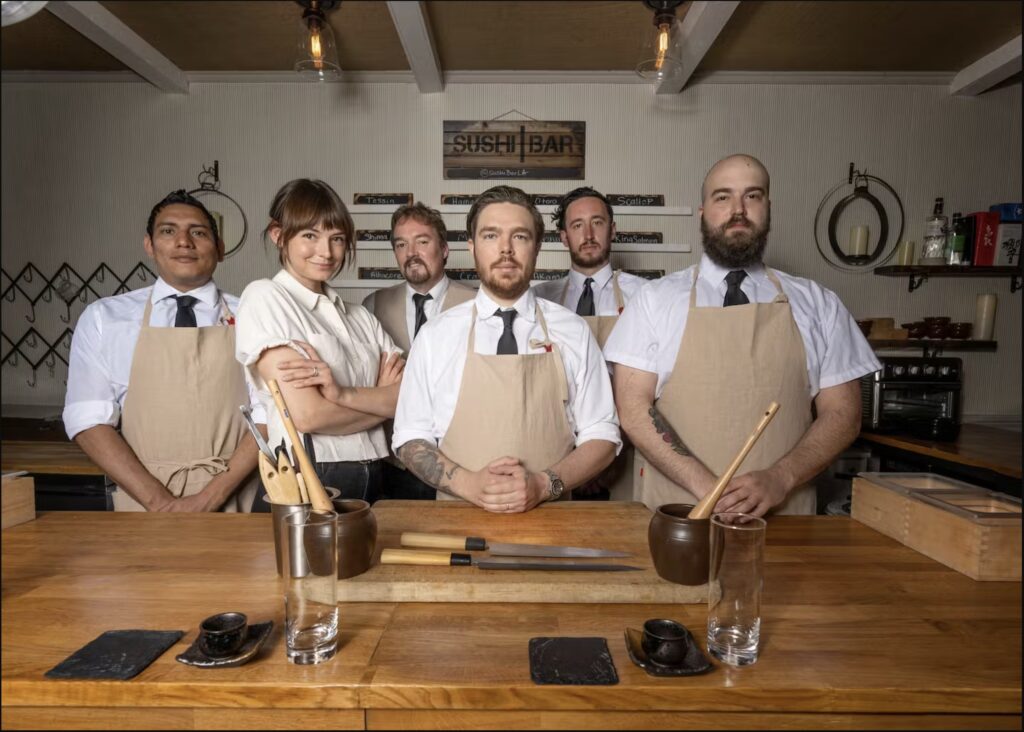
The concept, which would eventually be known as Sushi | Bar (before later adopting the Sushi by Scratch Restaurants name), offered a $110 menu for eight diners at a time spread across three seatings a night. Lee, despite having “little formal background in sushi,” was inspired by “his experiences at places like [two-Michelin-star] Urasawa, where he dined as a young line cook.” However, he did not intend to even try to offer “hyper-traditional Japanese cuisine.” Rather, despite fearing “people would [be] upset that young white people are doing sushi,” he crafted “new wave nigiri” (“sweet-corn-brushed yellowtail; yam with salmon roe and mushroom dashi; sushi rice topped with roasted bone marrow”) in a space described as a “1930s-Japan-inspired” speakeasy.
Though Lee described that “at first when we were shopping at the fish markets we didn’t have a lot of clout,” by September of 2017 they were getting “the best fish” with everything flown “overnight from Tsukiji Market in Tokyo.” A few months in, the chef would characterize the response from diners as “incredible,” sharing that he already has “many people who come in more than once a week.” Without “trying to sound pompous,” he also shared that “upwards of 80% of diners say it’s the best sushi they’ve ever had in their life, and these are people who’ve had some of the best sushi in the world.”
The Los Angeles Times would not review Sushi | Bar until May of 2019, but Patricia Escárcega’s evaluation was a positive one. By then, the restaurant was serving “17 courses of unapologetically nontraditional bites” for $125 and leaning into that “new wave nigiri” tagline. But the experience also began with a “complimentary house cocktail” and a “choreographed and schticky—or charming, depending on your point of view” route to the moodily lit counter that “blurs the line between a modern omakase dinner and a cabaret performance.” The critic, in a manner reminiscent of Gold’s original comment regarding the cooking at Scratch | Bar, suspects “some of the bites, topped with things like sourdough breadcrumbs or yellow corn pudding sauce, will infuriate a certain kind of customer, sushi purists in particular.” However, everyone else “will find it fresh and uncomplicated, in the sense that it all tastes pretty good.”
Digging deeper, Escárcega notes that “by the time the seventh or eighth course rolls around, the kitchen’s formulaic one-two punch is clear: a swab of the subtly sweet house-made soy sauce, some fresh grated wasabi, a sprinkling of Bali salt.” The sequence, while “highly predictable,” is also “effective and good.” Likewise, there are some more unique bites worth special praise: “Japanese yellowtail…scored and slicked with a surprisingly delicious yellow-corn sweet pudding,” “shima aji…splashed with a yuzu kosho infused with the smoky, savory notes of Anaheim chile peppers,” and “smoked albacore wrapped in sake-soaked seaweed, topped with crispy onions.” Even dessert, “a sweet frozen lozenge of lime ice cream and black sesame shortbread encased in a green tea chocolate shell” made by Kallas-Lee, is termed “marvelous.”
This must stand as one of the finest professional reviews Lee has received in his career, and the public seemed to agree. Sushi | Bar (now known as Sushi by Scratch Restaurants: Los Angeles) enjoys a four-and-a-half-star average on Yelp. However, as is typical, there is a share of one- to three-star reviews criticizing upselling, the amount of sugar used, “mushy” rice, heavy-handed toppings, and being “all presentation without substance.”
With Sushi | Bar making waves within Woodley Proper, 2018 would see Scratch | Bar receive “a conceptual refresh and a minor interior layout change” termed the “2.0” version of the restaurant. The space, thanks to “wall-leaning banquettes that face the kitchen,” would feel more like a “kitchen theater.” The menu would retain Lee’s “signature dish” of a “poached green mussel sake shooter” but “otherwise the courses are completely new.” The chef would “lean heavily on the wood-fire hearth” but retain the “scratch” ethos of making everything from “the cheese and butter to the bread and charcuterie” in house. The “heavy” reliance on (totemic) luxury ingredients like “uni, salmon roe, and foie gras” would be dialed back while Kallas-Lee’s desserts would be “numerous,” sometimes “visually deceptive,” but “well-composed.”
For Lee, the later part of 2018 and first few months of 2019 would see the culmination of a set of concepts within Santa Barbara’s Montecito Inn: another location of Frankland’s Crab & Co., an “all-day hotel restaurant” called The Monarch, a “modern approach to the grand fine dining tradition” titled The Silver Bough, and a second iteration of Sushi | Bar.
Of these, The Silver Bough is undoubtedly the most interesting. It opened in late January of 2019 touting a $550 ticket price (inclusive of tax, tip, and beverage pairings) for one of eight spots in a “400 square foot dining room-within-a-dining room” (within The Monarch) with a sole 6:30 PM seating each night. Lee stated at the time of opening that “The Silver Bough is designed to be a three-star restaurant. That’s what we want. If we get one star, I will probably burst into tears. But three is what we’re shooting for.”
Eater LA termed the restaurant “California’s Most Ambitious New Restaurant” and Forbes distinguished it as “undoubtedly” the “most extravagant and exclusive dining experience in town.” Food & Wine would call it “a fine-dining destination that walks the fine line between balancing extravagant flavors and gilding the lily” while the Santa Barbara Independent would ask “Did the World’s Best Restaurant Just Open in Montecito?”
Existing menus for The Silver Bough display dishes like “American Sturgeon Caviar” (lobster gelee, hazelnut cream, smoked eel), “Live Spiny Lobster Tartare” (sea urchin, tomato aspic), “Pommes Souffle” (stuffed with lobster innards, topped with sea urchin), “Lightly Grilled King Crab” (sea urchin emulsion, sauce vin jaune, caviar), “Legendary Olive Wagyu Ribeye Cap,” “Center Cut Legendary Olive Wagyu Ribeye” (lots of black truffle, candied pecans), and “Black Truffle Ice Cream” (white truffle brioche cone, 24k gold). The wine pairing, you must say, impresses you with producers like Bruno Clair, Clemens Busch, D’Oliveira, Keller, Larkmead, Sandhi, and Realm being featured. And the restaurant earned six five-star reviews from Yelpers during the time it was open.
The lone one-star review comes from a user whose reservation was cancelled and refunded due to circumstances beyond the restaurant’s control. As it happens, The Silver Bough would close in early September of 2019 “owing to a staffing issue.” In October, Lee would announce he was closing all his Montecito Inn concepts save for one. Sushi | Bar would remain (that location being run by brother Lennon Silvers-Lee), and the chef would be “heading back to Encino to regroup” and plan the expansion of the omakase concept “up and down the California coast.”
These plans would be delayed by the pandemic—during which Lee sued his insurance company “for declaratory relief” surrounding its business interruption policy—but, by the summer of 2020, the chef’s creative juices were once again flowing. In June, he would announce the launch of Pasta | Bar in the former Woodley Proper space: a “multi-course tasting menu” of Italian flavors “guided by chef de cuisine Kane Sorrells” (formerly of NYC’s two-Michelin-starred Blanca). That following September, Lee would announce Leviathan—an “all-outdoor wood-fired” seafood restaurant—one floor below Scratch | Bar, Sushi | Bar, and the new Pasta | Bar. This latter concept seem to not have lasted very long through the end of the pandemic, but the chef’s other ideas would prove resilient.
Lee and Kallas-Lee took the Sushi | Bar concept to Austin in late December of 2020 as a pop-up when Los Angeles “disallowed all onsite, dine-in service during a big surge of COVID-19 related cases” in order to “keep their staff employed.” The couple originally intended to return home at the end of January 2021, but “reservations were so immediately booked up with a long waitlist (at the end of its third week, the list was over 100; by the end of January, it was over 20,000) that they opted to extend the stay.” Eight months later, the waitlist was still full, and Lee could proudly state “we’re here to stay.” Far from being a copy of the Encino and Montecito locations, the Austin version combined fish flown from “Japan, Australia, and Santa Barbara” with “Texas products” like “wagyu, bone marrow, olive oil, and all of the produce.”
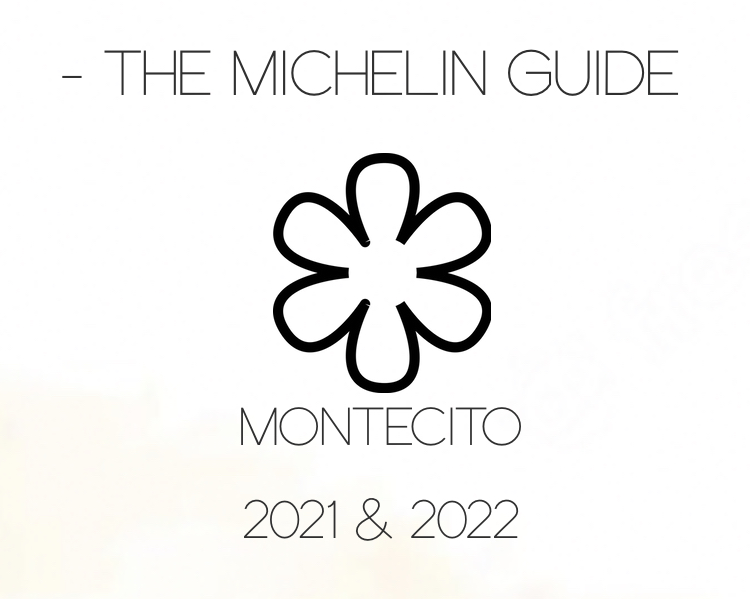
Despite his success in Austin, Lee was on the precipice of the biggest moment in his career. In September of 2021, back in California, Michelin would award both Pasta | Bar and the Montecito location of Sushi | Bar with one star. The chef “started crying” when he heard the news, describing the accolade as a “lifelong goal” and proclaiming “the only way you can be recognized as the best is if you get a Michelin star.” The dual awards—both of which Lee retained in 2022—mark him as the contestant most awarded by Bibendum in Top Chef history: an absolutely stunning accomplishment given the bitterness that surrounded his exit from the show.
With all this momentum behind him, the chef would announce, in January of 2022, an Austin location of Pasta | Bar. He would also announce the first location of Sushi by Scratch Restaurants in Cedar Creek, Texas. The name of this latter venture would represent the sale of Sushi | Bar (now run by executive chef Ambrely Ouimette, formerly a member of Lee’s team) to new owners and a reopening of the same kind of concept (Scratch Restaurants being the name of the restaurant group under which all of Lee and Kallas-Lee’s establishments had been organized). Subsequently, the Sushi | Bar locations in Encino and Montecito would change their names to Sushi by Scratch Restaurants: Los Angeles and Sushi by Scratch Restaurants: Montecito respectively.
In July of 2022, Lee would open Sushi by Scratch Restaurants: Miami (with a competing Sushi | Bar location arriving a few months later). This was followed in September with Sushi by Scratch Restaurants: Seattle. And, finally, that leads you to February of 2023 and the opening of the group’s sixth omakase property: Sushi by Scratch Restaurants: Chicago.
Eater, as always, would break the news of Lee’s arrival via its Chicago outlet. The restaurant was originally “ticketed for West Town,” but the chef’s team “quickly switched destinations after finding the Swill Inn space” in River West. The “Midwestern outpost” would replicate the same format seen at other Sushi by Scratch Restaurants locations: involving a “bit of theatricality” as diners are “brought into an 18-seat whiskey bar for a welcome cocktail” then welcomed “to the actual sushi bar, which is staffed by three chefs and a bartender.”
It was revealed that Lee has plans for “another concept” in the building’s more expansive upstairs space. However, at the time, the article stressed the chef’s L2O and Alinea credentials, his two Michelin stars, and the fact that Sushi | Bar’s original chalkboard reservation system “was inspired by his many nights spent using a quarter to reserve a pool table on the second-floor at Delilah’s, the divey punk rock bar in Lincoln Park.” Clearly, Lee was not just a carpetbagger looking to capitalize on Chicago’s nascent appreciation of omakase (even though he also made clear his goal “to take this sort of micro restaurant and sort of grow it and grow it and one day become the most starred concept around the country and potentially the world”). Rather, he would look to build an experience where “chefs connect with diners during an intimate meal” and not “tell somebody else’s story, but to tell mine based on the flavors that I grew up with.”
Chicago Food Magazine, nothing more than a repository for press releases in truth, would come out with Sushi by Scratch Restaurants’s official line a day later. Lee and Kallas-Lee would share that they “are thrilled to be opening our first dining concept in Chicago, a city that is widely recognized for its vibrant and dynamic culinary scene.” For 30 guests spread across three seatings each night (Wednesday through Sunday, though other locations have expanded to operating daily), the chefs would look to offer “an unforgettable, deliciously fun, one-of-a-kind personalized experience” via “a progressive 17-course nigiri tasting menu experience” showcasing “fish and shellfish primarily flown in twice a week from Tokyo’s Toyosu Fish Market.”
Lee and Kallas-Lee would note that Sushi by Scratch Restaurants is “revered for our inventive flavor profiles” and “although some of our nigiri flavor profiles may not be what people expect when they think of conventional sushi, our approach to nigiri is very much traditional.” (Of course, by the chef’s reading, the most meaningfully “traditional” aspect of sushi “was that the chef would tell the story of their childhood and the neighborhood that they grew up in”—a coy attempt to redefine the word and untangle it, in line with his own lack of any apprenticeship, from the mastery of canonical techniques.)
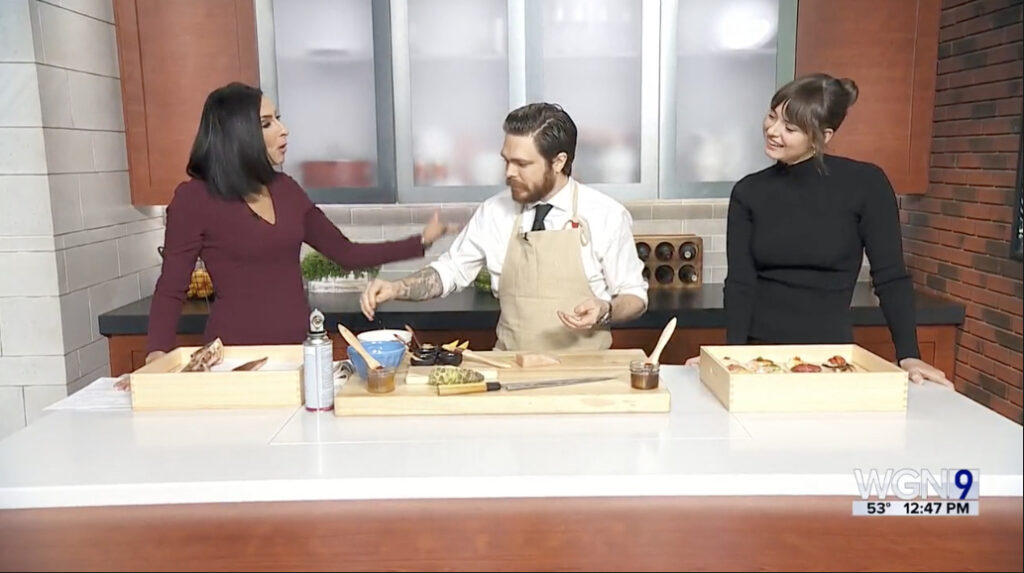
On February 14th, concurrent with Sushi by Scratch Restaurants: Chicago’s opening, Lee and Kallas-Lee would appear on WGN9’s “Lunchbreak.” Showing off the omakase’s full set of nigiri (while making a couple of the pieces live), the chefs shared that they had wanted to open a restaurant in the Windy City together when living there in 2010 but it didn’t “pan out.” Nonetheless, they “loved” Chicago back then and saw it as a natural home for the expanding company. At their restaurant, in Lee’s own words, “there’s no menu—you just sit down and we feed you for two hours.” The chef would serve the reporter two of his signatures: “hamachi painted yellow with sweet corn pudding and topped with a fine sprinkle of breadcrumbs” and “unagi that’s fried crispy in…rendered bone marrow fat” (putting on quite a show with his torch in the latter case). Kallas-Lee, likewise, would share the details of her “Matcha Bon Bon” that ends the meal.
(Lee, by himself, would give an encore of this performance on Chicago Today in early April.)
Forbes, about a week after the restaurant had been open, declared “This New Chicago Sushi Speakeasy Is The Stuff Of Dreams.” It would also term Lee’s concept “the Windy City’s most talked about new sushi speakeasy” (a bit of a nonsensical phrase considering a lack of any other openings at the time). However, the piece would reveal that The Swill Inn had become The Drop In and now also houses the “NADC smash burger, a collaboration between Chicagoan Neen Williams, a professional skateboarder” and the Michelin-starred chef. During a meal at Sushi by Scratch Restaurants, you will “not only listen to stories, connect with the other guests, and learn an incredible amount about Japanese-inspired omakase as the night progresses” but also “connect with the [‘master’] chefs as they prepare each course with magician-like fingers.” Within the “unpretentious-yet-vogueish underground sushi sanctuary” the “Ryūkōka-like music and sideway glances” almost make you feel “like you’re a part of a secret society or a whodunit murder mystery à la Glass Onion.”
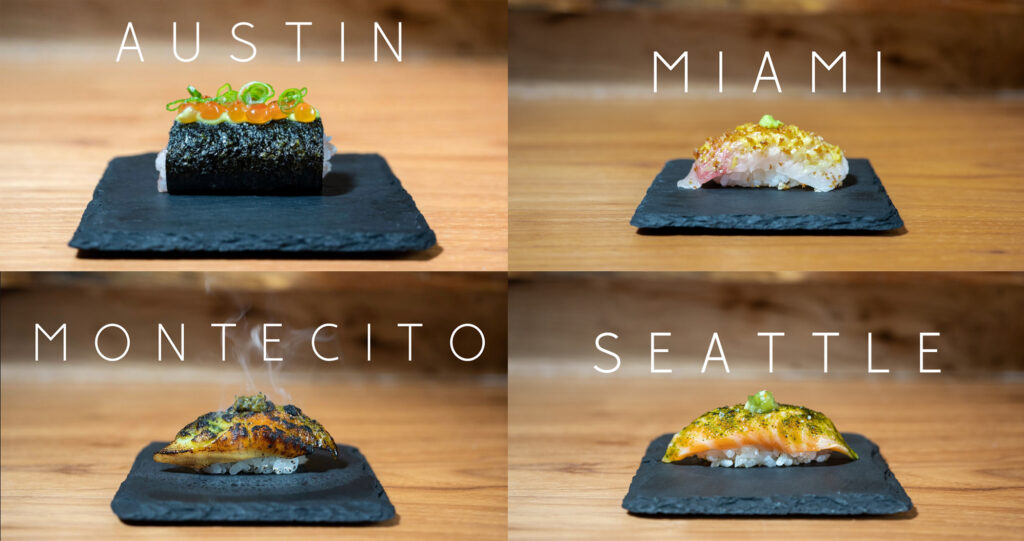
Lee, having already expanded Sushi by Scratch Restaurants into four other markets (where Tock availability shows they continue to do quite well), clearly knows how to promote his concept. Personally, you stumbled upon its reservation page and booked your first set of tickets without any idea of what you were getting into. Frankly, knowing that the omakase was part of a “chain” lowered your expectations. Yet, before the end of that first meal, you had already scheduled a return visit. Like it or not, the restaurant is a consequential addition to Chicago’s omakase scene.
Plus, after dwelling on Lee’s career for so long, you cannot help but respect his fortitude. On one hand, he clearly benefitted from the promotion given by Kat Odell, Farley Elliott, and Matthew Kang (all of Eater LA) early in his career. These “journalists” were desperate to pump out any content they could (standards be damned), and Lee was savvy enough to package and deliver it to them. Being a Top Chef “villain” and courting a coterie of haters was clearly a bonus: it still counts as attention at the end of the day. Likewise, Lee’s boldness and creativity should be praised (even in the face of failure), but it seems right to question if a certain degree of privilege allowed him to become an owner at such a young age and weather multiple closures without skipping a beat.
Those concepts that did prove successful did so in a market that, at the time, was immature: “the people in Los Angeles aren’t foodies” said Michelin Guide director Jean-Luc Naret when Bibendum left in 2009. And Scratch | Bar, for what it’s worth, excelled as top dog in a sleepy, wealthy enclave whose residents would rather not drive several hours to eat in Los Angeles proper. Lee’s approach to cooking, largely self-taught and even a bit contemptuous toward the traditional “paying dues” development of craft, seems tailormade for a population of diners that has little exposure to how things are “supposed” to be. Montecito, as best as you can tell, fits that pattern as well.
However, with enough time, experimentation, and legitimate growth, Lee has struck upon a formula that undoubtedly works. Scratch | Bar, Sushi | Bar, and Pasta | Bar overwhelmingly please people in their markets even if more well-heeled diners and discerning critics might disagree. Bibendum has judged two of these concepts to offer “high quality cooking, worth a stop,” awarding a set of stars—twice—that must now certainly quiet all the haters (or, at least, make them question what exactly it is that the tire company prizes). So, despite facing detractors almost every step of the way, Lee is kind of unstoppable. You admire him for that, and the chef seems fairly gracious now that he has established a small bit of the empire he has always wanted.
With Sushi by Scratch Restaurants: Chicago, Lee enters a relatively mature fine dining market for the first time, yet one that has undoubtedly been declining—at least when it comes to top expressions of gastronomy—since he worked at L2O and Alinea. However, when it comes to omakase appreciation, the city is still rather immature and far from being saturated. Lettuce Entertain You only got in on the act last year and seems sure to earn (at least) a Michelin star for its effort. Mako and Yume have already been awarded by Bibendum but, despite being located not all that far from Lee’s “sushi speakeasy,” do not aim to offer the same style of experiential dining. Sushi Suite 202, another import, seems like the closest point of comparison all the way over in Lincoln Park. While Kyōten, up in Palmer Square, remains singular in its hyper-premium, one-seating-a-night approach to the craft.
What exactly separates Phillip Frankland Lee from Otto Phan (another polarizing chef who came to ply his trade in Chicago)? And just how likely is Sushi by Scratch to earn a star here (as it did in Montecito)? The concept has not yet been evaluated by Bibendum in Miami (a city that already arguably has a better omakase scene), and it seems unlikely that it will be included—being open for such a short period of time—in Michelin’s looming 2023 Chicago guide. As Kyōten proves, Chicagoans do not need to rely on a French tire company to tell them where to get good sushi. But any award would certainly put Mako and Yume’s stars into perspective while helping to clarify just how much an overall sense of “experience” counts.
Lee’s omakase performance has quickly become one of the city’s hottest sold-out shows, and you are eager to engage with a concept that so wholeheartedly embraces the idea of hospitality as theatre. Sushi by Scratch Restaurants does not only present an opportunity to critique food and drink, but to question their very importance within a larger sense of dining “occasion.” There does, indeed, seem to be a bit of an Alinea streak about this idea (for better or worse). And it will, no doubt, be gratifying to unravel exactly what Lee is bringing to a city that he loves, as well as how his concept might inform the growth of Chicago’s wider sushi appreciation.
You have visited Sushi by Scratch Restaurants three times, spanning a period from February through April of 2023. As usual, you will condense the sum of your experiences into one cohesive narrative.
With that said, let us begin.
Sushi by Scratch Restaurants: Chicago is firmly located in your neck of the woods, an area characterized by its access to some of the city’s greatest dining neighborhoods but lacking many of its own attractions. River West, as this small slice of land located off of the North Branch is termed, will soon be home to the Bally’s Chicago casino resort. Neighbors (your neighbors) fought the decision like hell. The development stands to spoil their quiet, residential enclave (complete, of course, with its own gated community). However, you welcome the transformation of the decrepit Chicago Tribune printing plant into an entertainment and hospitality hub. The casino will work to direct some of River North’s flourishing nightlife westward, and you salivate over the prospect that it will house an estimable dining destination.
For now, however, River West (though its exact boundaries are often blurred with the Fulton River District) is home to stalwarts like Piccolo Sogno, La Scarola, and The Dawson. Rob Katz, Boka Restaurant Group co-founder, has just opened The Pearl Club at the same intersection. But most consumers, undoubtedly, are drawn a few blocks further south at present. There, you find the entrance to Fulton Market proper, with places like Kumiko, Moneygun, Oriole, and—yes—Mako heralding your arrival at one of Chicago’s most delectable corridors.
Sushi by Scratch Restaurants sits somewhere between these zones and just a little further east. The Drop In, the bar that houses the concept, can be found on Milwaukee Avenue just beyond the five-way intersection where it meets Kinzie and Desplaines Street. Its neighbors are the ever-fragrant Blommer Chocolate Company, the hulking Pickens Kane Moving & Storage facility, and a Jewel-Osco location that is rather expansive in its own right (complete with an in-store bar). The one-acre Fulton River Park located on the opposite corner is also pretty nice. The Blue Agave restaurant located next to it is a bit less exciting. Yet Sushi by Scratch Restaurants can at least count Perilla as a neighbor—though the Bib Gourmand-winning Korean spot is currently closed for renovations.
Approaching Lee’s restaurant on foot, you are immediately struck by its intimacy. The two-story, brown brick building is dwarfed by Perilla’s three-story home (complete with Michelle Obama mural by Royyal Dog) and the fortress-like Pickens Kane across the street. Further, the Korean concept’s outdoor patio—along with a rail bridge located on the other side of The Drop In—ensure that the structure stands apart from any bordering walls. You can see skyscrapers in the distance (including, if conditions are right, the John Hancock Center), yet the façade of the Sushi by Scratch Restaurants venue is framed by greenery (as well as a vintage Ford pickup that sits in the alley to its side). It feels small and knowable, tinged with personality and even a bit of mystery (especially if you happen to spot Otis the dog peering out the adjacent door).
Other than signage for The Drop In, a placard only announces that Lee’s NADC Burger concept lies within. The sensation, walking through the door, is nothing like stepping through Mako’s sleek entryway. It is less assured than venturing within Yume’s labelled awning. It does not even offer the security—when stepping into Sush-san in search of The Omakase Room—that you are somewhere within the right genre. No, the feeling is a bit more like trying to find Kyōten (though Phan’s façade still makes one wonder if any business is located through those doors).
Lee, as you well know, has a flair for the dramatic: other Sushi by Scratch Restaurants locations have featured signs that say “Serving omakase by appointment only. Please ring bell for service.” However, for the Chicago edition, you receive a reservation confirmation text that advises you to arrive 30 minutes early and reveals that “our front door is located inside of THE DROP IN, 12 paces in on your right you will find a black keypad: enter 8450 and proceed.”
It takes a second for you to register that this is not the usual “press 1 to confirm” boilerplate. You wouldn’t have guessed it when first booking your reservation, but this restaurant is actually indulging in a bit of worldbuilding. It wants to tantalize you with a bit of uncertainty—and a couple dashes of mystery and romance—long before the first morsel hits your tongue. Omakase aficionados may be inclined to roll their eyes, wary of anything meant to distract from the fundamentals of fish and rice. However, those who are unsure about paying a premium for sushi will be comforted by the suggestion that they are not about to embark on a mere meal but, rather, an experience.
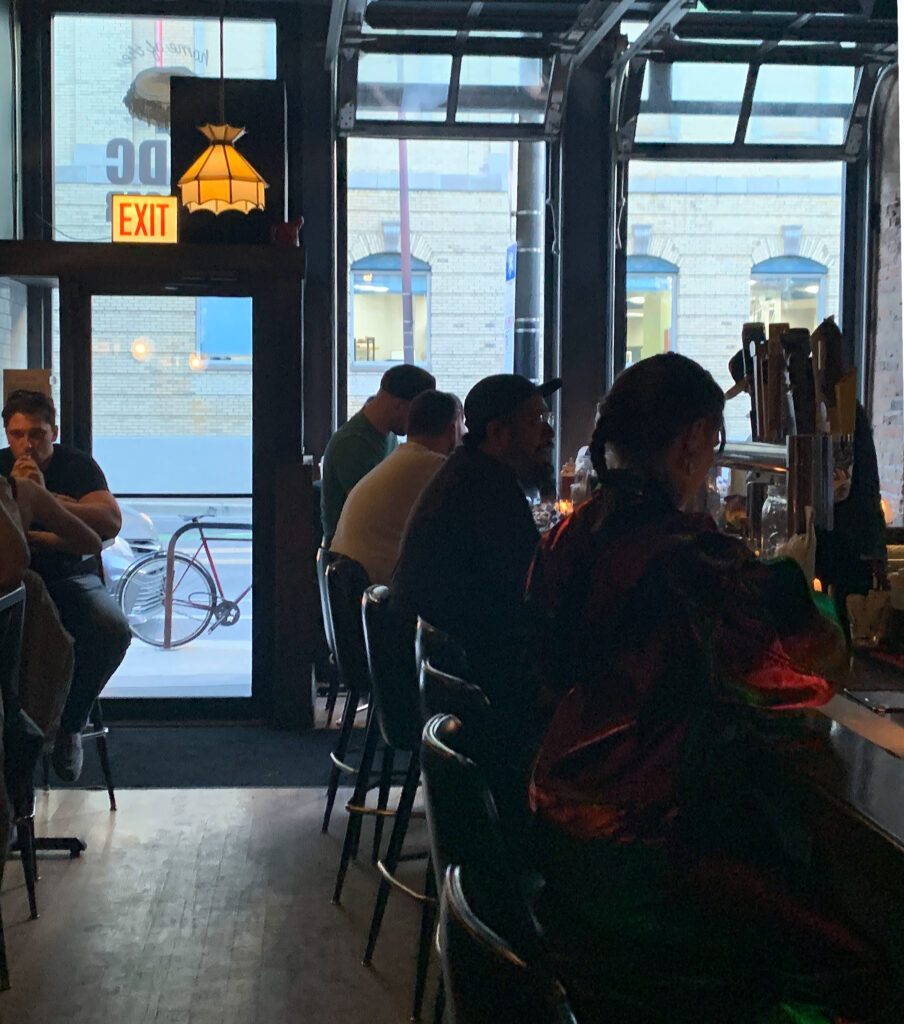
In practice, you cannot help but feel a bit self-conscious as you enter The Drop In. The place looks every bit the part of a neighborhood bar: faded tones of wood, brick, and leather with a long line of taps and a couple televisions playing sports. With closer inspection, you may notice a couple distinguishing touches like a memorial portrait of Anthony Bourdain and a couple skate decks affixed to a wall (remember, NADC Burger is a collaboration between Lee and a professional skateboarder). But, moving through the space, you do not sense one bit of pretense from the barkeeps or assembled patrons. None of the traditional markers that scream “luxury dining” are present. You are tempted to ask the staff for further guidance just to be sure—completely sure—that there’s an omakase here. Yet, counting out those 12 paces in your head, you come to a segment of the wood-paneled wall that does, indeed, feature a small handle and keypad. You hold your tongue, and the bartender, standing at the ready to assist you if necessary, smiles knowingly.
The keypad does not beep or click or feel particular tactile, but the door does indeed unlock. Thus, you slip into the corridor and leave the world of the bar behind. For those who have walked through the optical illusion hallway at Alinea “1.0,” this whole gimmick feels a bit primitive. However, subconsciously, it allows Lee to demarcate exactly where the Sushi by Scratch Restaurants experience begins. Such a move does not need to be sexy to work; it just needs to engage your spatial memory and signal the start of the chef’s multisensory curation of the evening. Valhalla, for all its team’s talent, cannot create this kind of liminal moment on account of its food hall setting. The concept retains its association with Time Out Market—good or (mostly) bad—while Sushi by Scratch Restaurants, even though actually related to NADC Burger, occupies a totally different world from anything going on at The Drop In. Plus, if you, as a host, play up the “hidden speakeasy” mysteriousness with a bit of panache, your guests may think the clunky keypad thing is actually a delightful surprise. Lee provides you with the tools to make a date night feel extra special if you are not too cynical to play along. He is also smart enough to know how even the most minor environmental cues help organize (and enhance) consumers’ recollection of a meal.
Stepping through the door into Sushi by Scratch Restaurants proper, you come face to face with a flight of stairs and a small sign asking you to hang your belongings on an adjacent rack before making your way downward. There, you meet the first member of the restaurant’s staff. They do not engage in any further roleplaying that might stoke the sense of mystery but, rather, offer a warm and enthusiastic greeting that puts you at ease. Your party is formally checked in and asked as to its water preferences (a nice bit of anticipation that, however, does not always ensure you get the kind you selected). Nonetheless, the interaction with the mustachioed host is polished. It assures you that something truly luxurious, despite The Drop In’s humble digs, is in store. Yet, just when you are ready to venture into Lee’s sushi sanctum, the chef’s henchman hits you with a “spiel” (as they jokingly refer to it). This evening’s omakase still costs $165 (as advertised), but the restaurant is offering a special $85 supplement that infuses certain parts of the menu with doses of caviar and truffle. Of course, you need not feel any pressure—none at all—to indulge (but just say the word and they will take your meal to the next level).
When you visited Sushi by Scratch Restaurants during its opening week, this supplement was listed on the receipt as “V-Day Omakase” (for an all-in price of $250). Later, the name of the line item would be changed to “Upgrade Omakase,” but the idea remains the same. You whisk your date through the unassuming neighborhood bar, punch in the secret code, and find yourself graciously received in the hidden chamber. You are all set to kick off a memorable evening, but there’s just one more thing. Do you want to upgrade to the superior menu, the kind of uninhibited decadence that really shows someone you care, or stick with the plain, old, standard, discount version like any uncultured swine off the street might opt for? Remember, there are no wrong choices! Lee will still happily take your money (even if you are a cheapskate). But, for a nominal 50% increase in entry price, you can leave no doubt (in the eyes of your party or with regard to that murmur of status insecurity in the back of your head) that you are doing things right. Certainly, if you are going to eat high-end sushi, you must appreciate life’s finer things.
Of course, you are exaggerating how the subtext surrounding this supplement may be taken to its logical conclusion. In truth, it is still a fairly benign form of upselling compared to what you have endured at places like Masa. However, there is undoubtedly something devious about putting customers on the spot before they have even caught sight of the sushi counter. With expectations at their height (and patrons unable to privately confer), some people will undoubtedly be snared by the proposition. You respect that Lee sequesters these luxury ingredients from his normal menu, for that ensures guests paying $165 will see their money go toward an assortment of quality fish rather than flashy totems. However, you have bitten the bullet and paid the $85 supplement during each of your three visits. The chef does a good job of slyly introducing your premium toppings without making other patrons feel inferior about their comparably plain renditions of any given bite. However, the use of caviar and truffle is totally unconvincing. They amount to needless baubles that do nothing distinguish the pieces they appear with. They make you feel like a sucker, and you most certainly are if you get goaded into taking the plunge.
It is also worth considering the $250 price point (exclusive of 20% service fee and tax) Sushi by Scratch Restaurants occupies with the addition of this supplement. It transforms the concept from a relative bargain in the omakase scene (at $165) into a place that clocks in north of Mako ($185, exclusive of 20% service fee and tax) and Yume ($225, exclusive of gratuity and tax) while matching The Omakase Room ($250, exclusive of 20% service fee and tax). Kyōten ($440-$490, inclusive of service but not tax) still occupies the top spot, but it seems clear that Lee is gunning for the Chicago sushi spots that already possess a Michelin star (or, in The Omakase Room’s case, seem highly likely to earn one).
However, while some of the city’s other omakases may make sparing use of caviar or truffle in their own right, these meager amounts are baked into one solitary price that moreso reflects the quality and quantity of fish being used. For example, Kyōten, Mako, and The Omakase Room each offer a sashimi set to start the meal along with other plated creations that preface an extensive service of nigiri. Lee, in order to efficiently get through his three nightly seatings, sticks rather strictly to bites of fish on top of rice. These fundamental ingredients will always remain at a “$165 level” even if they are topped with a luxurious supplement. So, while Sushi by Scratch Restaurants may seemingly occupy the $250 stratum, the $85 upgrade does not fuel any real creativity or structural changes to the meal. It amounts to mere window dressing, a taste of the totemic luxury ingredients that chefs love to shoehorn onto menus (but, here, being even more out of place). Thus, while the $250 sum ensures Lee is not leaving money on the table from those who might like to splurge, it is best to think of his omakase as a sharp value (at $165) that actually looks to undercut the city’s current top examples of the craft.
If one maintains this more parsimonious mentality, it should be easy to resist the offer of a supplement or, at the very least, save one’s money for the sake of purchasing additional bites at the meal’s end. Nonetheless, you must mention that these extra offerings—pieces (like kinmedai, kampachi, or foie gras) that are unique from what is included in the omakase as such—cost from $11-$15 each. Lee tends to offer three or four of them (time permitting and with an admirably soft touch) at the end of the menu, making for another kind of supplement that may tack $40-$50 onto the ultimate price of your meal. (Yume, it should be noted, operates in a similar fashion via a more extensive à la carte list.) Once more, this additional fee firmly places Sushi by Scratch Restaurants in the upper echelon of its peer group. Regardless, you will still primarily look to assess the restaurant on the basis of its bottom $165 price point while also noting the quality of these optional extra bites.
Whether or not you are enticed by the prospect of supplemental caviar and truffle, the host guides you through a beaded curtain into a makeshift lounge. Compared to LEYE’s luxe space at The Omakase Room, you have previously compared this pre-meal holding area to something “more like a jail cell.” (The host, on your most recent visit, even jokingly referred to it as a “hot, humid holding cell” themselves.) But, in practice (and just like the keypad/hidden door upstairs), this element of the experience functions well enough. Details like candles, hand towels, an abstract painting, a velvety curtained wall, and a bar cart inject some glimpses of luxury. The dimly lit space—if you are willing to play along—feels moody, intimate, and even a bit romantic. You almost feel squeezed in with the other patrons who will join you at the sushi counter but not quite so. Rather, this room helps to encourage a bit of fraternization before the actual show begins. When it comes to the evening’s later seatings, this proves essential in ensuring subsequent guests feel properly cared for—welcomed into the “experience”—and not left to be tempted by a burger and fries upstairs. Just the same, it allows Lee’s team to turn over the main space in privacy without being rushed by any other arrivals.

While your reservation confirmation text offers a “friendly reminder to arrive 30 minutes early,” the e-mail sent at time of booking clarifies that you are “encouraged” to “to show up as much as 30 minutes prior to your reservation to enjoy a complimentary welcome beverage.” Typically, you aim to be there about five minutes before dinner in order to minimize the waiting period in the lounge. Despite this, you are welcomed warmly into the space with a little cocktail made of Japanese whisky blended with unfiltered sake, housemade ginger syrup, and lime. The drink is prepared from the bar cart by the host and goes down easily, being sweet and simple enough to appeal to the masses without seeming sickly. It’s not exactly a Kevin Beary-level creation, but—hey—it’s free. They’ll serve you another one if you ask for it (“absolutely” was the response), and the libation offers a chance to toast with the other assembled patrons and break the ice.
As the reservation time approaches, the lounge also plays home to the evening’s first bites. Atop each of the tables, the host places a wooden log holding a bowl filled with pebbles and crowned with a couple fresh oysters. The bivalves, he announces, are sourced from Prince Edward Island and dressed with a tomato emulsion, some puffed rice, and a couple strands of kombu (dried kelp) “jerky.” “Not bad,” you think, as the bite goes down easy. It’s a good—if not transcendent—example of the form that is nicely presented and easy to maneuver in the setting.
Shortly thereafter, the host returns with a second opening morsel: one that initially formed the first course at the counter but has since transitioned to appearing in the lounge. He describes the “Blue Fin Tessin” as the first of three servings of this tuna (sourced from Spain) you will enjoy this evening. That term—“tessin”—refers to the tail of the fish that is ground into a paste and combined with soy, ponzu, green tea salt, and wasabi. The mixture is wrapped in a cylinder of nori (dried red algae) and topped with a bit of avocado mousse, a couple orbs of salmon roe, and some thin slices of scallion. The package, once more served on a bed of pebbles, is quite attractive. However, you find the seaweed to be rather soft and the end result, texturally, to be mushy. The flavor, regardless, is enjoyable, and you commend Lee for using the lounge as something more than just a waiting room.
Without much further delay, Lee and his team are ready to welcome you into the heart and soul of Sushi by Scratch Restaurants. Exiting the lounge and stepping through another door, you are led to the basement’s main chamber where the sound of 1920s Japanese parlor jazz waits to serenade you. There, 10 chairs are arranged across the expanse of a sturdy wooden counter. The surprisingly high ceilings feature a constellation of antique bulbs—as well as a few rattan chandeliers—that bask the bar in soft, warm lighting. Meanwhile, strips of LEDs are positioned perfectly over the cutting boards themselves, being tilted just enough to capture every move of the chefs that man them. This all makes the lighter brown (almost tan) tone of the surface positively glow like a stage. It also makes for a beautiful contrast with the darker wooden accents on the walls—along with the black wallpaper, mirrored inserts, and mounted orb sconces (that only faintly shine).
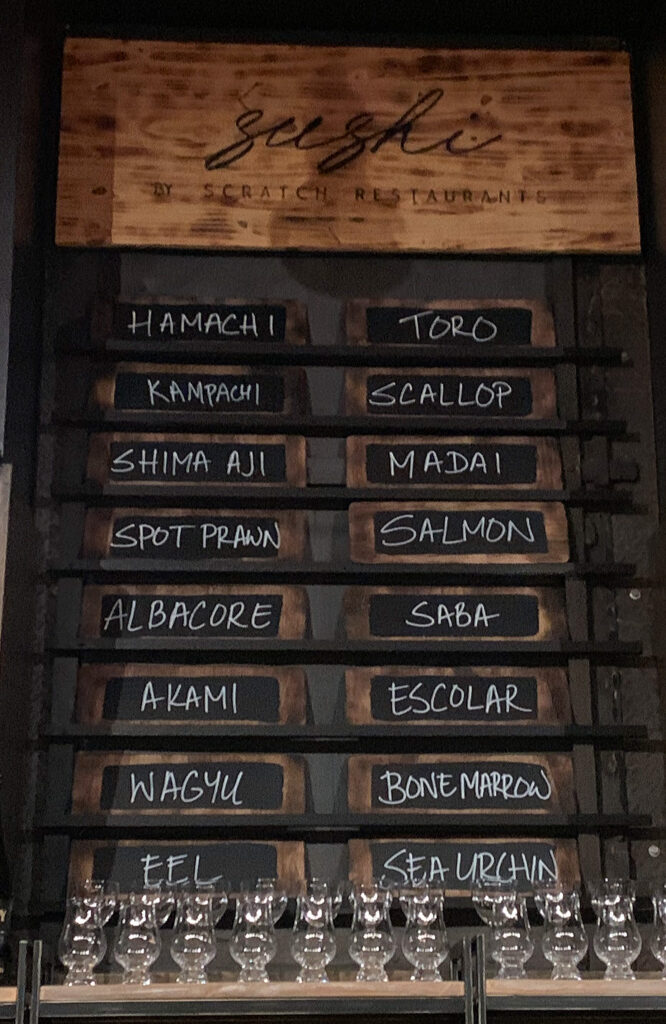
Other details of note include small slabs of chalkboard positioned in front of each place setting. The handwritten names printed thereon help guide you to the right seat while emphasizing the personal nature of the hospitality and facilitating interaction between parties. 16 more of these chalkboard placards are positioned on the wall behind the direct center of the sushi counter. They list, from left to right, that evening’s assortment of nigiri (with the opening lounge bites and Kallas-Lee’s dessert being omitted from the selection). Atop this installation, you find a wooden panel (done in the same lighter tone as the counter) displaying the Sushi by Scratch Restaurants logo. This pop of contrast serves to catch the eye and subtly connect all the drama of the “stage” area to the larger brand identity.
Beneath these features, along the wall that sits behind the sushi counter, you find another surface that houses a double-decker bar housing the meal’s pairings, a whisky selection, some plateware, and ample glassware. Even further down, you find coolers and a pair of rice cookers that serve to equip the chefs during the course of the omakase. Moving to the counter that, upon taking your seat, lies before you, it becomes apparent that the workspace is split into thirds. Off center to the left and right, the two more junior chefs are armed with knives and shadow boxes neatly filled with pristine fillets of fish. From either corner of the C-shaped bar, two diners (on each side) may cast their gaze across the surface and catch a perfect cross-section of the cutting action that precedes each bite. The remainder of the guests are spread out along the middle of the counter with the best seats located in the very center. There, the more senior chef is equipped with a wide array of brushes, spoons, and graters used to top each piece of nigiri. They, no doubt, are the master of ceremonies, but you can count on some degree of intimate interaction with whomever you happen to be seated in front of.
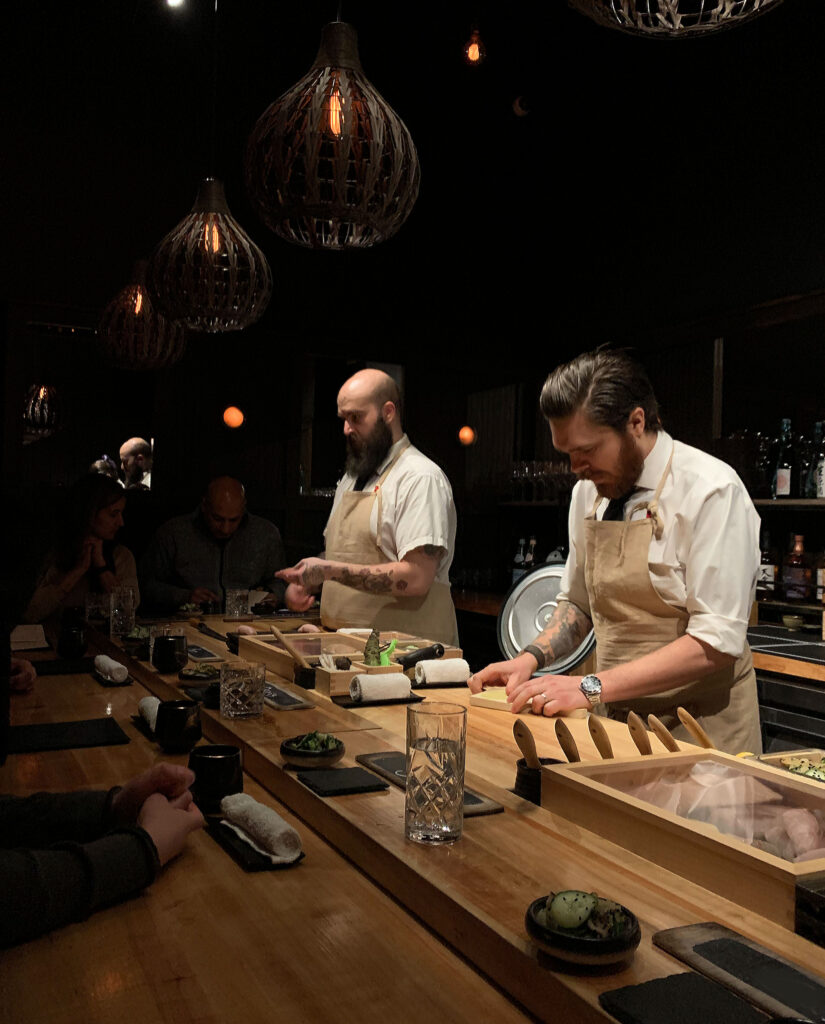
Overall, while you think The Drop In, the hidden doorway, and the lounge feel a bit cobbled together, Sushi by Scratch Restaurants’s dining room ranks as one of Chicago’s best within the omakase genre. Your first sight of the space, especially due to the high ceilings and stage lighting, borders on being breathtaking. It offers a very satisfying aesthetic payoff after all the mystery surrounding the keypad and the promise of a “speakeasy.” Kyōten and The Omakase Room, by your measure, clearly feel more refined and luxurious in terms of their actual finishes. However, these counters could feel a bit sterile to some (and, to be honest, that forms the traditional environment in which one appreciates such expensive fish). Sushi by Scratch Restaurants, to Lee’s credit, really does feel romantic. It feels singular compared to anywhere else in the city while making Yume and Mako—despite their stars—seem drab. Sushi Suite 202 and Jinsei Motto might form better points of comparison (both making use of unused spaces in a similar fashion), yet Sushi by Scratch Restaurants clearly surpasses them in terms of ambiance. The place feels permanent and legitimately memorable in a way that has nothing to do with the novelty value of its actual subterranean location.
With everyone settled in their seats at the counter, Lee offers a hearty welcome to the assembled diners. After noting the 17 courses that are still to come, he introduces the bartender (in truth, more of an all-around beverage maestro) that shares the stage alongside the three chefs. Along with one server (who works the side of the counter you are seated on) this man essentially handles all the traditional front-of-house tasks. He was a longtime Girl & the Goat veteran (estimable experience as far as trendy Chicago dining goes) and, when Lee is not present (more on that later), is without a doubt the most talented showman on the staff.
Taking center stage, the bartender invites you to open the small booklet placed atop the counter. As you browse through its contents, he energetically recites a spiel for those who might feel overwhelmed. In doing so, he echoes the philosophy of the beverage menu’s introduction (and that of Lee himself). The first page of the booklet recommends that “guests leave their entire experience in our hands and partake in one of our pairing options” while still welcoming patrons to “order a la carte from our carefully curated selection of Japanese Whisky, Beer, Sake, Wine and Cocktails.” Privileging a turnkey style of imbibing makes sense for a restaurant that emphasizes the larger experience, and Lee himself admits he has “anxiety about looking at a menu and choosing because what if I choose wrong? How do I know?” Thus, he, too, recommends “going on straight autopilot.”
That entails a $125 “Sake Pairing” (“6 pours of premium sake”), a $110 “Beverage Pairing” (“3 premium sakes, 2 cocktails, 1 japanese wheat lager”), and a $115 “Japanese Whisky Pairing” (“6 one ounce pours of japanese whisky”). Guests are generally steered toward the middle, balanced option—with Lee claiming that “beer is fantastic with some of the roasted meats” that appear at the end of the meal. In practice, the “Beverage Pairing” is totally serviceable if a bit undistinguished, featuring bottles like HeavenSake Junmai Ginjo ($44 average price), Mana 1751 “True Vision” Junmai Muroka Genshu ($44 average price), and Tedorigawa “Kinka” Daiginjo Nama ($41 average price). The introduction to a range of different sake styles—alongside a couple cocktails and beer—adds a loosely educational element to the selection. But the most memorable aspect comes when the bartender invites guests to “bend and dip” to slurp the drink out from the cup while it is still positioned on the upper part of the counter.
The à la carte side of the beverage menu is not all that impressive in truth. It comprises a range of 27 Japanese whiskies with producers like Mars, Nikka, Suntory, and Shibui being featured and one-ounce pours ranging from $9-$118. However, you would not classify any of the selections as being particularly rare in a way that can hold a candle to The Omakase Room’s titanic list. The sake options number 13, without any producers of particular note and bottles ranging from $80-$184. However, the most expensive of the bunch—the Imayo Tsukasa “Koi” Ginjo (also the only one not offered by the glass)—is priced favorably in comparison to a $135 average. You enjoyed its balanced, full-flavored, and adaptable nature when you sampled it.
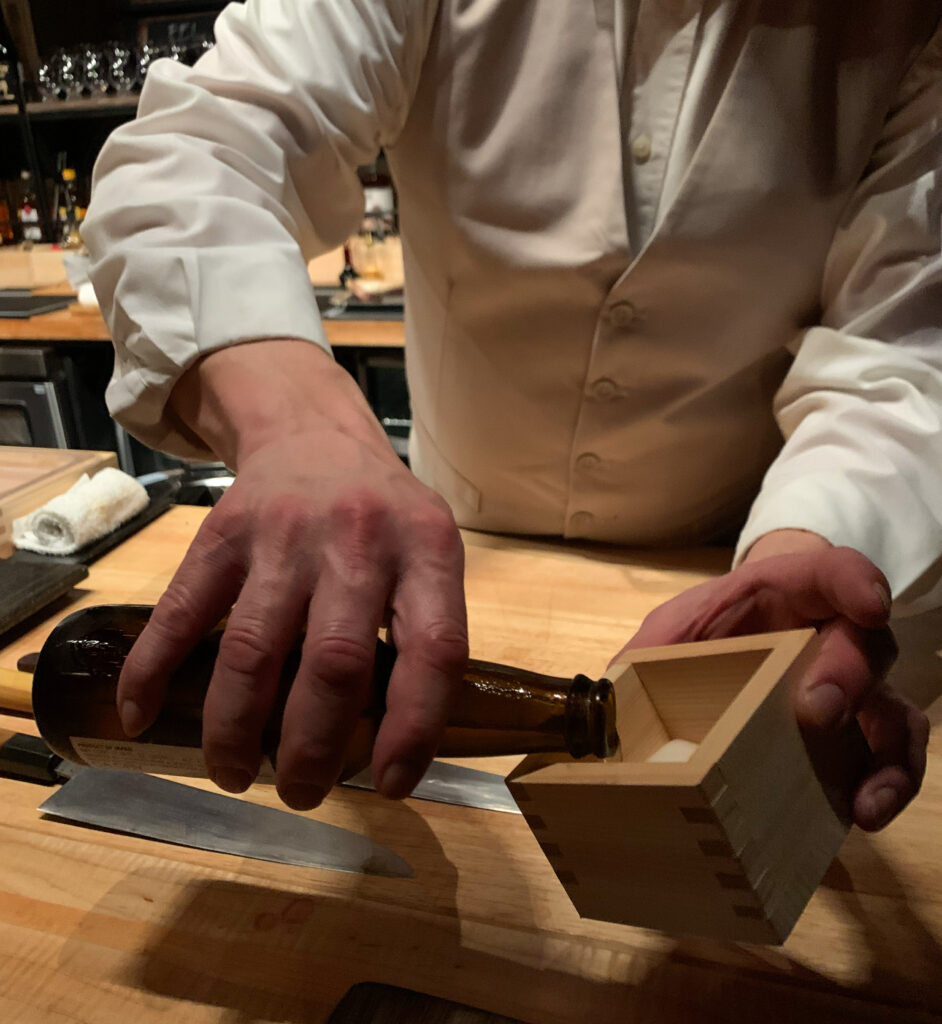
The four bottles of wine offered are listed both by the glass and by the bottle: AR Lenoble’s “Intense” MAG 18 Champagne ($38/$114), Le Pianelle’s 2018 “Al Posto del Fiori” rosé ($18/$54), Groundwork’s 2021 rosé ($18/$54), and Isole e Olena’s 2020 “Collezione Privata” Chardonnay ($47/$140). Again, these are not the most distinguished choices, but they represent a rather fair 100% markup and competent wines within styles that pose no risk of overshadowing the nigiri. You sampled both the AR Lenoble Champagne and the Le Pianelle rosé and found them to be perfectly pleasant. The cocktails, though you have not tried them (and happen to forget which are included in the “Beverage Pairing”), number four along with one additional (Seedlip-based) “Mocktail” ($15). Prices range from $18-$32 with the drinks being made from spirits like Roku gin, Suntory Toki, and Nikka Coffey Grain Whisky then mixed with stuff like Port, nigori sake, lime, orange, yuzu, smoked lavender honey, and demerara to make bright, approachable blends. The lone beer offered—Kawaba’s Snow Weizen ($12)—rounds out the menu. It also appears on the “Beverage Pairing” and is rather smooth and inoffensive.
Ultimately, just as Lee is not trying to dive all that deeply into the finer techniques of omakase, there seems to be no reason to load up the à la carte menu with rare and expensive bottles. The focus remains on a memorable overall “experience” (one that looks to avoid patrons fumbling with a long list of options by providing an easy, “we’ll take care of it all” solution). However, the chef deserves credit for keeping the markups so fair and gently guiding the vast majority of diners toward a safe, mildly engaging pairing that shows the breadth of what can accompany sushi. Some patrons like to supplement these set selections with one additional bottle of their choosing, an idea that you applaud (and have engaged in yourself). Otherwise, the $35 corkage fee (no limit to number of bottles) seems rather fair for those who do wish to enjoy something a little nicer or more attuned to their particular tastes. You even found that this fee, on the occasion of your third visit, was entirely waved on account of you now being a “regular.” This gesture should be warmly applauded (compared to how regressive the corkage policies at places like Alinea and Ever can be).
With your drink order decided, the show begins. As previously mentioned, Sushi by Scratch Restaurants operates its omakase using a triumvirate of chefs: two junior (positioned off-center to either side) and one senior (in the middle). This accords with how Takeya once functioned (though, as best as you can tell, no longer) and can be said to be similar to how LEYE’s premium counter operates. However, at The Omakase Room, Chan and Kitano are only a two-man show (one in which the latter breaks down and slices fish before transferring it to the former for shaping against the rice, garnishing, and serving). These seasoned itamae need only contend with two seatings each night while the Scratch Restaurants team, benefitting from an extra set of hands, has found a way to pump out three in 135-minute increments.
Lee, on the occasion of your first two visits, has been the main man at the center of the counter. However, after putting in two months at the new property, he has now departed for home (revealing during one meal that his life has been spent in “airports and hotels” since December). Lee’s replacement, since then, have been drawn from the more junior chefs who you have observed working at the concept since opening. This, no doubt, ensures a certain degree of continuity with customers who have already patronized the business and plan to do so regularly (a promise that is often voiced during the course of dinner). The auxiliary chefs, though not the stars of the evening, happily engage with the guests seated in front of their stations and can forge their own lasting bonds. Plus, at least one understudy, in truth, is a veteran of the restaurant group (appearing in the banner image for Sushi by Scratch Restaurants: Los Angeles back when it was still called Sushi | Bar) and must form one of the founder’s most trusted deputies.
Structurally, the division of labor at the counter means that the sushi changes rather little despite the switcheroo. The junior chefs, in slicing the fish and forming it onto the rice, are actually engaged with the most important, technical portion of the omakase. The senior chef, being concerned only with brushing, torching, or otherwise garnishing the nigiri, actually has a much easier mechanical task. However, as master of ceremonies and focal point for the assembled diners, the craftsperson at center stage has the most difficult hospitality job by far. They go beyond merely explaining each bite (something that most other itamae in Chicago can barely do with more than a few words) and actually put on a performance that is something more like stand-up comedy crossed with dramatic monologue. The main chef must maintain an upbeat, effortlessly convivial mood that ensures every moment of the evening feels like a rollicking good time. They banter with the other members of the team and field guests’ comments and questions with good (often self-deprecating) humor. At the same time, when certain bites arrive, this chef provides precise explanations and tells the kind of stories (regarding their inspiration) that imbues the meal with deeper meaning. Thus, you would very much characterize their performance as a primarily verbal one that is interspersed with key moments of physical flourish. Most guests, no doubt, will view the main chef as the maestro despite them having so little influence on the finer details of the sushi.
This sacrifice of technique for the sake of presentation forms the core of how Sushi by Scratch Restaurants subverts tradition. The focus on toppings (that can be easily applied by the main, performative chef in assembly-line style) rather than the fundamentals of fish and rice helps to facilitate the “playful reverie on new wave nigiri” and “free form interpretive take” on omakase that demands no prior expertise from patrons. The focus is purely on entertainment and pleasure—with even Bibendum agreeing that Lee has struck upon a winning formula.
Of course, the chef can claim he is “showcasing fish and shellfish primarily flown in twice a week from Tokyo’s Toyosu Fish Market,” so it is hard to pinpoint any particular lapse in quality compared to other Chicago restaurants. Rather, combining this kind of product with more assertive methods of seasoning and garnish might make it seem like the other itamae in town are cooking with one hand tied behind their backs. Restraint—and the subtle differences of taste and texture its practice enables you to perceive—takes quite a bit of experience to appreciate. And riding on the hedonic treadmill of omakase involves slowly learning how particular fish, from particular mongers, totally transcend what is typically sold at the market. It involves slowly realizing how consequential the aging and scoring of that fish is to revealing its full potential, how the type and ratio of vinegar blended into the rice offers a more fundamental means of flavoring than anything you might layer on top of the nigiri. The grains of that rice, too, can vary from being cold and lifeless to being impossibly delicate and nearly crumbling in your hand. Sushi, you always say, is a craft of fine degrees, and it almost seems like Lee has chickened out of actually competing with the masters.
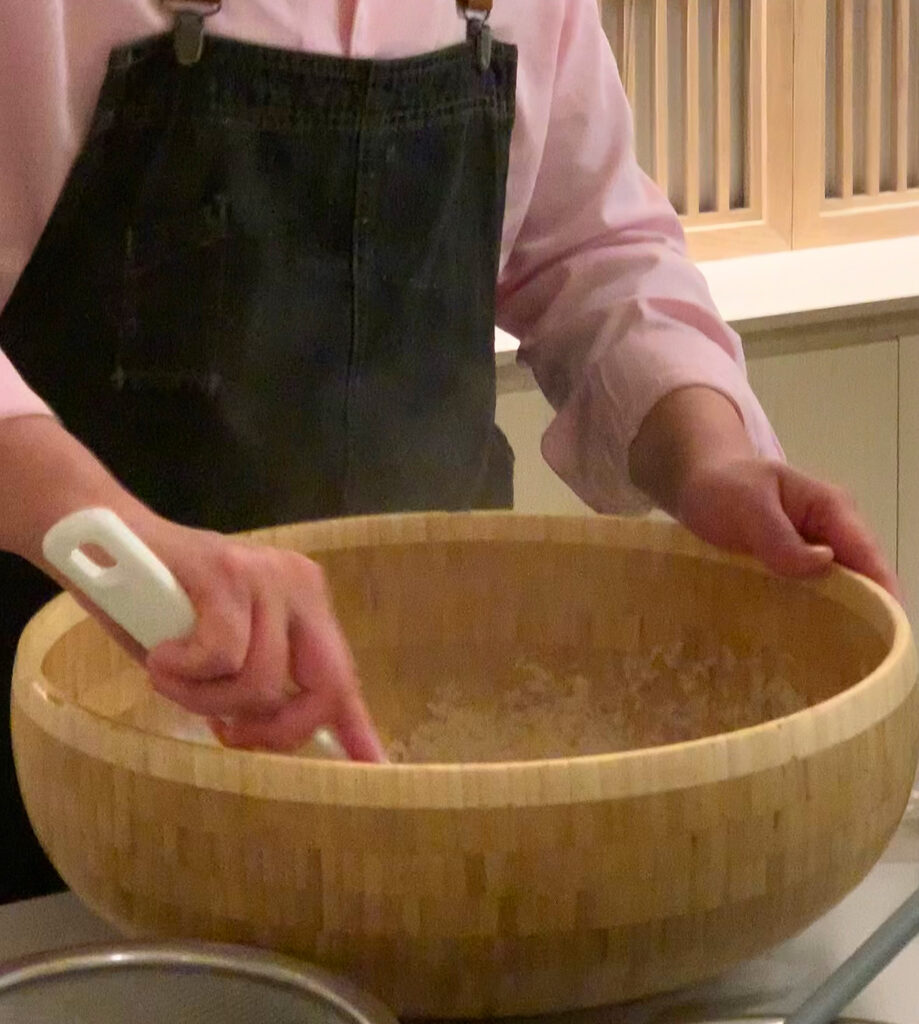
Nonetheless, consumers are drawn to “rocket” upward toward extreme examples of the experience they wish to enjoy. Someone concerned with people watching, with feeling part of an exclusive social scene, will no doubt make their way to Nobu and enjoy premium (if uninspiring) sushi fare in the city’s ultimate setting. Those desiring the ultimate expression of fish and rice—the most rarefied example of technique—must certainly splurge on Kyōten. One can certainly delude themself into thinking the high entry price is a rip off, but Otto Phan is the only chef in town that shapes each piece of nigiri, one by one, for his guests and, thus, achieves superlative textural results. The Omakase Room may hold some appeal as a more Disneyfied (yet still luxurious) substitute, but Chan and Kitano are guilty of following the assembly-line model. So, too, are the chefs at Yume, Mako, Jinsei Motto, Sushi Suite 202, and everywhere else. One can certainly weigh the strengths and weaknesses of these concepts against each other (with Michelin stars being enough to seduce some clueless diners), but they all represent a clear compromise on craft. By not making the pieces one by one, the chefs are sacrificing an essential element of the craft for the sake of efficiency.
These concepts that are not Nobu or Kyōten are prone to suffer from “death in the middle.” They do not distinguish themselves enough at the level of ambiance or food to truly be thought of as best in their class (though there’s a case to be made that The Omakase Room’s service or beverage program forms a distinctive strength). The genius of Sushi by Scratch Restaurants comes from the total abandonment of any traditional approach to the craft. Why have lone chef cutting fish and shaping it onto rice in front of you if they are still going to do it 10 pieces at a time? Instead, Lee pursues the ultimate in efficiency while putting on the most unforgettable performance. That is a real distinguishing factor in the marketplace, and it immediately carves out a lucrative niche for his concept in a city that, now, offers a fair amount of competition. In terms of pure hospitality, Lee has dreamt up a vision that privileges memory-making over the particulars of taste. It’s a laudable goal, and one that transcends the stark, snobby aura that can sometimes characterize the genre.
Now, just because the performance Lee (or his understudy) puts on is unique in Chicago doesn’t mean it cannot be picked apart. It may be instructive to do so now before taking aim more intently at the food.
Lee’s typical show, you must admit, is highly engaging. The Scratch Restaurants founder shows a level of charisma and an ability to read his audience that does leave you wondering whether his true calling is as an actor. You do not mean that as a backhanded compliment. Rather, Lee makes many of Chicago’s most famous chefs—helped along fawning documentaries and Chef’s Table episodes—seem utterly boring by comparison. He does not, like some of these lauded figures, use superficially inventive food to shield a bland (or downright strange) personality. No, Lee makes use of relative simple fare (a mass-produced kind of sushi paired with bold flourishes) to stage an engrossing delve into the nature of the craft, its ingredients, and his own story.
During your first visit, some of the puns and double entendres slung between the chef and his helpers behind the counter felt a bit forced or scripted. Nonetheless, they were delivered with flair and confidence. Plus, considering the countless times Lee has put on this show, hitting certain marks that are guaranteed to please the crowd is a good thing. Every professional—or dare you say person—has certain standbys in their repertoire, and the chef has been working consistently with the same tools, ingredients, and toppings in this format. It seems natural that certain jokes would roll off the tongue (like, holding his blowtorch, joking to a would-be sadomasochistic customer that “if you want me to burn you it costs extra”). Likewise, dropping the names of celebrities he’s cooked for (like Joe Rogan and Alton Brown) also fits into such a freewheeling experience (and works to make guests who are there on that particular evening feel special).
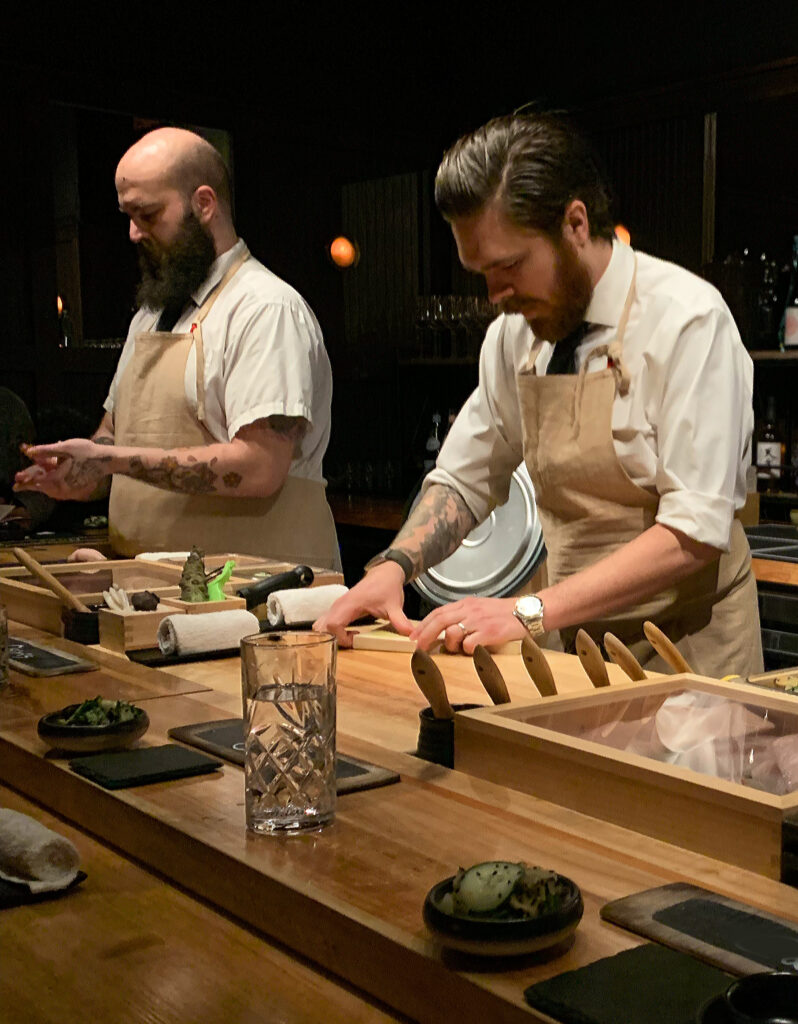
Much of Lee’s locution, understandably, is directed toward the product he puts out. Given that Sushi by Scratch Restaurants seems likely to appeal to those who do not consider themselves omakase snobs, education forms a clear goal. Entertainment, nonetheless, remains the order of the day, and the chef does a good job of informing customers with a gentle, gracious hand. He’ll explain the diverse textures of the different sections of the 200-lb. tuna he serves throughout the night. He’ll describe the difference between the fresh wasabi you see grated before you without making anyone feel stupid for liking the dyed horseradish stuff. He’ll pinpoint, with admirable clarity, exactly why he pairs toppings like pineapple brown sugar, poblano pepper, or beet mustard with particular fish. This all forms an excellent primer for the inexperienced—a path to thinking about why nigiri comes together well (even if its fundamental elements are somewhat ignored)—without ever feeling like a lecture.
Eventually, one of the diners might ask why a man like Lee found himself so drawn to the craft of sushi. On this occasion, the chef has a chance articulate his expertise in a manner that does not invoke apprenticeship but, rather, extensive reading. He describes how sushi formed more of a street food before World War II and that most of his inspiration comes from two particular time periods following that. First, he cites the edomae tradition that developed directly after the war around Tokyo Bay. While today, Lee says, that term refers to a style centered on applying a “whisper of soy” to raw fish, this does not reflect what was served back then “at all in the slightest.” Instead, the style was driven more by a lack of refrigeration and the development of techniques like “pickling, preserving, roasting, boiling, and smoking” to help with transport. These processes have inspired the many different flavorings and applications of heat that characterize the Sushi by Scratch Restaurants style, which is said to evoke the original edomae philosophy.
Lee also pinpoints the development of the “sushi-ya” style of restaurant in the 1970s through 1990s (and period he also terms “sushi’s infancy”). The craft may be “2000 years old,” but this era was marked by the opening of small omakases “in someone’s home.” In many cases, these restaurants were run by husband and wife, with the focus not being so much about “the best fish or rice” but how they “prepared or dressed” the sushi “based on their childhood or neighborhood inspiration.” This philosophy, which you have already noted forms the foundation of how Lee conceives of the tradition, has inspired him to incorporate things he grew up (like “corn on the cob” and “Nancy Silverton’s La Brea Bakery sourdough”) as toppings to his nigiri.
The chef even offers one piece during the meal that is a conscious homage to the kind of sushi he grew up with: specifically, the “Seared Spicy Albacore w/ Crispy Onion” served by the legendary Katsu-Ya in Studio City. Lee’s version is executed in a different fashion but serves to connect him to some broader American omakase tradition (again, without actually training under one of its great names). Instead, he emphasizes—once more—that he is “just a white boy” chasing his dream. However, when it comes to Lee’s signature bite of eel with hot bone marrow dripped on top, he declares he has already “written part of sushi history” (as this idea, he claims, has since been stolen by other chefs). Overall, the chef’s conception of tradition strikes you as narrow and a bit silly; however, he validly situates himself within a distinctly American approach to the craft. In doing so, he meaningfully educates his audience on some elements of sushi’s philosophy and puts forth a personal connection to his work that more stoic itamae often struggle to display. This should be applauded (even if it subtly skirts around how unconventional his training was).
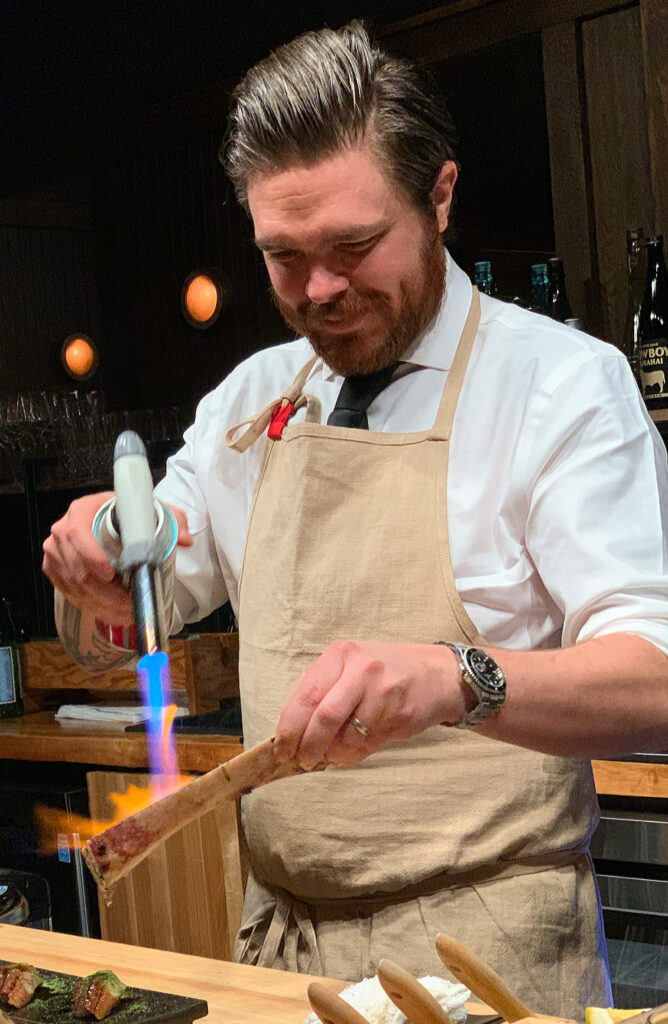
Lee puts an exclamation point on this personal approach to omakase when he admits that he’s a “social butterfly” who often struggled with the reality that “deciding to cook means giving up social interactions.” His favorite style of dining, thus, is the counter format because you get to “make new friends every night.” The chef met his “best friends” when they were sitting across from him one night, as well as his daughter’s godfather (who he cooked for some 10 years ago).
In driving this point home, Lee touches on the heart and soul of hospitality: the role it plays in encouraging the kind of social bonding the gives life meaning. It helps you view the chef not as deluded but just entirely focused on forging those memorable evenings and lifelong connections. Appreciating the finer points of a craft like sushi does not necessarily preclude these kinds of interactions, but it only takes one snob to poison the entire counter. Just the same, it only takes one uncouth customer to ruin even an eminently welcoming environment; however, Lee has chosen his extreme to work within and does an admirable job of curating the kinds of evenings he personally enjoys. There is a real element of doing what he most loves that undergirds the Sushi by Scratch Restaurants concept, and you think the chef deserves respect for pursuing his passion in a singular way (even—or especially—if it invites ridicule from purists).
Lee, quite simply, puts on the best omakase “show” in Chicago. You can only really compare his tableside manner to someone like Joe Flamm (another Top Chef veteran) when he’s working—perhaps with a bit more earnestness and likability—the chef’s counter at Rose Mary. And you think Lee’s style is pretty sure to please the vast majority of the city’s diners until they come to better the appreciate the quiet sincerity of chefs like Iliana Regan, John Shields, and Noah Sandoval (or the absolute raw authenticity of someone like Otto Phan).
Unfortunately, after putting his two months in and earning Sushi by Scratch Restaurants a slew of positive Yelp and Google reviews, Lee has left his position at the center of the counter. It is unclear when—or if—he will ever come to work in Chicago for a notable period of time again. And, unfortunately, his absence has seen the performative aspect of the concept (its strength by far) totally collapse.
Lee’s understudies behind the counter (you have only observed one firsthand but believe there are at least two who take on the main role) are nice enough. They welcome you in, recite the same opening spiel, and note the various fish and toppings that make up each bite. However, other than that, the replacement chefs are pretty much passengers: garden-variety itamae that default to stoically going about their business as the guests amuse themselves. Yes, you can engage them a bit more easily than their peers who do not speak English natively. They might coyly smile and laugh at what they hear going on in front of them. But these understudies do not command the room nor even begin to entertain patrons in the same flowing fashion. For they lack Lee’s natural tendency to schmooze, and it is from this foundation of friendly banter that all the meal’s more meaningful storytelling can insert itself.
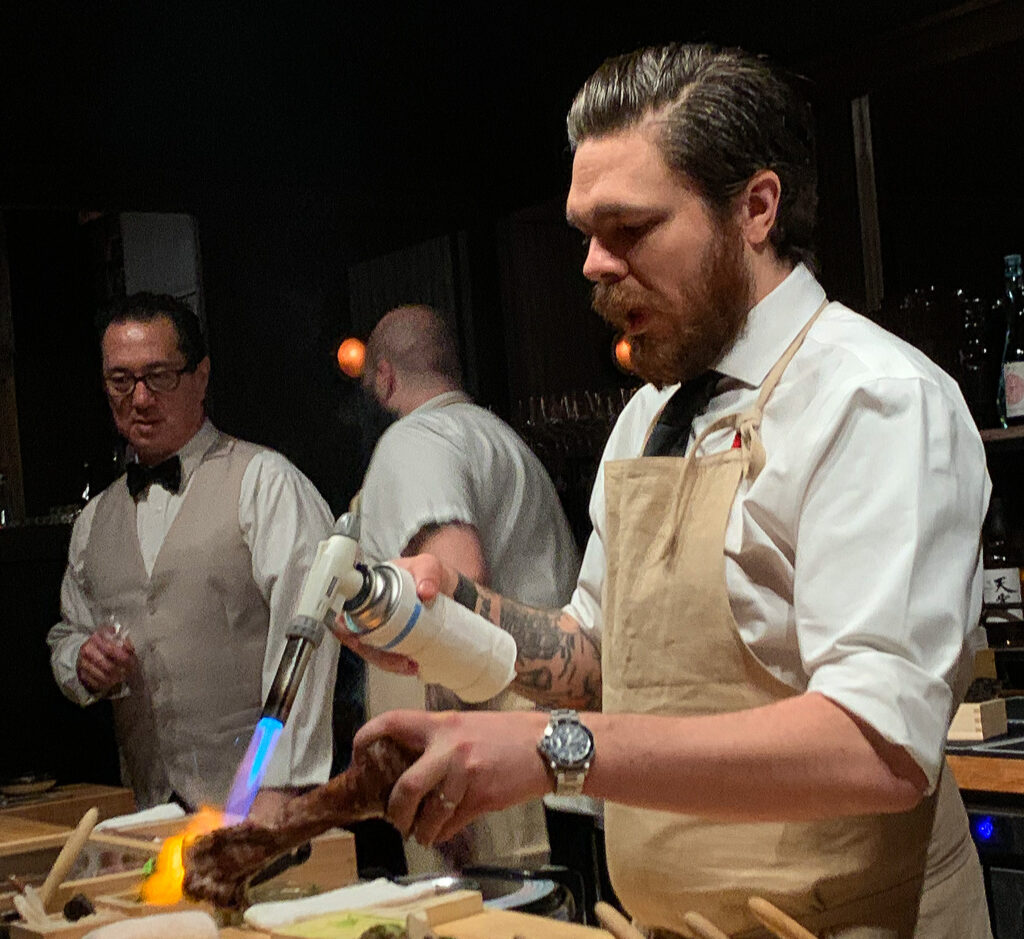
Yes, while you think the performance Chan and Kitano put on at The Omakase Room feels a bit shallow and contrived when compared to Lee in his full glory, the second-string Sushi by Scratch Restaurants chefs are rank amateurs. Their timidness—a total willingness to slink into the background and focus on nothing more than garnishing prefabricated nigiri—makes LEYE’s “show” seem absolutely gripping now. Of course, maybe few craftspeople ever envision having to master comedic timing and delivery as part of their skillset. Yet this blend of entertainment and broadly appealing sushi forms the very heart of Lee’s brand, and its recipes (vis-à-vis creatively topping the fish) were decided a long time ago. The main chef, each and every evening, really has no other job than to sprinkle some salt, brush some soy, and keep the party going. When they not only fail to capture the same mood as their founder but, in truth, do not even seem to try, you cannot help but feel that Lee has totally failed in hiring an adequate replacement. The experience transforms from a three-dimensional, rollicking onslaught of fish and rice into a stiff, lifeless affair set within an increasingly muggy basement.
Considering how hard it is to get a reservation at Sushi by Scratch Restaurants these days, few Chicagoans—by the time they make their inaugural visit—will have any sense how much better the meal was with Lee in town. These consumers, no doubt, will see all the hype the founding chef generated, but they will wrongly assume that food and setting alone can make up for what was primarily an interaction-driven experience at its peak. Sushi by Scratch Restaurants, without Phillip Frankland Lee there to serve you (or, as it was with the Montecito location, his brother), is totally underwhelming, and the deluge of positive reviews drawn from the founding chef’s early presence almost feels like a bait-and-switch. That experience is gone forever, and what remains is not only the same food minus a great performance. By failing to rise to the occasion and confidently direct proceedings, the understudies—in effect—let the customers control the conversation at the bar. In doing so, the chefs abandon any pretense of setting the mood and leave your evening at the mercy of the accompanying diners’ proclivities.
This sounds a lot like how most sushi counters, due to their fundamental intimacy, operate; however, you must remember that Sushi by Scratch Restaurants attracts a unique demographic. The concept—“a playful reverie on new wave nigiri…in a free form interpretive take”—appeals to people who crave a sense of luxury but consciously dislike the quiet, worshipful approach to omakase seen elsewhere. Lee promises they do not need to be constrained when they sit down before him, and many of the more talkative customers see themselves as just as much the “star” of the show. The founding chef ingeniously draws on this energy to hit some of his favorite marks and regale the rest of the audience. However, in his absence, the inmates are left to run the asylum, with the most gregarious of your fellow diners being granted the privilege of deciding how your night—everyone’s night—is going to go.
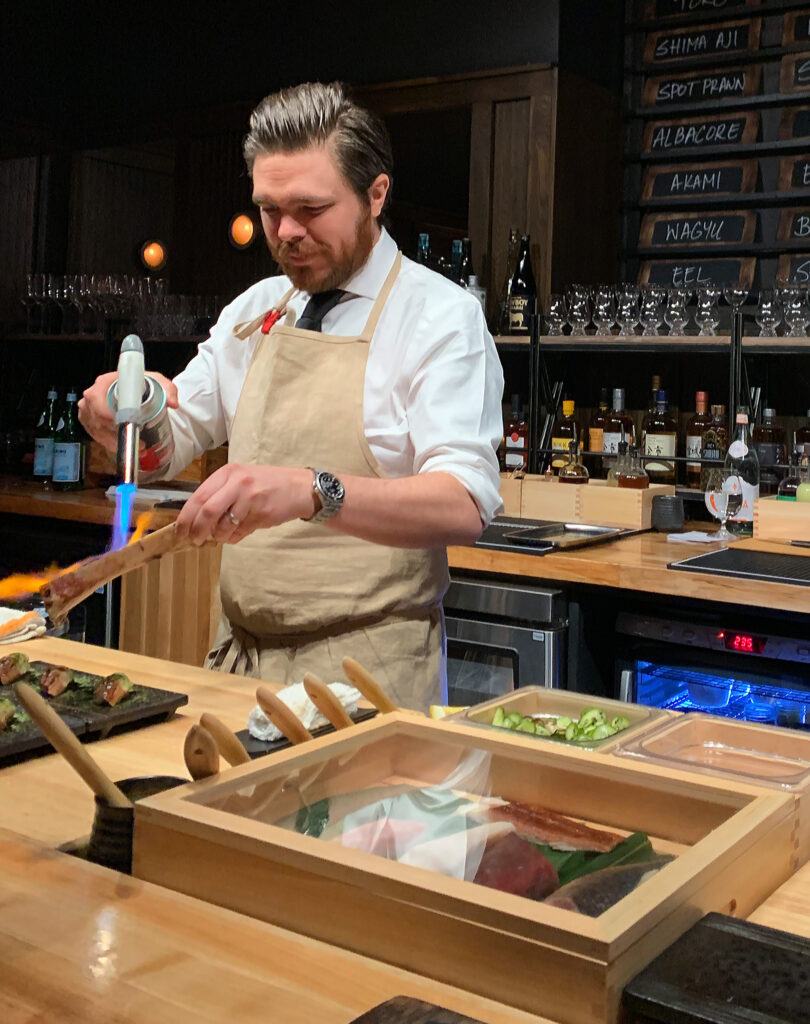
When the understudy chefs fail to adequately conduct the counter, you are left exposed to just about the most obnoxious crowd of “foodies” in all of Chicago: people who wish to associate themselves with the sophistication of omakase but are unable or unwilling to work to understand it. In short, they are conspicuous consumers with more money than taste, and they are more than happy to ask the assembled customers about their sex lives in order to infuse their evening—bereft of Lee’s colorful commentary—with a bit of excitement. Yes, this really happened during your third visit (courtesy of one slimeball), and the majority of guests grinned uncomfortably through the ordeal (though at least you were treated to a shot of sake for your trouble). Lee, no doubt, would have found a way to pivot the conversation, but his understudies just reacted with shock and went about their business. It is hard to imagine LEYE ever allowing such an ugly imposition to occur (even though Chan, to his discredit, has allowed patrons to make phone calls while seated at the counter during service). And perhaps all of the city’s other omakases, even if comparably boring, use the seriousness of their tone to preclude unwelcome conversation between guests. Sushi by Scratch Restaurant’s virtue quickly transforms into a vice when this kind of intimate interaction, untethered from any cohesive performance by the chef, is steered by the least inhibited of those present.
With Lee gone and elements like ambiance and beverage existing primarily to synergize with his performance, the restaurant’s quality rests more than ever on its food. You do not think this “new wave nigiri” was ever meant to stand on its own without the benefit of such an engrossing “show.” For zany toppings form an easy route to “reinventing” omakase when mastering—then reimagining—the fundamentals in some subtle way proves far too slow a process in the contemporary instant gratification culture. And Lee is hardly the first to hone in on this gimmick (even if he cleverly connects the garnishes to his personal story). Thus, the chef’s recipes must be judged rigorously against all other examples of the craft on the basis of textural intricacy, balance of flavors, and overall intensity.
“Authenticity,” being nothing more than a cudgel with which to assert false “expertise” and stifle creativity, does not enter into your equation as a valuable metric of establishing quality. Rather, you view Lee’s work as sidestepping tradition in pursuit of a much higher, more distinctly “American” peak of pleasure (with all the rewards that entails). Just the same, such a strategy runs the risk of floundering and revealing why certain norms regarding apprenticeship and training are so essential. However, you will approach the food at Sushi by Scratch Restaurants with the most open of minds, acknowledging—right or wrong—the chance that such a unique vision may present a real paradigm shift. At the very least, the concept stands to transform how Chicagoans think of sushi whether or not they ever seek out this distinct style again.
Across your three visits, the menu at Sushi by Scratch Restaurants has generally stayed the same. Only the “Blue Fin Tessin,” some time between your first and second meals, has seen itself transferred from the blackboard to become one of the opening bites in the lounge. The “Kampachi” that replaced it has—in turn—become a fixture, meaning that you can easily track the level of consistency (or lack thereof) from when Lee ran the counter to the present day work of his understudies. Likewise, many of the à la carte pieces offered at the end of the meal have stayed the same, allowing you to better—with repeat exposure—evaluate their value proposition.
The meal begins with what might be Lee’s most signature of all pieces (and the same one he showed off on WGN9). The chef’s “Hamachi” (a yellowtail, most likely farmed, whose exact origin is unstated) is advertised as being “painted yellow with sweet corn pudding and topped with a fine sprinkle of breadcrumbs made from Kallas-Lee’s sourdough” in what forms the ultimate emblem of his personal, self-expressive approach to the craft. In practice, the fish is sliced rather generously so that it spills over the sides of the short-grain rice base. Its surface displays a creamy yellow sheen (moreso when Lee was behind the bar, less when left to his understudies) with brown traces from the housemade soy sauce. A sprinkle of Bali salt, the aforementioned sourdough breadcrumbs, and some bits of freshly grated wasabi crown the top while slightly melting into the moist coating.
Taken in one go, the “Hamachi” displays a slick, oily texture on the tongue that easily breaks apart with further mastication. The various toppings do not contribute all that much to the mouthfeel, yet the fish’s rich, buttery, and ultimately mild flavor is enlivened by a measured dose of sweetness drawn from the corn pudding. This distinguishing element shows an admirable degree of restraint and some pleasing depth that avoids obscuring the raw fish with any unnatural sense of confection. The breadcrumb element, by comparison, is hard to perceive; however, the subtle sourdough notes may do something to amplify the corn. Overall, this piece lacks a bit of textural nuance (one drawn from the interplay of fish and rice itself) but achieves a highly pleasing flavor that will delight most guests. (Though the “corn pudding” trick, you must note, has been executed far better—as far back as 2020—via Kyōten’s “Crab & Corn Sorbet.”)
The arrival of the next course, “Toro,” reflects a certain desire to swing for the fences. This piece, on the back of the lounge’s “Blue Fin Tessin” bite, also represents the second of three servings showcasing this fish throughout the evening. By positioning this coveted cut of tuna belly so early on (as Otto Phan, to his credit, did for quite some time), Lee looks to shock and awe his guests with one of omakase’s most superlative ingredients. There is no need to slowly build up to this kind of pleasure through a range of strange fish. Rather, knowing that some part of his target demographic may be lukewarm (if not downright skeptical) regarding sushi, the chef looks to invite them into the promised land right away, to kick off a celebration in which everyone dining at the counter immediately knows just how good nigiri can be.
The “Toro” at Sushi by Scratch Restaurants is treated in a fairly orthodox fashion. You note the beautiful, crosshatched scoring that accents the tuna’s flesh (though this technique has been executed a bit less elegantly during subsequent visits), as well as the fine pockets of marbling that distinguish it from the meatier section of the fish served later on. The piece is brushed with soy sauce, sprinkled with salt, and topped with a couple pieces of brown sugar-cured pineapple before being very carefully torched at an angle that is nearly parallel to the nigiri. A speck of wasabi completes the presentation, with the tuna’s rendered fat—as it slowly moistens the plate—begs you to go in for a bite. When it reaches the palate, the “Toro” melts cleanly but a bit too easily. You do not really get a chance to massage any bursting reservoirs of fat with your tongue or savor any streaks of flesh that highlight the pristine tenderness of tuna. Rather, the belly cut devolves into a puddle of fat that is marked by a slightly sweet, tangy note from the pineapple. This is not bad but, perhaps, just a little one-note and lacking in its finish. The bite feels like a plain expression of fat (and sugar) more than it does a singular cut of prized fish.
Thankfully, Lee’s “Kampachi” (another species of yellowtail sourced, in this case, from Hawaii) is an improvement. The fish is treated more delicately than most in the chef’s roster, receiving—apart from the ubiquitous soy sauce and salt—only a topping of pickled wasabi stems. Compared to the rhizome portion from which the paste is usually grated, this dark green, crunchy segment of the plant yields a more mild expression of heat. Nonetheless, those diners that opted for the $85 upgrade to their omakase will find, here, the first appearance of truffle: Périgords that are microplaned along the length of the fish.
When it reaches your tongue, the “Kampachi” displays more firmness than the “Toro” and “Hamachi” that came before it. It still maintains a decadently slick, oily texture, but you like how the flesh shows greater persistence on the palate—one that allows you to appreciate its weight without totally melting. The yellowtail’s flavor, when accented only by the pickled wasabi stem, is buttery and mildly sweet with a bright, tingly finish. When blanketed by the thin strands of truffle, the fish picks up a bit of earthiness that increases the bite’s overall complexity and, thus, amplifies its latent umami. You are not quite sold on the use of Périgord here, but the luxury supplement certainly doesn’t hurt in making a fundamentally balanced piece of nigiri feel a bit more special. Otherwise, this forms one of Lee’s more restrained and successful combinations on account of its superior texture.
You might, at this point in the menu, begin to enjoy the bowl of pickles that has been sitting on the counter since your arrival. Rather than only comprising the usual slices of ginger, Lee’s blend of palate cleansers includes cucumbers and shiitake mushrooms interspersed with sesame seeds. The three types of pickles each offer a different degree of crunch (or, in the case of the fungus, a subtle chew) and soak up the mild, balanced brine in varying amounts. Some diners might dislike the fact that there is relatively little ginger in the mixture, but the cucumbers likely form a friendlier introduction to the concept of refreshing your tastebuds between pieces of nigiri. Plus, the chefs are happy to refill your bowl as often as necessary and will even only give you the ginger if requested (though Lee, to his credit, was far more proactive than his understudy in this regard).
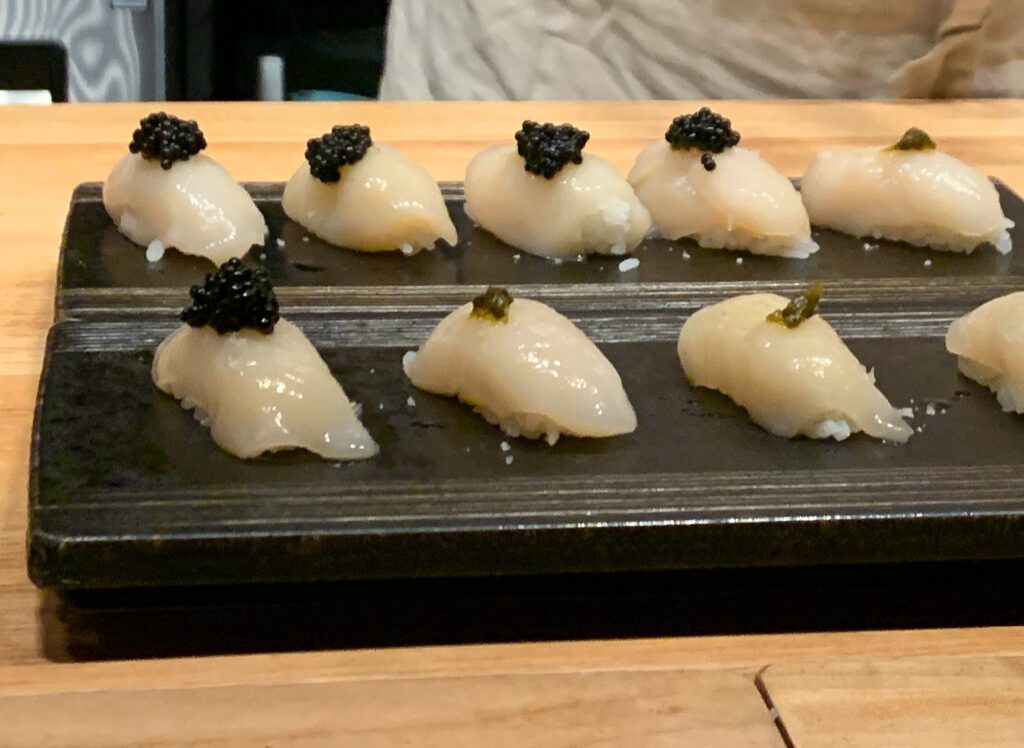
The next course signals the arrival of one of your favorite ingredients (at least as it pertains to nigiri): “Scallop.” The bivalve, seared and paired with some puréed seasonal vegetable, remains a favorite trope of Western fine dining; however, you have come to prefer the soft, creamy texture they display when served raw. Lee, himself, must be a fan, for he tops the rather long, thin surface of the shellfish (a marvel of knifework in its own right) with a dollop of Italian osetra caviar. But that coveted roe, of course, is only for those who have purchased the $85 supplement. The piece otherwise receives the classic garnish of soy sauce, salt, and—in this case—a bit of poblano pepper.
Upon reaching the palate, the “Scallop” glides against the roof of your mouth, accentuating its supple flesh, before smoothly breaking off into chunks with a couple bites. The bivalve’s latent sweetness is amplified by the soy and salt, but it is the poblano—mildly hot, slightly smoky, and a bit sweet in its own right—that makes the bite memorable. The mere thimbleful of pepper charges the expansive surface of the scallop with a brightness and depth that is reminiscent of ceviche. Unfortunately, the caviar, whose texture can be perceived as mushy even via the pictures, gets entirely lost in the equation (but, hey, it looks pretty). Nonetheless, this still makes for a good to very good piece that ranks as one of the meal’s finest (even if, in Lee’s absence, the quality—both in terms of texture and flavor—has already dipped).
“Shima Aji” (or striped jack) stands as another one of your favorite ingredients, being the star of a legendary series of dishes (fish ribs and all!) back during Smyth’s pre-pandemic era. It has also always marked itself, from your earliest days eating omakase, as one of the meal’s most flavorful pieces even in the hands of a highly traditional chef. For Lee, of course, that means an opportunity to push the striped jack into the stratosphere with a yuzu koshō (or fermented citrus condiment) made using Fresno chiles and “painted on” in the same manner as the “Hamachi’s” corn pudding. (The soy sauce and salt, as always, are also present.)
At its best, this “Shima Aji” piece has displayed a wonderful hint of opening firmness that quickly yields to a tender, buttery interior. Its flavor, likewise, has offered a good deal of umami with a hint of sweetness that is enlivened by the tang and measured spice of the Fresno yuzu koshō. However, with Lee’s departure, you have found that the fish has become a bit too chewy and has been painted far more sparingly with the reddish condiment. This presents a clear step backward from when the founding chef worked the counter, and the bite—likewise—has gone from one of your favorites on the menu to one that ranks near the bottom. Considering the recipe was already perfected, this is a disappointment.
The ”Madai” (or red sea bream), luckily, has proven a bit more resilient in Lee’s absence. The fish also presents an opportunity—for those who indulged in the supplement—to make use of truffles once more. The Périgords (later replaced by Bianchettos from Italy) join the soy sauce, flaky salt, and a few scallions on top of the piece. Once more, the coverage provided by the totemic luxury ingredient, which contrasts the sea bream’s pale, white flesh beautifully, is laudable even if the ultimate effect on flavor is negligible. When the chef slyly whispers its presence only to those of you suckers who paid the extra sum, the interaction does—at least—feel special.
Truffle topping or not, the “Madai” is a success. The flesh of the fish is more firm than any you have encountered up until this point in the night, yet there is no sense of stringiness as you break it apart in your mouth. Instead, the sea bream offers a pleasing sense of succulence echoed by an ample, savory flavor tinged with natural sweetness. The sharp (yet subtle) contrast of the scallions helps drive the piece’s intensity even higher while the Périgords (or inferior Bianchettos) offer a hint of earthiness that is innocuous if uninspired. Overall, this makes for a good and fairly orthodox bite of nigiri. You think Sushi by Scratch Restaurants certainly puts its best foot forward with these more flavorful fish.
Lee’s “Spot Prawn,” nonetheless, represents a chance for the chef to take something familiar (shrimp, de Jonghe style or not, remaining one of the city’s obsessions) and prepare it in an unexpected way. The ingredient, in this case, is sourced from Vancouver and sees the meat from its head ground in a mortar and pestle with a bit of Santa Barbara olive oil. The resulting spread is then applied to the prawn and brûléed tableside using a torch. Some soy sauce, flakes of matcha salt, and a bit of wasabi complete the presentation.
Taken in one bite, the “Spot Prawn” displays a pleasant plumpness on the palate (though, noticing a bit of sliminess, you would like it to be just a bit more firm). The piece breaks apart cleanly as you chew it and unleashes its juices on the tongue, marrying with the brûléed head paste and infusing into the rice. The resulting flavor is a bit smoky with a noticeable tinge of iron. The prawn itself is not all that sweet but, rather, remains decidedly savory with a bit of nuttiness drawn from the matcha salt. Overall, this is good but maybe not quite as good as you might expect. The head paste is a creative element yet does not quite meet the standard of being hedonistic. You think more sweetness, drawn from the character of the prawn itself, would help.
“Salmon,” surely, will also be familiar to the majority of guests, and it presents an opportunity—once more—for the chef to blow them away with a superlative rendition. In this case, the fish is sourced from Big Glory Bay in New Zealand then brushed with soy and salted in the familiar manner. However, the salmon is also distinguished by a touch of extra-virgin olive oil that is used to aid in torching its top. The finishing touch comes by way of those pickled wasabi stems and—for those indulging in the supplement—a dollop of caviar. (It is worth mentioning the transition from the smaller scoop of more greenish, high-quality roe utilized when Lee was working the counter to the larger portion of blackish, mushy caviar used in his absence. Considering the Périgord truffles were also superior to their eventual replacement, it seems right to question if the luxury ingredients have been downgraded despite the restaurant still charging $85?)
Diving in, the “Salmon” displays a smooth, soft texture that is helped along by the oily sheen drawn out from its torching. The fish melts upon reaching your tongue, but the caviar—regardless of type—struggles to assert any kind of telltale pop. Instead, the piece strikes you with its rich, clean flavor and a measured dose of sharpness drawn from the wasabi stems. You might be inclined to term this bite a bit boring, but, like the “Madai,” it succeeds (mildly) by feeling more traditional than many of Lee’s recipes. In doing so, it helps lead his audience toward a more comprehensive appreciation of the craft that is not rooted entirely in novel toppings.
But, speak of the devil, next arrives Lee’s “Albacore”—the chef’s homage to the “Seared Spicy Albacore w/ Crispy Onion” served by Katsu-Ya in Studio City. This piece, made using the “more environmentally friendly” longfin (or “white”) tuna, is one of Sushi by Scratch Restaurants’s masterpieces. Unlike the Katsu-Ya dish, which is served as sashimi, Lee’s rendition—in keeping with the flow of the meal—maintains a nigiri form. He grills the fish, chills it, brushes it with soy, tops it with salt and wasabi, then applies the finishing touch: a tangle of dehydrated Spanish yellow onions.
The ”Albacore,” at its best, combines the firm (yet ultimately tender) texture and mild flavor of the fish with the delightfully crunchy, deeply sweet flavor of the Spanish onions. In Lee’s hands the bite is perfectly constructed and supremely balanced, forming a testament to how his particular style of omakase may engage diners who struggle to see the appeal of comparably “plain” pieces. The story behind the chef’s inspiration, while really just amounting to him growing up eating really good sushi, emotionally primes guests and enhances their pleasure. Even the sustainable angle to the ingredient, though not emphasized, is something to feel good about. However, Lee’s understudies have again let him down. In the founding chef’s absence, the ”Albacore” has been unevenly grilled (note the divergent color of the pieces) and topped far too sparingly with the crispy onions. What has often been among the very best bites of the evening has now merely become “good.” What a shame.
The “Saba” (technically hon saba or Pacific chub mackerel) forms another one of the meal’s more aggressively topped pieces, and it is once again inspired by the chef’s childhood. More particularly, it represents a play on the “dynamite roll” style of maki he would eat in the Valley featuring a tempura-coated (usually shrimp) filling and a spicy Japanese mayonnaise topping (often broiled). Lee, in effect, deconstructs the recipe using his mackerel. Instead of mayo, he makes a mustard out of beets that is generously brushed onto the fish. Rather than broiling the piece, he hits it with the torch. And, rather than frying anything tempura-style, he applies puffed quinoa to replicate that crunch.
As with the “Albacore,” the result of this hodgepodge can be quite appealing when Lee is behind the counter. The “Saba” possesses a rather fatty, oily texture that, thanks to the torching, is rendered nicely and allows the flesh to gently flake on the palate. The beet mustard, while seemingly out of left field, does well to match (and balance) the mackerel’s fishy, slightly sour flavor with a bit of sweetness and a hint of sharpness. Through this pairing, the fish’s deep umami comes to the fore as the nutty crunch of the puffed quinoa combines with the last traces of fat to provide a rousing finish. This is undoubtedly one of the chef’s boldest bites, made all the more impressive by the fact that it actually works. Nonetheless, once more, his understudies do not do it justice. As seen in your pictures, they torch the piece far less, apply too little of the beet mustard, and barely put any of the puffed quinoa by comparison. This leads to any expression of the mackerel that is vaguely salty and a good deal more fishy. This is a letdown.
With the arrival of the “Akami,” you reach the third of three pieces of bluefin tuna heralded at the start of the meal. This part of the fish—relative to the tail and belly segments served earlier—is characterized by its leanness and the resulting intensity of flavor that comes from less of that melting fat. Lee explains that his “Akami” is actually aged for six days (being flipped every night at midnight) and achieves a texture that “rivals raw venison carpaccio.” In keeping with the level of care the chef gives to this ingredient, he serves it with nothing more than soy sauce, a sprinkle of salt, and wasabi.
On the back of the “Albacore” and “Saba” pieces, this bite of lean tuna is admirably restrained. The fish, upon reaching your tongue, displays a pleasing firmness that turns smooth and tender with further mastication. However, while “Akami” is known for its meatier, bolder flavor, you find Lee’s rendition to be rather subdued. Texturally, the bite is totally fine, but neither soy, nor salt, nor wasabi really does all that much to set off the kind of fireworks you would expect from this tuna’s late appearance in the menu. Overall, your perception of this piece has remained consistent no matter the chef behind the counter: it is good—not great—and probably a bit underwhelming given the ingredient’s pedigree. Perhaps a different aging regiment or, dare you say, some more aggressive topping would offer an improvement?
Lee’s “Escolar,” sourced from Korea, may seem similar to the “Albacore” at first glance. Yet the former fish—sometimes called “butterfish” or “white tuna”—is more precisely a part of the snake mackerel family (while the latter fish, despite being nicknamed in a similar fashion, is truly a species of tuna). Exact identity aside, the “Escolar” makes for one of the evening’s prettiest pieces. The fish’s milky white flesh is lightly scored and expertly torched (with a bit of soy) in such a manner that leaves a gorgeous, gridlike pattern of char across its surface. Apart from the usual wasabi, the finishing touch comes from a few orbs of ikura (or salmon roe), which allow everyone at the counter to get a taste of “caviar” without ponying up that $85.
On the palate, the “Escolar” displays a smooth, oily texture with just a little more structure and staying power than bites like the “Toro” (that were a bit too prone to melting). This allows the piece to caress the inside of your mouth and—in a way none of the caviar supplements could quite achieve—highlights the pop of the salmon roe. In terms of flavor, the snake mackerel is beautifully rich with a buttery quality that really does rival tuna (of course, one must always be careful not to consume too much of it). Though the ikura adds faintly sweet and briny notes into the equation, you would, perhaps, just like a touch more contrast (as the restaurant’s wasabi is also rather hard to discern throughout the entire meal). Nonetheless, the “Escolar” represents a fairly cohesive, rather decadent bite that ranks as one of the evening’s best.
With the arrival of the “Wagyu,” Lee signals that the omakase will soon reach its crescendo. While the “Not A Damn Chance Burger” featured upstairs makes use of beef from Iron Table Wagyu in Texas, the chef opts for something a little more luxurious downstairs: center-cut ribeye from Hokkaido with a BMS (beef marbling score) of 11 (out of 12). This prized steak is torched “super hard” so that it caramelizes in its own fat before being topped with soy sauce, salt, and a bit of wasabi. Truffles, for those enjoying the supplement, also make another (and a bit more conventional) appearance here.
Taken in one bite, the rendered fat of the Hokkaido ribeye really does mirror some of the meal’s most decadent cuts of fish. The meat offers enough resistance to withstand a couple chews but, soon enough, melts altogether. This sensation is pleasurable but somewhat removed from the feeling of substance you desire when eating steak. Nonetheless, the wagyu is totally pristine in its flavor—perhaps even a little too subtle on account of the surfeit of fat—and ranks as one of the highest quality ingredients served across the omakase (relative to many fish that would struggle to impress without their toppings). Ideally, you might like a bit more salt or a more forceful expression of wasabi to be utilized here. For even the truffle, while forming a nice accent, does not exactly do much as a flavoring agent. Still, this is a crowd-pleasing bite that is sure to please the Sushi by Scratch Restaurants audience and tastes every bit as good as a similar piece served at The Omakase Room.
Following this serving of “Wagyu,” Lee’s helpers retrieve a tray stacked with beef bones. They go about removing glossy chunks of marrow from each of them, setting about half of what they extricate to the side. This portion is used in a piece aptly titled “Bone Marrow,” which involves torching the fatty deposits as they sit atop rice and garnishing them, rather simply, with soy, salt, and wasabi. Guests are instructed to take this bite quickly before its star ingredient has a chance to cool. Doing so, the marrow displays an ethereal, supremely melty texture with a moderate umami character and a transfixing kiss of sweetness. This is very nice.
Nonetheless, the piece that follows—a signature dish Lee prizes even more than his “Hamachi”—ups the ante even further. The chef thinly slices unagi (or freshwater eel) and seasons it liberally with matcha green tea, dried shiitake mushroom, and kelp salt. He then retrieves the remaining portion of marrow, sets it back into the bone, and uses a torch to drip the fatty substance over the nigiri. Discarding the bone, Lee turns the torch directly onto the eel in order to crisp it. He quickly applies a garnish of soy, lemon, salt, and poblano yuzu koshō before instructing guests—playfully cheering “take that bite! take that bite!” as necessary—to consume the piece as quickly as possible.
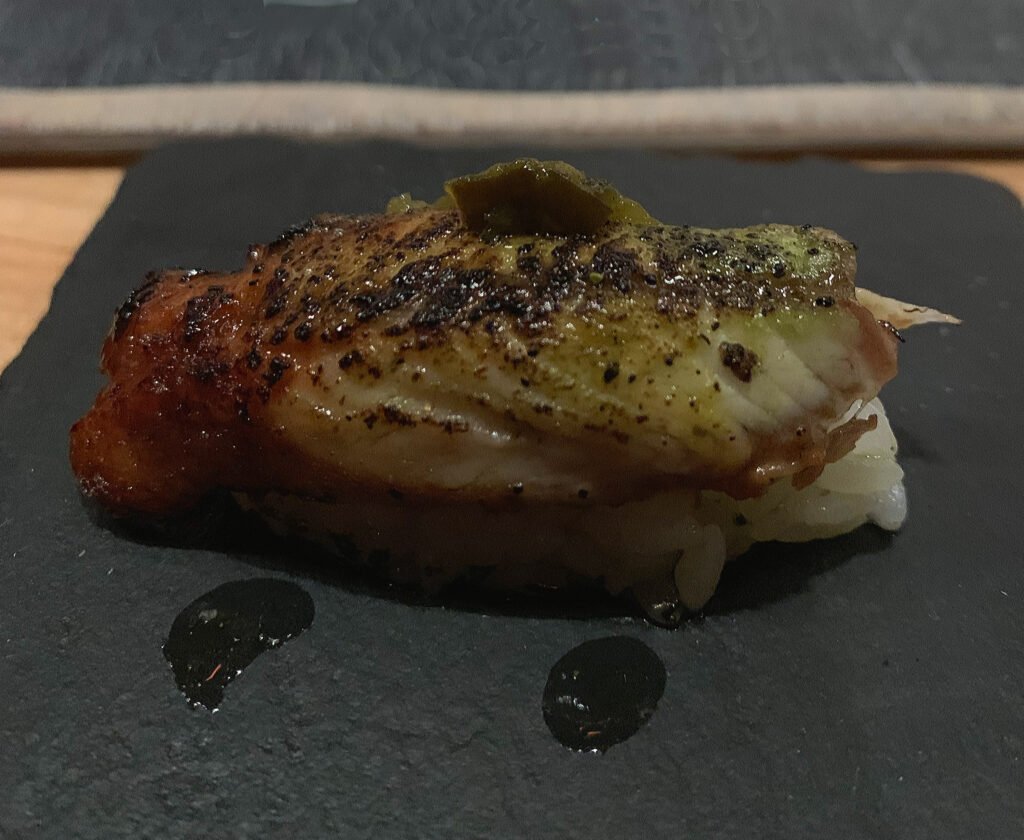
Despite so much going on, the “Eel” ultimately represents the very quintessence of Lee’s style. While so much of his nigiri is made in an assembly-line manner, this piece—centering on the unagi’s crispness—necessitates a privileging of texture and à la minute service that is totally absent throughout the rest of the meal. Eel, often drowned in that ubiquitous, thickened sauce, also absolutely demands the kind of heavy-handed seasoning the chef is known for (though Otto Phan, emphasizing freshness, has certainly succeeded in offering a far lighter touch). Ultimately, the layers of matcha, shiitake, kelp, soy, and salt amount to an extraordinary expression of nutty, earthy umami—amplified by the tang and spice of the yuzu koshō—that teases out the latent sweetness of the unagi. Texturally, the fish crunches then flakes gently against your palate before slowly fading out on a tide of succulent beef fat that leaves you licking your lips in delight. Overall, the “Eel” offers a complete, memorable gustatory experience unlike anything else Sushi by Scratch Restaurants serves. It stands, perhaps, as the one and only piece that would induce you to make another visit there.
Lee saves “Sea Urchin” as the last bite of the menu—discounting any à la carte additions—before dessert. You think that is a bit curious (for the “Eel” is so powerful and unitypically a bit more subdued) but can also see how the creamy orange lobes prepare the palate for something sweet. Judging by the tray, the chef’s sea urchin seems to be sourced from Hokkaido (even if you cannot remember that being verbalized). When it comes time to serve, his two assistants each wrap a mound of rice around a sheet of nori and hold it toward the center. Lee spoons the uni into the waiting hands on both sides then returns with a brush of soy and a sprinkle of matcha salt. Those who have purchased the supplement will also receive a grating of truffle before the two auxiliary chefs hand the seaweed, one at a time, to the waiting customers.
As with the previous piece, you appreciate that the restaurant is willing to sacrifice its assembly-line style of production when the situation calls for it. The nori, compared to its appearance in the opening “Blue Fin Tessin” bite, displays much better crispness (while still falling short of the most expertly toasted examples). It retains its structure in your hand and breaks apart cleanly on the palate, unleashing its filling. The sea urchin, in its own right, is creamy and melts easily into the rice. The lobes do not offer luscious, mouthfilling quality of more premium boxes but are a fair representation of the ingredient. With regard to flavor, the uni shows a good bit of that irony, deep sea quality without going overboard. Rather, this character helps to balance the nutty tones of the matcha salt (and the earthiness of the truffle when present). Ultimately, this makes for a good (though not great) rendition of sea urchin that does justice to the ingredient’s coveted status and helps newcomers comprehend what its flavor is all about. Respectable.
At this point, Lee graciously thanks his audience and notes that the omakase is now drawing to a close. The “good news,” he might mention, is that time allows for those extra pieces he mentioned at the start of the meal. The “bad news,” however, is that they will cost you extra. This framing, while the actual price of the à la carte bites is obscured, forms a friendly way of avoiding any potential sticker shock (at least for those who might assume these bites are totally free). It also makes it rather easy to refuse these supplements altogether and skip straight to dessert, which the chefs will serve immediately (rather than make you wait for the other guests to finish).
In your experience, the 5 PM seating typically ends around 6:30 PM (the timing of which allows for as many as four extra pieces). However, dinner has stretched to 6:50 PM on one occasion and only allowed for two of these bonus bites to be ordered. (Lee likes to joke that guests at the 9:30 PM seating technically have until 5 PM the next day to eat as many additional pieces of sushi as they like—with the record, set in Texas, standing at 100.)
As a supplement, you have first sampled the “Kinmedai” ($14), a fish also known as golden eye snapper. The piece is notable, across a wide range of restaurants, for the strip of skin it is served with. Lee, in the typical fashion, uses his torch to crisp the scales and impart a beautiful crosshatched pattern of charring. Otherwise, he only garnishes the bite with the classic combination of soy, salt, and wasabi. On the palate, the “Kinmedai” displays a luscious coating of rendered fat combined with tender flesh that offers just the right amount of resistance against your teeth. The fish’s flavor is mild, but the torching—along with the usual garnishes— draws out enough umami to provide a delectable finish. This is a worthy add-on.
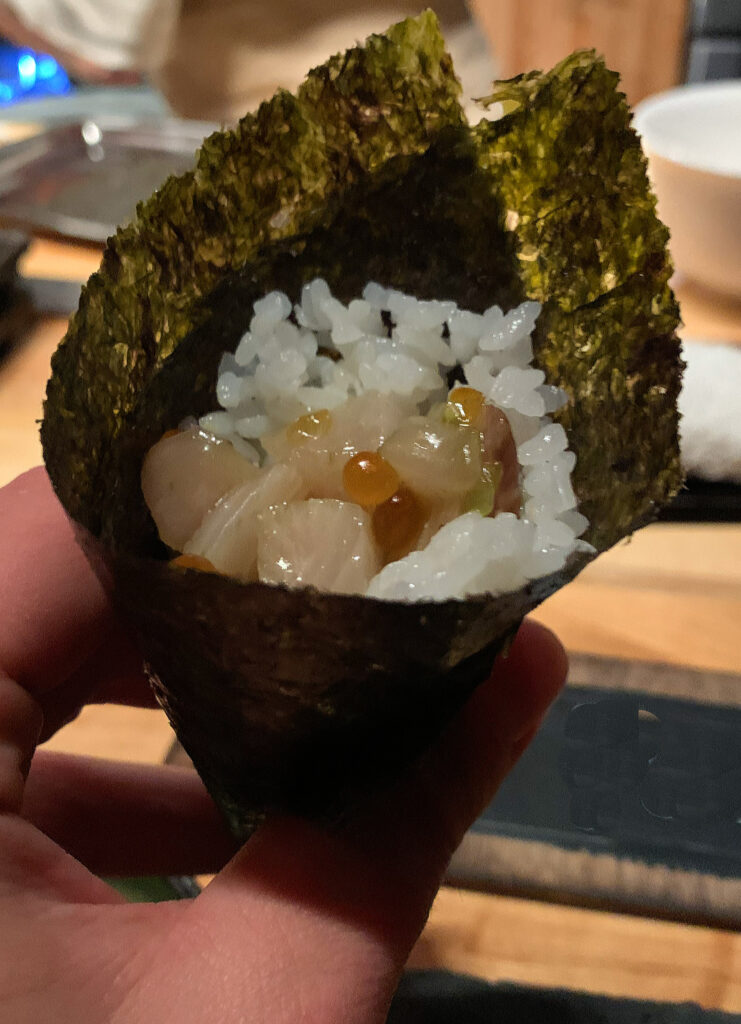
The “Threadfin” ($11), by comparison, offers Lee the chance to impress his audience with a proper handroll. The fish itself, one you have rarely encountered, is a kind of bream. It is seasoned with a bit of soy and joined by a few orbs of salmon roe in a cone-shape seaweed vessel filled with rice. The nori, as with the “Sea Urchin,” displays enough crispness but not so much to really impressive. At the very least, it does not stick to your mouth and allows the threadfin’s lean, subtly chewy (but ultimately tender) flesh to glide across the palate with some fleeting pops of ikura. The flavor here is fairly mild but helped along by the soy. Overall, this is not nearly as special as the tuna- and uni-filled handrolls served with every meal at Kyōten, but the price may be right for some patrons who want something more filling than distinctive.
Lastly, Lee’s “Foie Gras” ($15) supplement—always served after all the others—presents a luxurious way to once more see off the savory section of the menu and ready your palate for dessert. The chef places a slender lobe of the duck liver over rice and torches it with some brown sugar. Soy, salt, and wasabi help balance the sweetness in what is a smooth, rich, hedonistic expression of the luxury ingredient that surpasses many of the omakase’s mainstays. Lee deserves credit for preparing foie gras in a way that will appeal to many diners who might dislike more traditional fine dining preparations. However, with The Omakase Room and Kyōten both serving “the foie gras of the sea” (ankimo or monkfish liver), you wonder if the chef is playing things a bit safe. Still, while presenting a bit of a splurge, you think the bite is worth trying.
Whether or not you go for any of the supplements, dessert arrives courtesy of Kallas-Lee. The pastry chef’s “Matcha Bon Bon” is made with makrut lime ice cream and her housemade white chocolate on a white sesame shortbread. It is served alongside a cup of hot green tea flavored with plum wine, lavender honey, and fresh yuzu, making for an enthralling temperature contrast that elongates the pleasure of the two components. The bon bon itself must be taken in at least three bites, displaying a chewy—then melty—texture charged with plenty of tang and sweetness. Frankly, while you rue the absence of tamago (a dish you think Lee or Kallas-Lee could have a lot of fun with), the dessert is delightful. One of your dining companions even named it the best dish of the night (without a hint of malice). But, fundamentally, it succeeds in translating the boldness of texture and flavor that characterizes the savory side of the meal into a single sugary bite. Well done.
With dessert (and any supplements) now finished, the chef thanks the audience once more as the host transports the coatrack (used to hang your belongings upstairs) right behind you. Lee notes that you will walk up a separate staircase (opposite the one from which you entered) in order to pay your bill with the bartender. This not only allows the staff to manage the flow of the omakase’s next seating without customers crossing paths but serves an important psychological purpose. As the chef says, the dining room is for “food, fun, and tomfoolery” but not “payment.” You almost burst out laughing when hearing that the first time (and still stifled a chuckle the second), but the logic is sound.
Given the likely addition of a $110-$125 beverage pairing, the possible addition of a $85 supplement, and the other possible addition of up to $54 in extra pieces, that $165 entry price can rise to as much as $565 (after 20% service charge and tax). Those are Kyōten prices! And it makes sense to preclude any possibility of sticker shock—should someone get lost in the magic of evening and tack on all the frills—being associated with the chefs or the counter. Your spatial memory of the meal really does affect retention on a subconscious level, and compartmentalizing any bitterness about spending more than expected (by extricating it to a corridor that feels more a part of The Drop In) is smart. It clearly bookends the experience that begins when you punch the number into the keypad and separates the performance itself from any negative emotion. The use of a service charge (without any opportunity to provide discretionary gratuity), likewise, helps prevent you from lingering over the price you see on the screen.
Having paid, you make your way up a narrow staircase then weave your way through a storage area—complete with an obtrusive mop bucket you may need to push aside—and past another door that deposits you toward the rear of The Drop In. At this point in the evening, the bar is fairly busy, but, savoring the smell of the NADC Burger kitchen that lies to your right, you might decide to sit down for a spell. You sample the namesake burger ($16) and an order of “Beast Mode” fries ($6) while reflecting on the meal. Lee, you imagine, would wholeheartedly approve of this decision—knowing that his earlier seatings do not have the chance to order 100 additional pieces of nigiri. The burger is good—not great—and will never threaten Chicago’s best examples of the form (unless one feels particularly inclined to parrot Joe Rogan’s “taste”). You’ll even admit you found the fries, topped with melted cheese, onions, and a hearty dose of seasoning (in what almost seems spiritually akin to Lee’s sushi), more impressive. But being able to stop for another bite on the way out is still a big bonus—even if the combination of Kyōten + Red Hot Ranch is clearly superior.
Thoroughly full, you exit the bar and step back onto Milwaukee. The street is dark and deserted (the Jewel-Osco forming something of a beacon in the twilight). It is hard to imagine any kind of luxury dining being located here, yet the experience burns brightly in your memory: a time and place and performance without peer in its genre. Lee is a different breed of chef than what Chicagoans are used to, but is he the kind the city really needs?
The art of omakase is starting to come of age here, and its appeal is broadening beyond the dedicated “foodies” and well-traveled conspicuous consumers that eagerly awaited the chance to enjoy a craft that has become so pervasive in more major markets. LEYE’s entrance into the arena last year with the opening of The Omakase Room was a bellwether. Yume and Mako, with their Michelin stars, and Kyōten, with its idiosyncratic style of hyper-indulgence, had staked out their particular niches. But the Melmans’ embrace of this style of dining marks, to you, its introduction to the mainstream. LEYE has simply earned a level of consumer trust—especially with regard to service and value—that comforts sushi skeptics. The group can get people through the door that, for better or worse, would be averse to patronizing a comparable—but independent—restaurant.
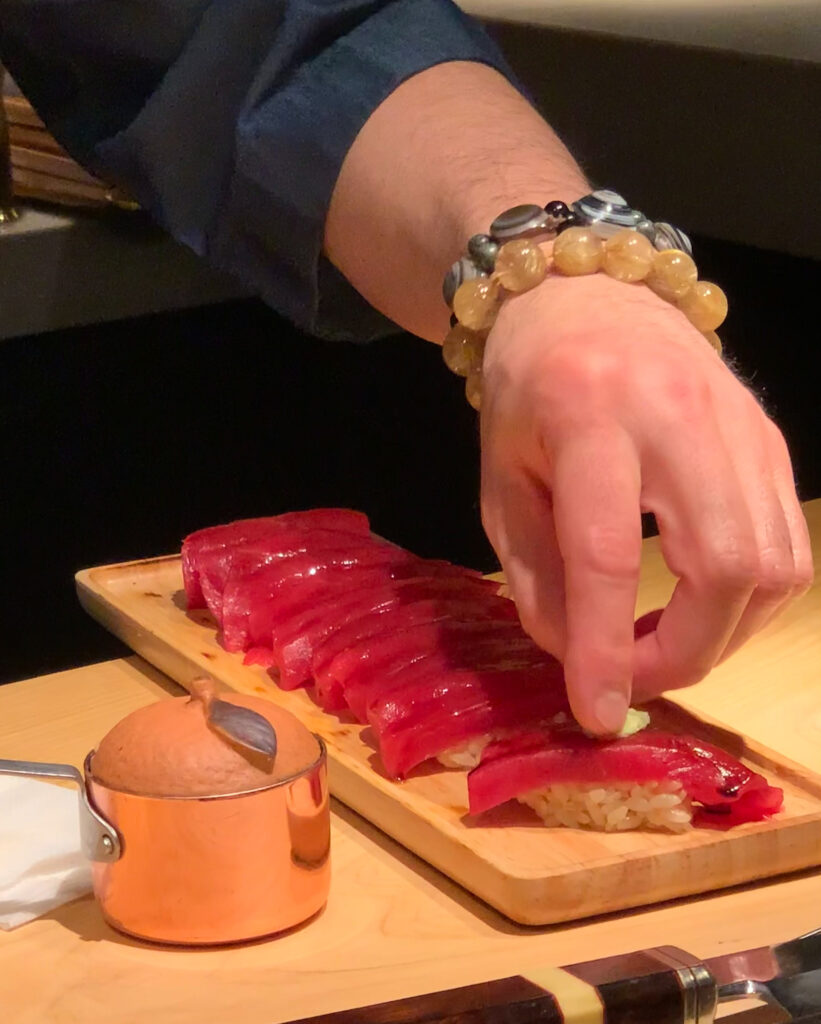
It was curious to you that The Omakase Room, despite enjoying this privileged status, played things so relatively safe. You still think the concept ranks as the second- or third-best in its genre within Chicago. However, copying a dish straight from Masa (then executing it in an inferior manner) and maintaining an assembly-line style of production (that undermines the quality of the rice) signaled that LEYE saw the city’s taste as immature. The group does not want to use all its resources to create an omakase of national caliber but, rather, has strategized exactly how it can leapfrog its competition without trying too hard. This, you wrote at the time, is a pretty big disappointment from a company once thought to be a luminary of American hospitality. The restaurant’s championing by local “critics”—without any reference to the Achilles heel that is the mass production of nigiri—also reveals just how little these media figures think of Chicagoans’ capacity to appreciate the fundamentals of omakase.
LEYE’s calculus seemed to be that a more comfortable setting, some fun cocktails, a lower server-to-guest ratio, a sake toast, some friendly chefs, and the shoehorning of totemic luxury ingredients into the meal at a slightly more premium price point ($250) than Mako ($185) or Yume ($225) would be a winning formula. They were right. But, in pursuing this strategy, they also admit that things like fish sourcing, aging, knifework, and the shaping of rice—one by one—for each customer are not important or distinguishing factors. They imply that Chicagoans would not (or could not) appreciate the most basic elements upon which high-end omakases in New York or Japan are constructed, the most simple indicators of quality upon which each individual chef then exhibits their own singular style. The Omakase Room affirmed that, despite Jinsei Motto’s use of the Dry Ager and Kyōten’s use of that, singular fish sourcing, unique rice, and a truly bespoke manner of serving the sushi, there is more money to be made from a dumbed down representation of the craft.
Lee has not opened locations of Sushi by Scratch Restaurants in San Francisco or New York, instead focusing on smaller markets like Montecito, Austin, Miami, Seattle, and—just announced—Montréal with his expansion. These are not cities that lack money, taste, or proud culinary traditions. Rather, omakase—as a form—is simply new to them. They know this style of dining is fashionable and luxurious among more cosmopolitan populations, and they are easily led astray by the trappings of “experience.” For, in truth, your first omakase—no matter the ultimate quality—will easily surpass the all-you-can-eat strip mall sushi you grew up with. And, given how the hedonic treadmill functions, flashier examples of the craft will appear superior until you slowly learn to appreciate textures and flavors drawn inherently from fish and rice (rather than what might be layered on top of them). This necessarily intersects with aspects of performance, for, while the greatest itamae do not always work strictly alone, they do handle the principal ingredients firsthand and, thus, engage in a quieter form of showmanship. Being teed up to provide elaborate garnishes may be engrossing at a superficial level, but connoisseurs quickly learn that the real magic—the real performance—comes purely from the prestidigitation that makes fish and rice into one.
This is all to say that Lee, with Sushi by Scratch Restaurants, has struck upon a genius concept that he can repackage for “weaker” omakase markets in which consumers, unfamiliar with the craft, are drawn more to style than substance. The chef has stated the “goal of opening 100 restaurants by the time he is 50,” and, with the Montecito location’s Michelin star and his own mastery of public relations, he can write his own ticket into the vast majority of markets.
As it pertains to Chicago, Sushi by Scratch Restaurants hones in on many of the same gimmicks as The Omakase Room: a lounge area, an opening toast, multiple beverage pairings, a performative chef, and nigiri that bucks tradition via inventive toppings. Lee exploits, as LEYE does, a market whose mainstream consumers might view Yume and Mako as boring (and Kyōten as way too expensive). These consumers, in your opinion, are not all that wrong. Yume, Mako, The Omakase Room, and Sushi by Scratch Restaurants all offer assembly-line sushi, but only the latter two put on a show. Yes, Sangtae and B.K. Park might clearly make better nigiri than Lee does—at a purely technical level—yet there is a distinct ceiling to their work. They refuse to make each piece individually for their guests and are doomed to suffer from “death in the middle” as diners seek out more specialized concepts providing top value, greater entertainment, or a more legitimately “traditional” approach to the craft (that does not prize the efficiency of mass production over quality).
The way you see it, The Omakase Room clearly beats Yume and Mako in terms of comfort, service, fish quality, approachable flavorings, and showmanship. Kyōten clearly beats The Omakase Room in terms of fish quality, rice quality (and formation), dynamism (of the menu), and authenticity (of the chef) but may be seen as a riskier proposition due to pricing, a lack of LEYE hospitality, and divergent responses to the chef’s personality. Thus, The Omakase Room and Kyōten both maintain attractive, distinctive niches in the marketplace based on particular strengths. Yume and Mako cannot really claim any particular strong suit in comparison but, rather, can only point to their Michelin stars.
Sushi by Scratch Restaurants is inferior to The Omakase Room in almost every way. However, it may present a more attractive value proposition ($165 vs. $250, so long as you do not indulge in the $85 supplement). Likewise, Lee’s style (and that of his team) may feel sexier—more improvisational, fluid, and downright entertaining—for those who find LEYE’s corporate veneer a bit stifling. Sushi by Scratch Restaurants feels like more of a “night out” whereas The Omakase Room still retains a bit more of a gastronomic focus. Also, while you think the show Otto Phan puts on feels more real and endearing, Lee boasts better production value and a good bit more natural charm.
Sushi by Scratch Restaurants excels in offering Chicagoans a turnkey introduction to the art of omakase. The training wheels are clearly on, but the craft is not entirely bastardized. Rather, Lee ensures his audience—even if it is their first time eating sushi—comes to understand what all the fuss about. Moreover, he ensures they have fun, and therein lies the appeal for diners whose palates are a bit more experienced. Neither fish, nor rice, nor beverages are destined to impress, but you will taste a handful of creative, flavorful toppings in a curated space that ranks as one of the city’s best for the genre. You will also interact with a down-to-earth staff that really gives LEYE a run for its money, as well as possibly enjoying a burger upstairs after. This all amounts to a concept that is worth paying one visit to, but you must offer a caveat.
Lee’s restaurant enjoys impeccable reviews on Yelp and Google, and reservations—over the past two months—have all but sold out in minutes. The chef, undoubtedly, has earned this popularity. You still think it is right to acknowledge a certain degree of privilege in the early stages of his career, but the Top Chef “villain” has certainly grown. He has found a way to combine his love of the spotlight with a format and level of technique that suits it. Admittedly, you do not think Lee will ever be viewed as a master of the sushi craft, but the chef knows how to entertain his audience and fill their stomachs without any trace of snobbery. He knows how to meet omakase newcomers on their own terms and humbly transmit the same passion that led him to fall in love with genre as a kid. He knows how to translate a style of dining that, in its more traditional guises, may hold absolutely no appeal for a certain sect of American consumers.
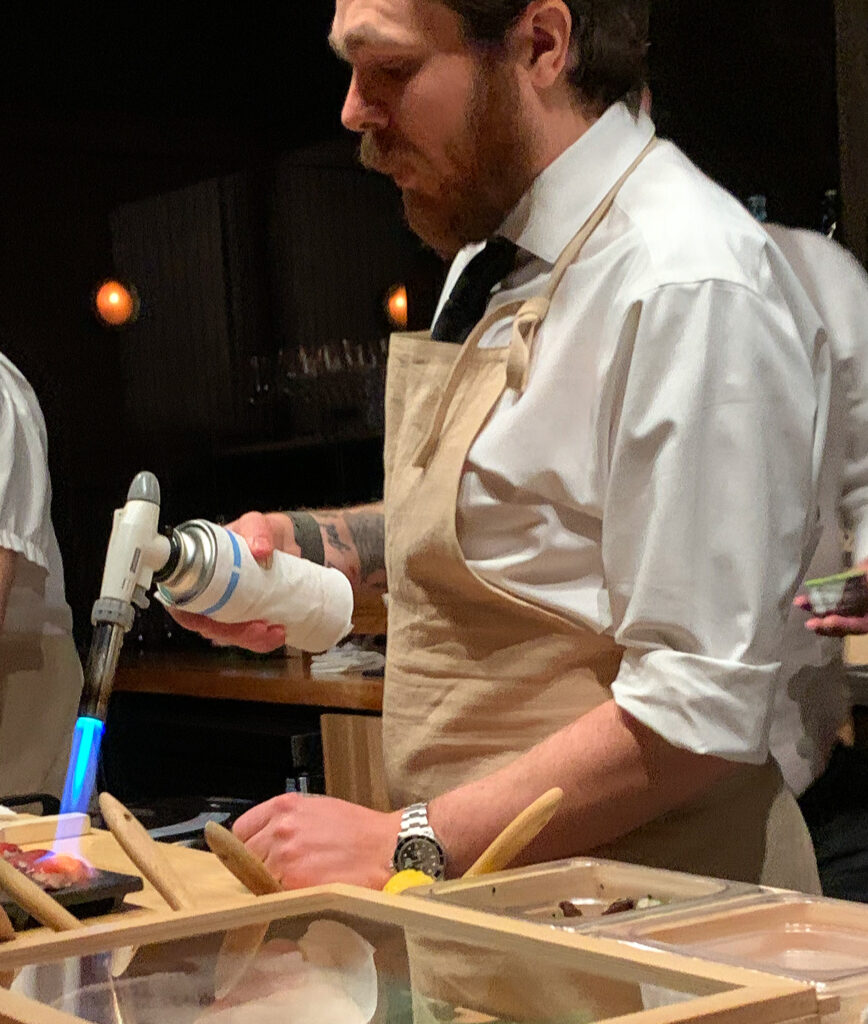
In this role as an evangelizer of omakase, Lee is a singular talent. He opens the door for so many more people to appreciate this craft and, if they so choose, climb the ladder toward visiting places like Kyōten one day. He privileges, even if the nigiri is unconventional, the social bonding and storytelling that make the form so transcendent. Thus, you must acknowledge that Lee is a maven of hospitality, and you must admit that you end this review feeling far more warmly about the man than when you started. He’s an unerring mascot for the Sushi by Scratch Restaurants brand, a savvy media manipulator that is not afraid to make fun of himself and who, truly, loves being behind the counter. Lee would surely grow to be one of Chicago’s most colorful chef personalities, but he won’t.
Lee got the restaurant off the ground, secured all the opening hype, and has left to continue building his empire. His understudies do not only fail to put on even half as good of a performance as he did, but the quality of the food has dropped noticeably too. It is unclear if Lee will ever return to lead the counter again (and, if he did, how could the restaurant fairly sell reservations for what would certainly be a limited affair?). Sushi by Scratch Restaurants offers a much different experience in the founding chef’s absence, and all the concept’s opening momentum must be checked.
On the basis of your first two visits, Sushi by Scratch Restaurants could make a case for deserving Two Pineapples. The overall experience was not as strong as The Omakase Room, but Lee’s performance clearly surpassed that of Chan and Kitano with his connection to the audience being among the best of any chef in Chicago. This human element, in your opinion, is harder to master than the food (which can grow immensely so long as one honestly engages with their craft each day), and that is why you prize it to such a degree.
However, on the basis of your third visit, Sushi by Scratch Restaurants could possibly deserve Zero Pineapples. The understudy chefs, while nice, were totally uninspiring (and just about as boring as any garden variety itamae you would find at a more “traditional” concept around town). The food, despite a few impressive bites, was far sloppier and often bland. The concept totally leaned on the coolness of its ambiance to impress its guests, and, when you consider possible pitfalls like the $85 supplement and the other add-ons at the end of the meal, it could even be termed predatory. At the very least, the experience would be best described as dumbed down sushi in a sleek setting that lacked heart or soul.
Chicagoans need to beware that the Sushi by Scratch Restaurants they visit today is a pale facsimile of the version Lee opened. You are not sure anyone could put on as good of a show as the founding chef (though it is worth remembering that his brother, at the Montecito location, is the one who earned a Michelin star). However, in his rush to expand, Lee has certainly compromised on the level of talent he is leaving to actually run these properties.
Still, you have not written off the understudies entirely. They deserve a chance to make the counter their own, and they are working within a framework that—if executed properly—has a proven track record. You think Sushi by Scratch Restaurants may still hold some appeal as a sort of “baby’s first high-end omakase.” It may even prove essential as a means of bringing, by offering the thrill of a festive night out, sushi skeptics into the fold. Thus, in the final analysis, the restaurant forms a good addition to Chicago’s dining scene. It just will not—or cannot—aspire to more than that.
